8 Link Building Services You Can Trust (2021 Review Guide)
We've created a list of eight link building services you can use to get high-quality backlinks in 2021. If link building is on your agenda for this year, you’re going to Read More...
In this guide, we’re sharing 3 tactics for white hat link building that won’t break the bank.
If you’re starting out with link building, you’re going to need this guide.
Here’s what you’re going to learn:
Let’s get into it.
If you know a thing or two about link building, you’ve probably heard of how time consuming and demanding it can be.
However, no matter how hard it might sound, link building is actually one of the most efficient ways to grow your organic traffic and get results from organic search faster.
In fact, according to a 2019 survey by SparkToro, most SEO professionals still believe that the quality of linking websites – AKA referring domains – is one of the most prominent ranking factors.


At the same time, according to a 2020 study of 11.8 million search results by Backlinko,
“A site’s overall link authority (as measured by Ahrefs Domain Rating) strongly correlates with higher rankings.”


What does that mean?
Well, practically it says that links matter a lot when it comes to getting organic traffic.
Also, when it comes to search engine optimization (SEO), one of the most prominent activities is link building.
In this post we’re focusing solely on white hat SEO tactics, and particularly on white hat link building.
The reason we’re focusing on white hat link building, although we’re also showing you how it differs from grey and black hat link building, is simple.
White hat is a legally not objectionable SEO tactic which boosts higher and more positive ratings by search engines.
Put another way, white hat is an efficient and ethical way of working within search engines’ conditions of acquiring higher visibility and getting higher search engine result page (SERP) positions.
We could say that white hat methods are the heroes; the good guys that can help you improve your search engine rankings while respecting the ranking factors search engines are looking for.
An example would be to look out for broken links on other websites.
After having identified any broken links, you can reach out to the person that had initially published them and let them know about it.
This will also give you the chance to suggest they should replace their broken links with links back to your content that might be similar.
Another example would be to promote an infographic that you’ve created to relevant websites who might be interested in featuring your visualisation in one of their posts and linking back to your website.
For example, let’s say that you’ve published an infographic on your blog and want to start building links back to the page where the infographic is.
It only makes sense that you’ll find relevant websites that talk about this topic and reach out to them, e.g. to the webmaster of the website or someone with editorial access to the blog, and ask if they could take a look at your infographic.
The purpose here is to ask for dofollow links, which are the opposite of nofollow links, and help your page get the attention it deserves as well as acquire some referral traffic, if the linking page has traffic of its own.
As you’ll see when we get deeper into the three different white hat link building tactics a little further down in this post, white hat is all about targeted prospecting, crafting a personalized pitch, and managing the outreach process end-to-end.
To cut a long story short, outreach helps you find and acquire high-quality links from high authority websites.
Getting relevant links from websites that have a high domain authority (DA) can lead to increasing your overall domain authority and, as a result, getting you more visibility on the SERPs.
Let’s now discuss how white hat tactics differ from black and grey link building techniques.
As we’ve already discussed, white hat techniques are, to put it simply, the ‘good’ ones.
The tactics that, although demanding, can help you rank higher organically and in a Google-approved way.
Let’s now discuss grey hat link building.
Grey hat link building is basically a combination of techniques that are white hat, so approved by the search engines, and others that are not the worst things you can do but are still manipulative and might put your business at risk.
In a few words, grey hat link building strategies might get you in a little trouble, although they’re not violating Google and Bing’s guidelines as much as black hat techniques do.
Some examples of grey hat link building techniques are:
How about black hat link building?
Black hat SEO is that type of SEO you should try to stay well away from as it could lead to your business getting severe penalties from the search engines.
In some cases, the effects of such a penalty for your business may be permanent.
In one sentence, black hat tactics violate search engine guidelines.
Let’s take a look at what Google considers to be a violation of their guidelines.
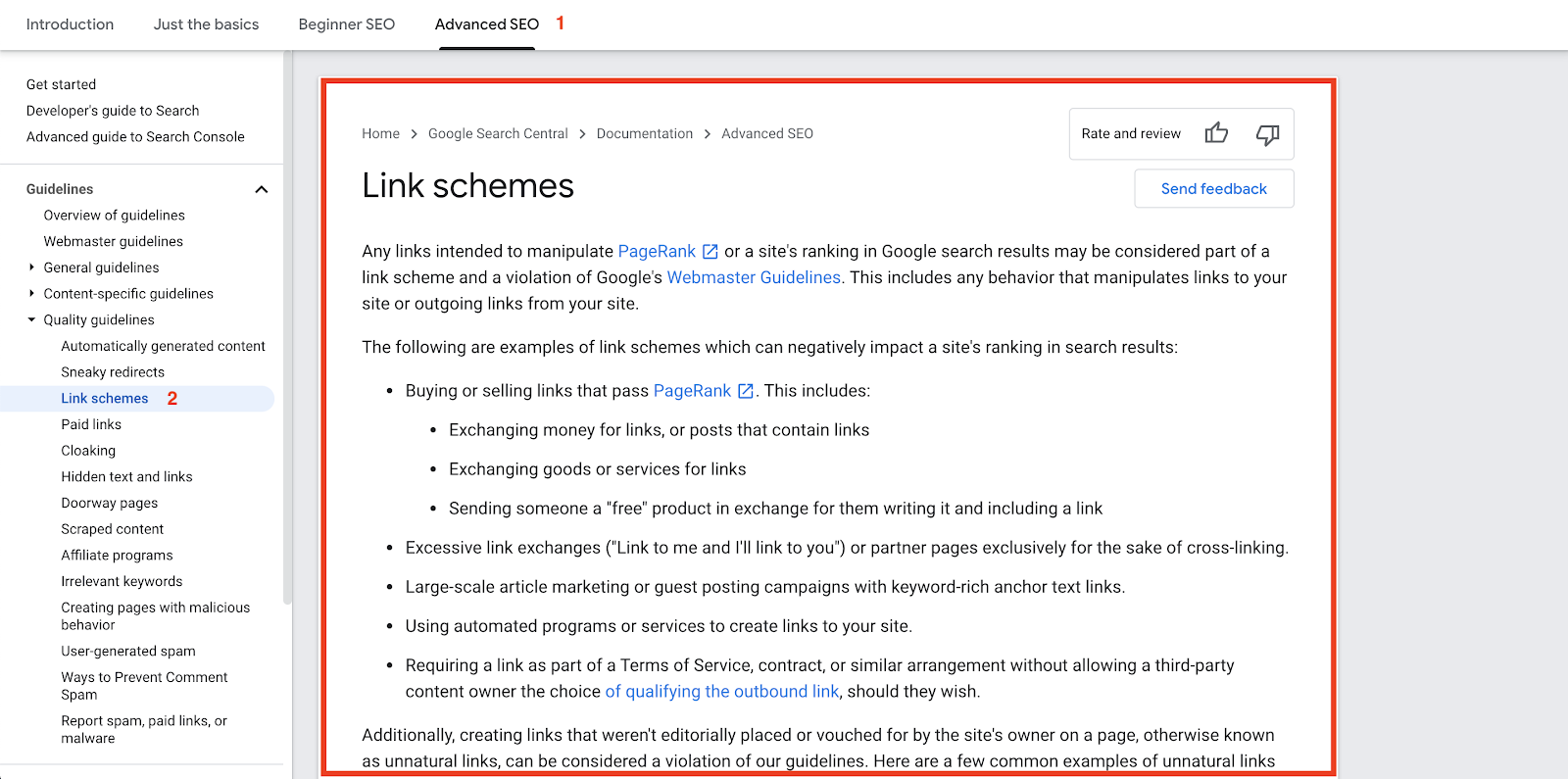

Author’s Note: To access the above page, you need to visit Google’s Search Central and from there click on “Link schemes”. This is part of Google’s “Advanced SEO”, but is enough to help you understand which practices aren’t accepted by Google when it comes to link building.
Here are a few examples:
We understand that marketers and business owners might desperately want to boost their company’s backlink profile, but they should also be aware of the risks.
Overall, using black and grey link building tactics and SEO strategies can be risky for your website and affiliate sites.
Professionals and brands who employ such tactics and methodologies may get away with it for a while, but sooner or later things will come out and, in many cases, this may result in huge traffic, revenue, and job losses.
Whether you’re doing your own SEO or working with an SEO agency, keep in mind that Google’s algorithms are only getting stricter and smarter when it comes to the tactics one uses to get higher visibility and acquire links.
Moving on to our white hat link building strategies.
We’ve now established that black and grey hat link building can be far more effective and sustainable than other tactics.
Let’s now get into how you could achieve white hat link building by using the power of guest post outreach.
In this section we’re taking you through the process of prospecting, or finding guest posting opportunities by reaching out to other websites, bloggers, and online media outlets.
Call it whatever you like.
Author’s Note: Online media outlets and publications are different from social media, where most links are turned into nofollow by default and therefore generally make little to no difference to your backlink profile.
For the sake of example, let’s say that we at Respona, are interested in doing guest posts to acquire white hat links for our website.
Therefore, we’re interested in finding websites that:
Additionally, we’re interested in writing about one of the following topics:
For the step-by-step process I’m about to talk you through, we’re using Respona as our outreach tool of choice.
The very first step is to start a new campaign.
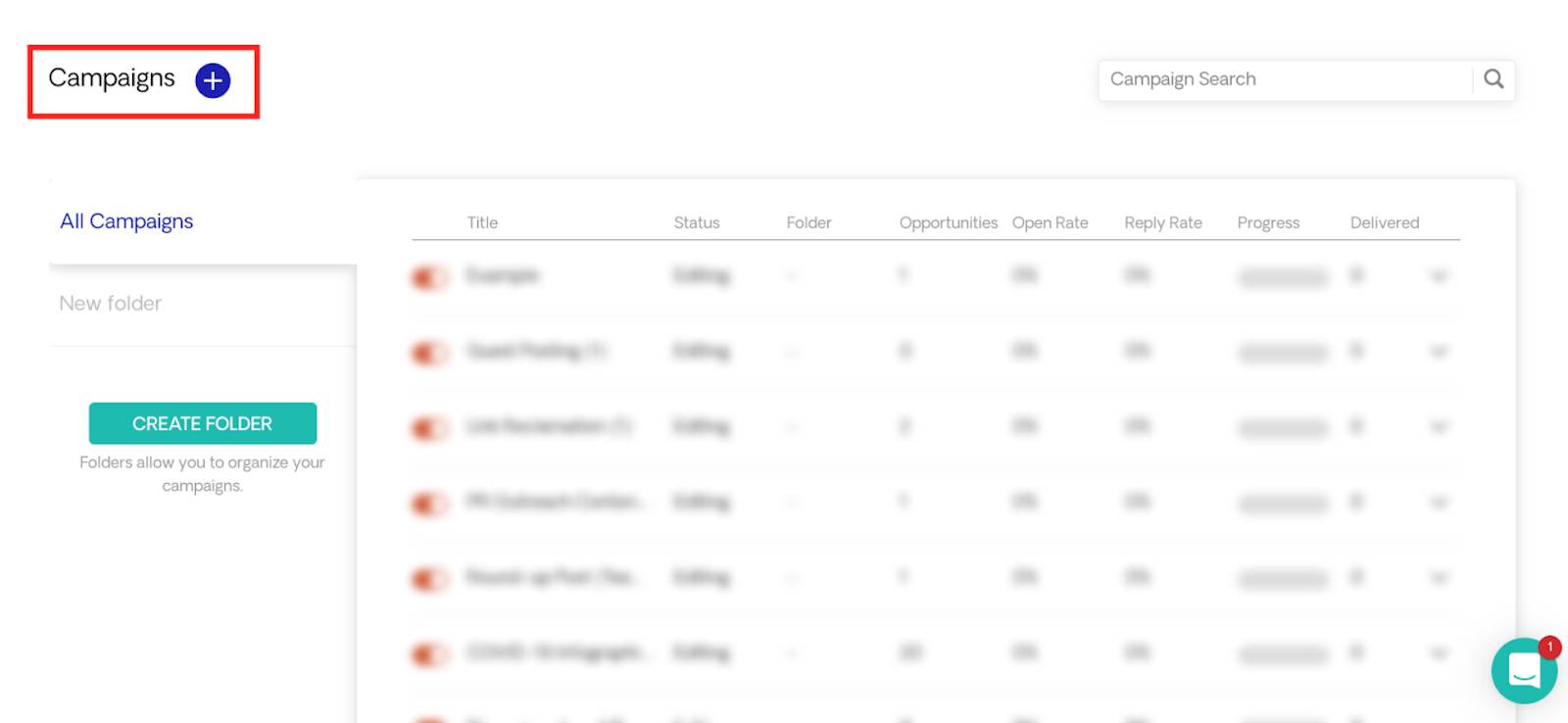

We then need to give our campaign a name.
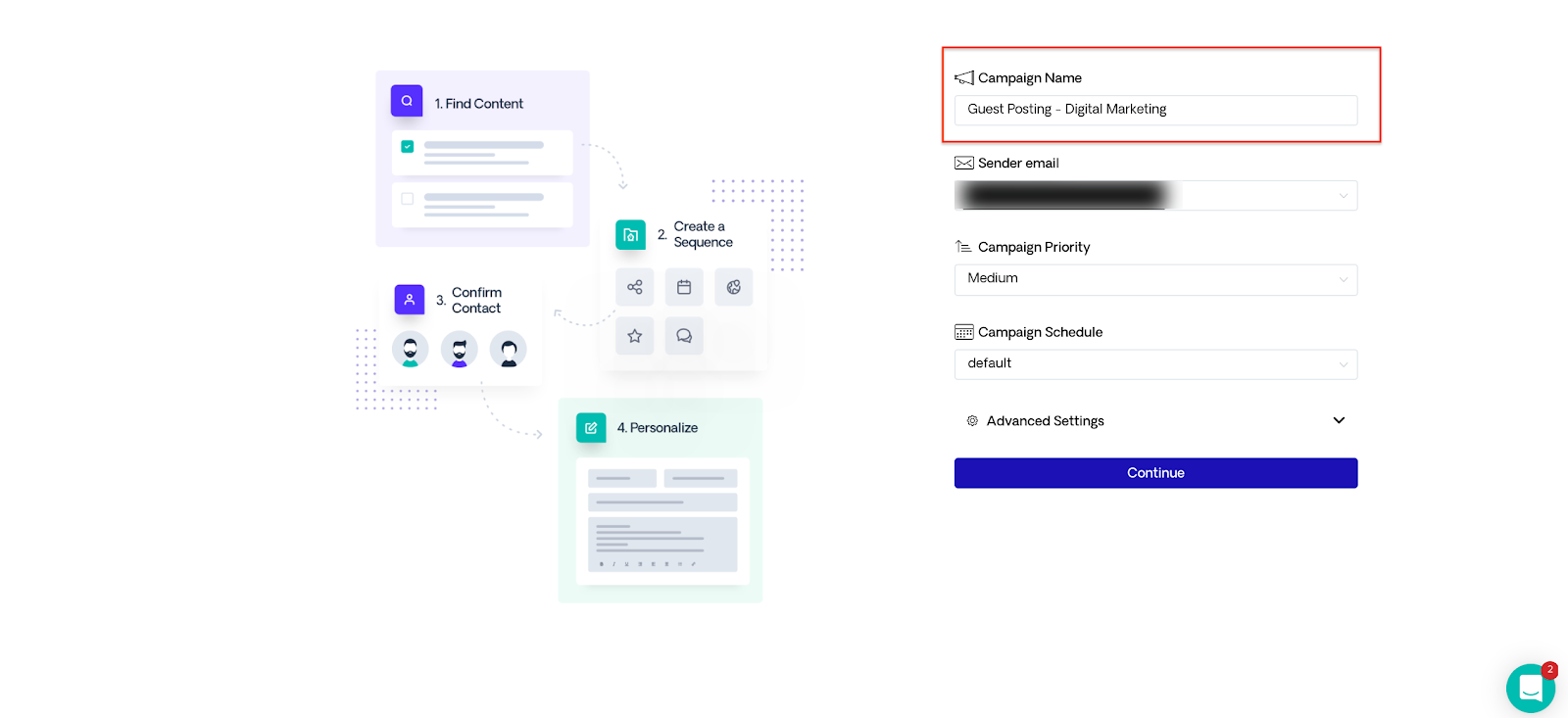

After having done that, we’re also setting up a campaign priority, exactly as shown below:


This is a new feature and can be extremely useful when creating a new campaign.
What’s great about it is that it helps you keep all the important stuff at the top of the queue, whilst still working on your other strategies.
When setting up your campaign, you can also take advantage of some additional settings.
The screenshot below shows you that you can use a new sending strategy that can totally help you maximize your reach for singular opportunities.
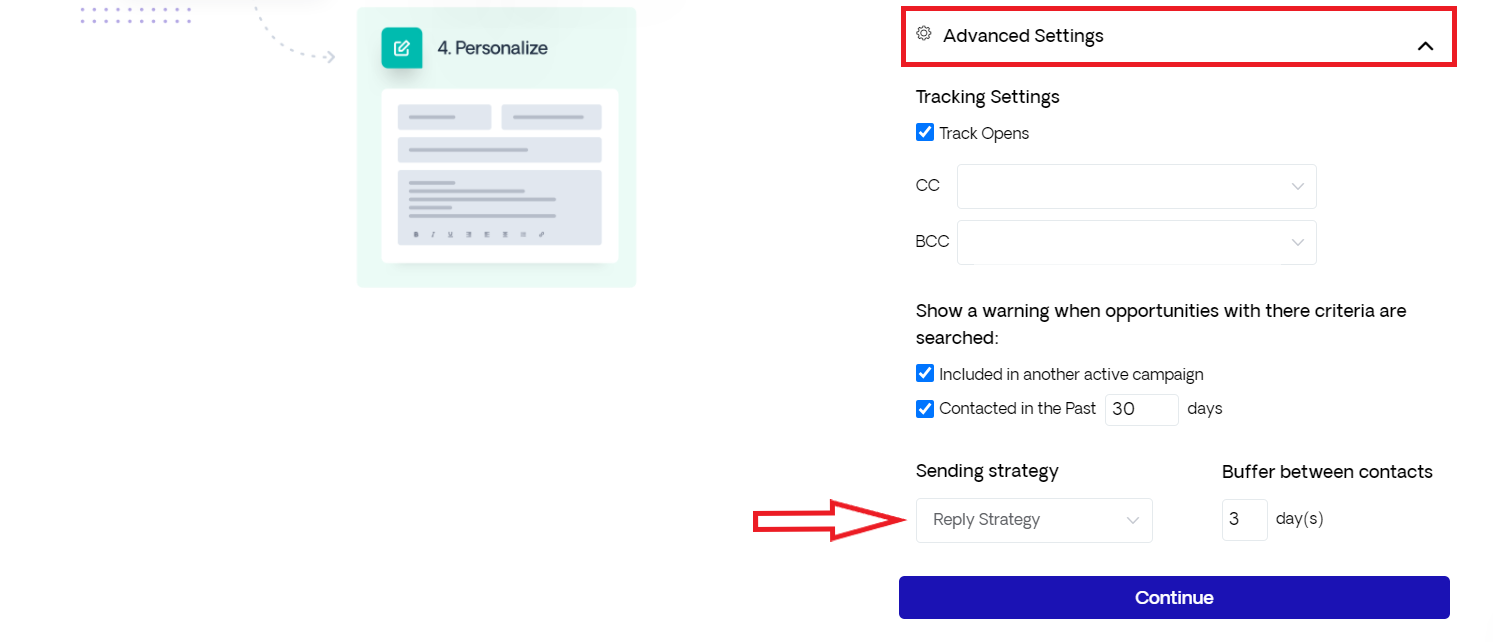

More specifically, by selecting the Reply Strategy, you’re basically asking the tool to reach out to your additional contacts in case the person you initially reached out to hasn’t got back to you within a certain timeframe.
Respona offers two options when building your new campaign.
The first one, as shown below, is to Search, using Respona’s built-in search engine.
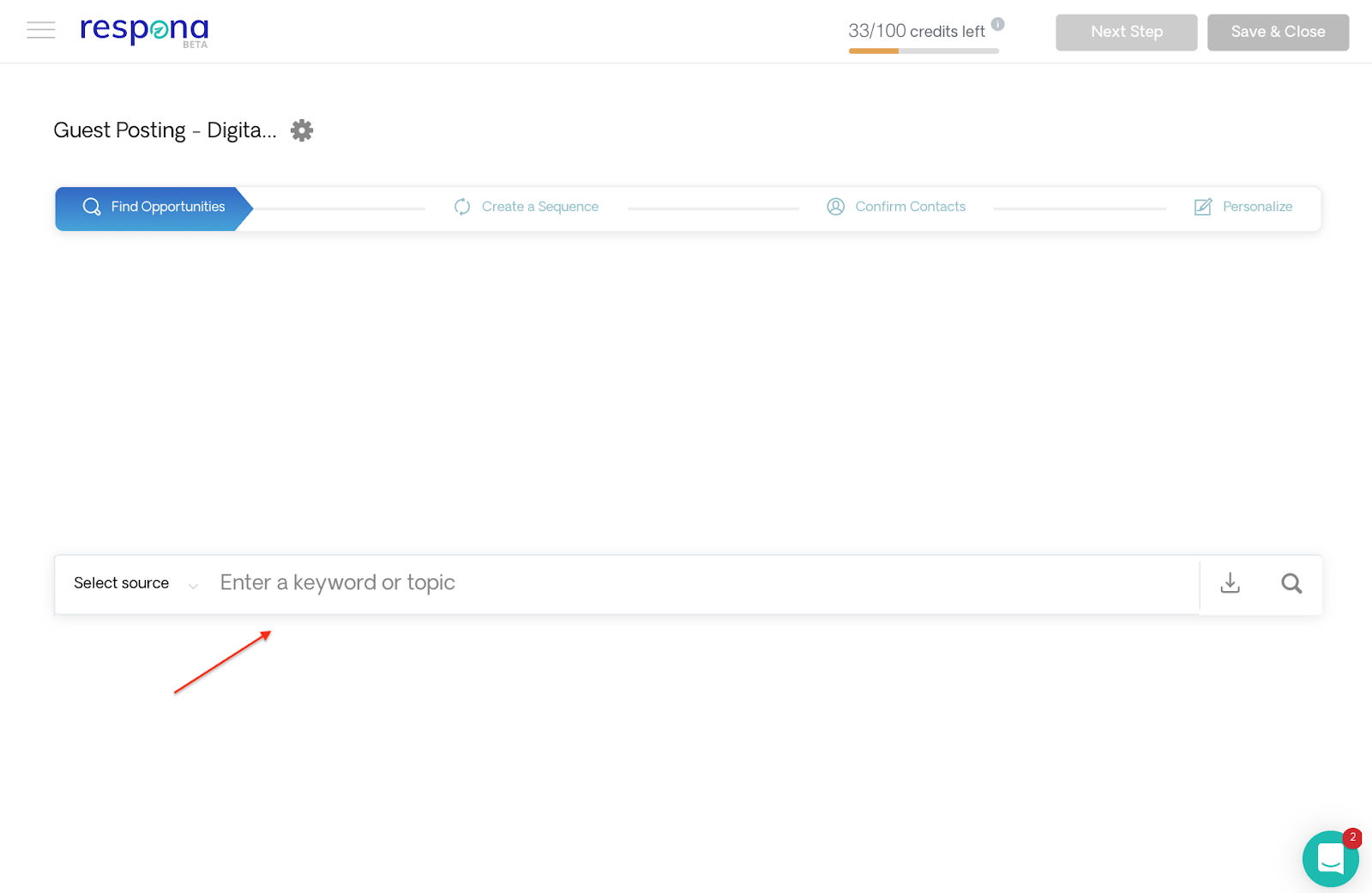

The second one is to import opportunities you might have already, possibly through a .csv file.


The great thing is that we can use both the search and import flows at the same time and by using the same single search bar.
This can save you valuable time and make the process easier.
We then go on selecting our search source.
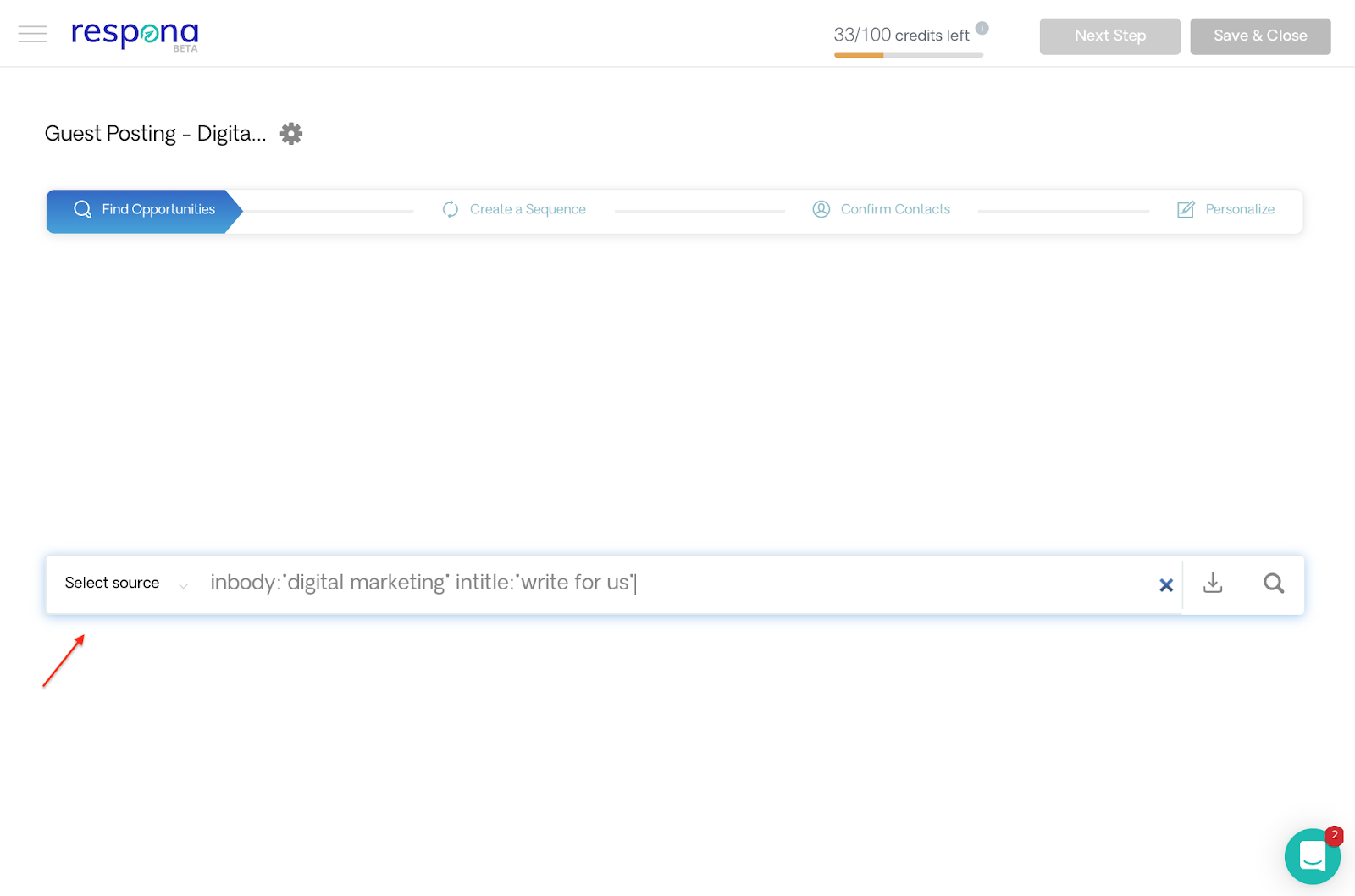

This step is important because the right search source will get us more relevant results in relation to what we’re looking for.
In this case, we’re going for the Web Search option.
That is, to perform a general search and include all search results.
Keep in mind that we’re also using a search modifier that’ll make our search more specific.
In fact, Respona offers a wide range of search modifiers that can be used to help you specify your search.


When moving to the next step, you have the option to add filters to your search.
The options in terms of the filters are the following:
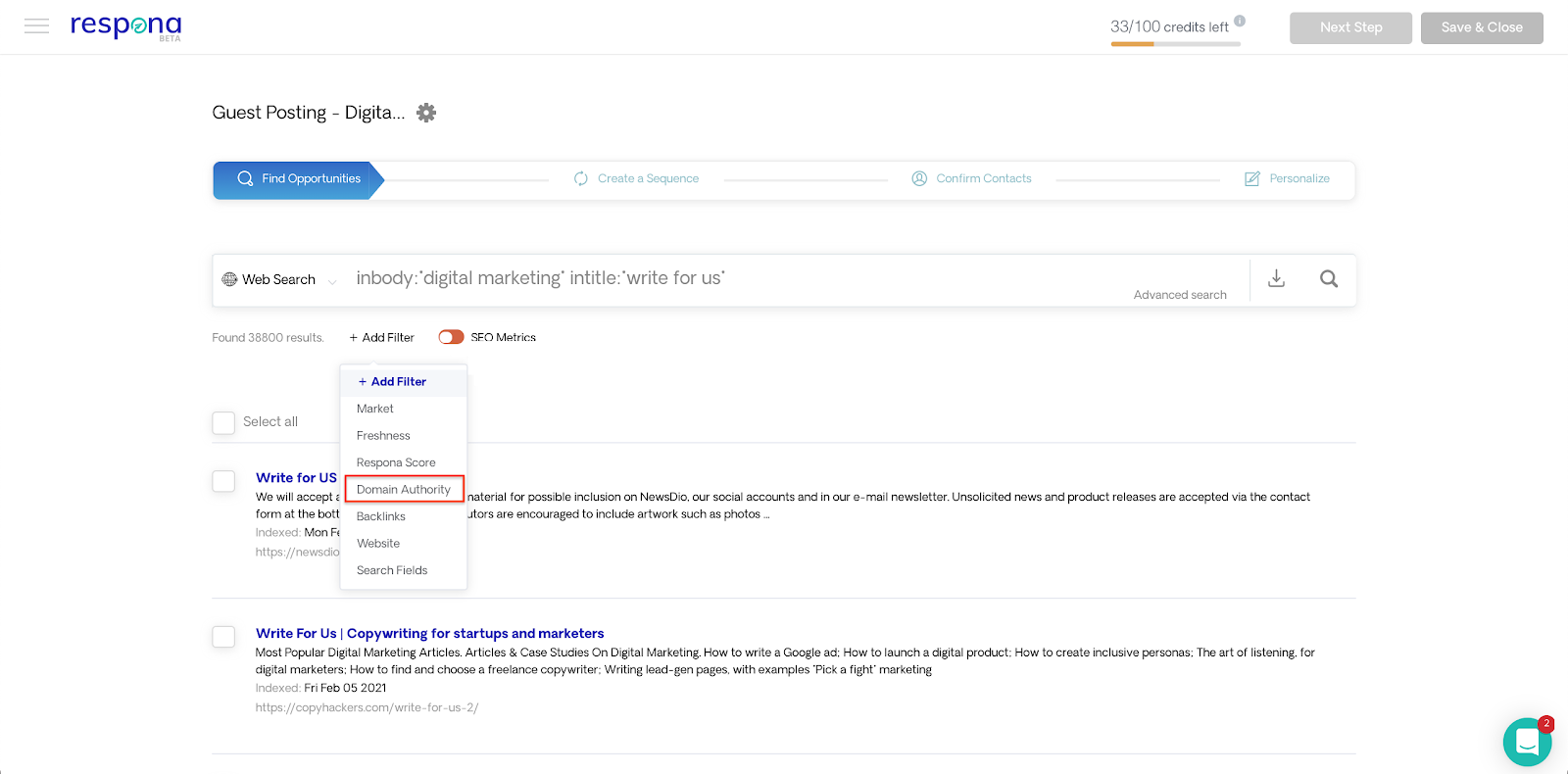

Given the nature of our search, we’ve selected the Domain Authority filter and we’re also setting up the DR of the results to be anywhere between thirty and one hundred.
Additionally, we’re enabling the SEO metrics to better define our search.
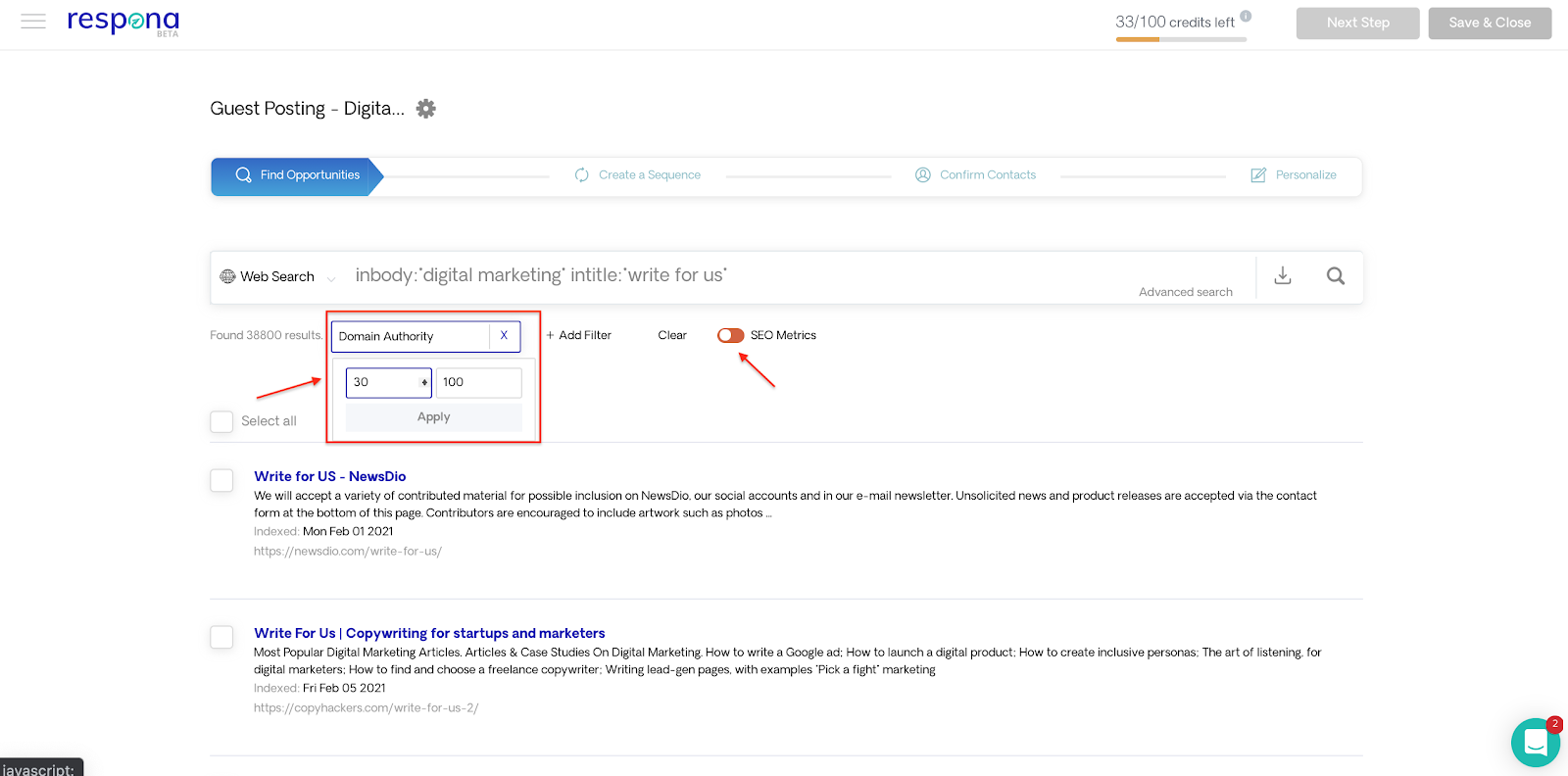

Our search got as many as 38,800 results.
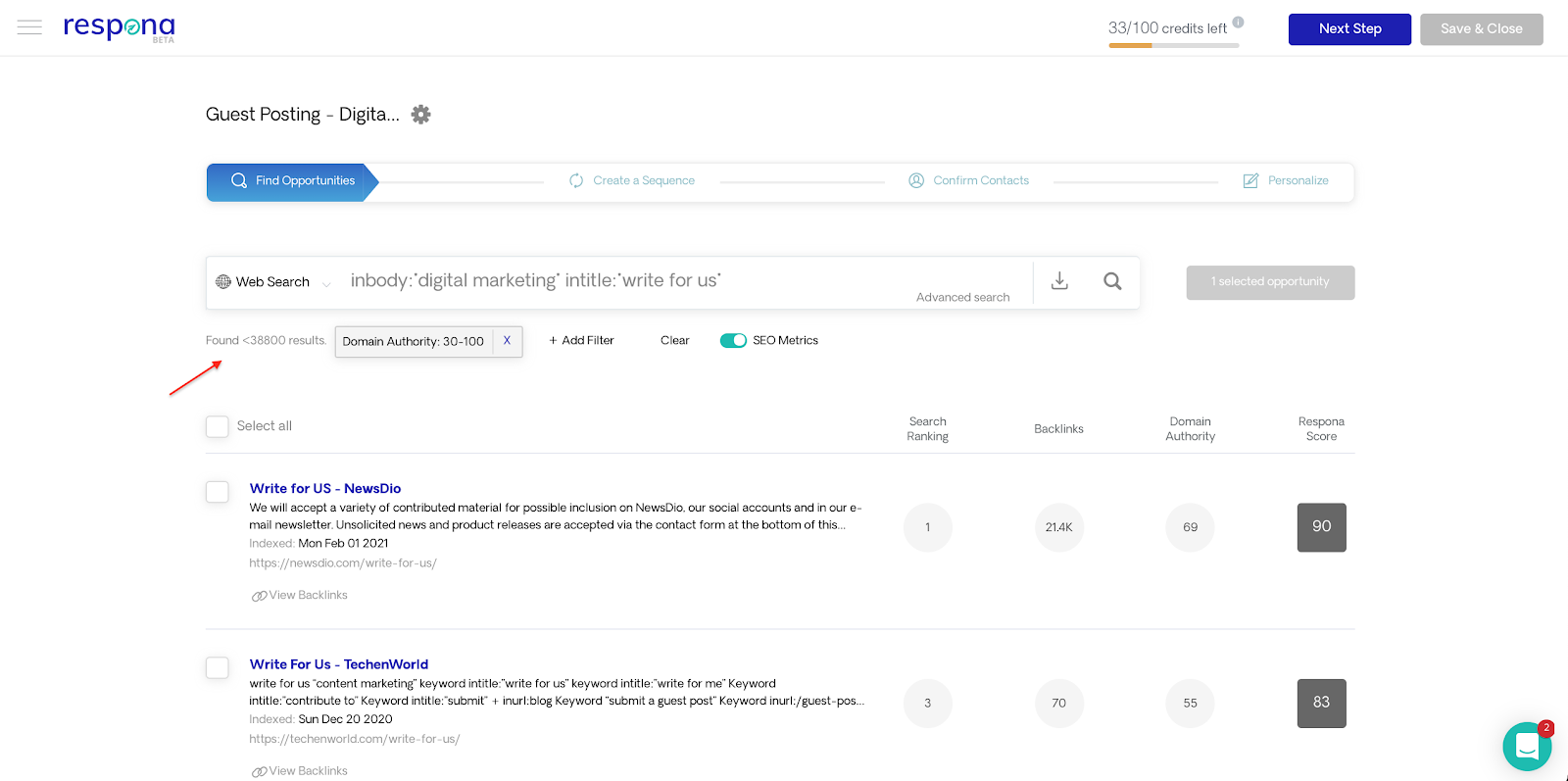

As you can see on the screenshot below, we’ve now got thirty opportunities selected while we can also see the search ranking, backlinks, and DR for each opportunity.
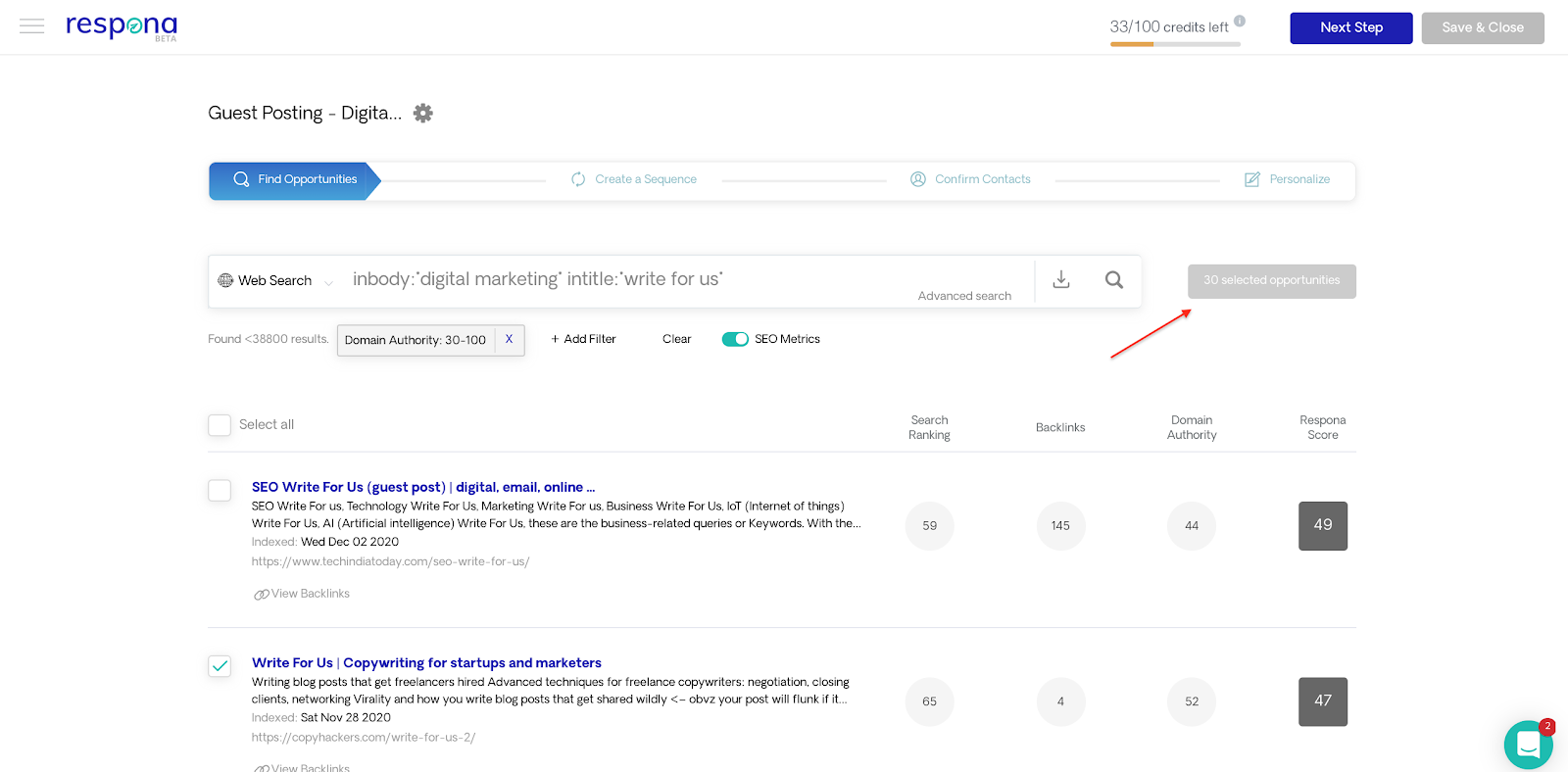

Author’s Note: These metrics are similar to metrics you can get from SEO tools like Ahrefs or Moz. They can help you qualify your prospects and choose only the ones that fit your specific criteria.
After having reviewed this, we press “Next Step” and move further towards setting up our campaign.
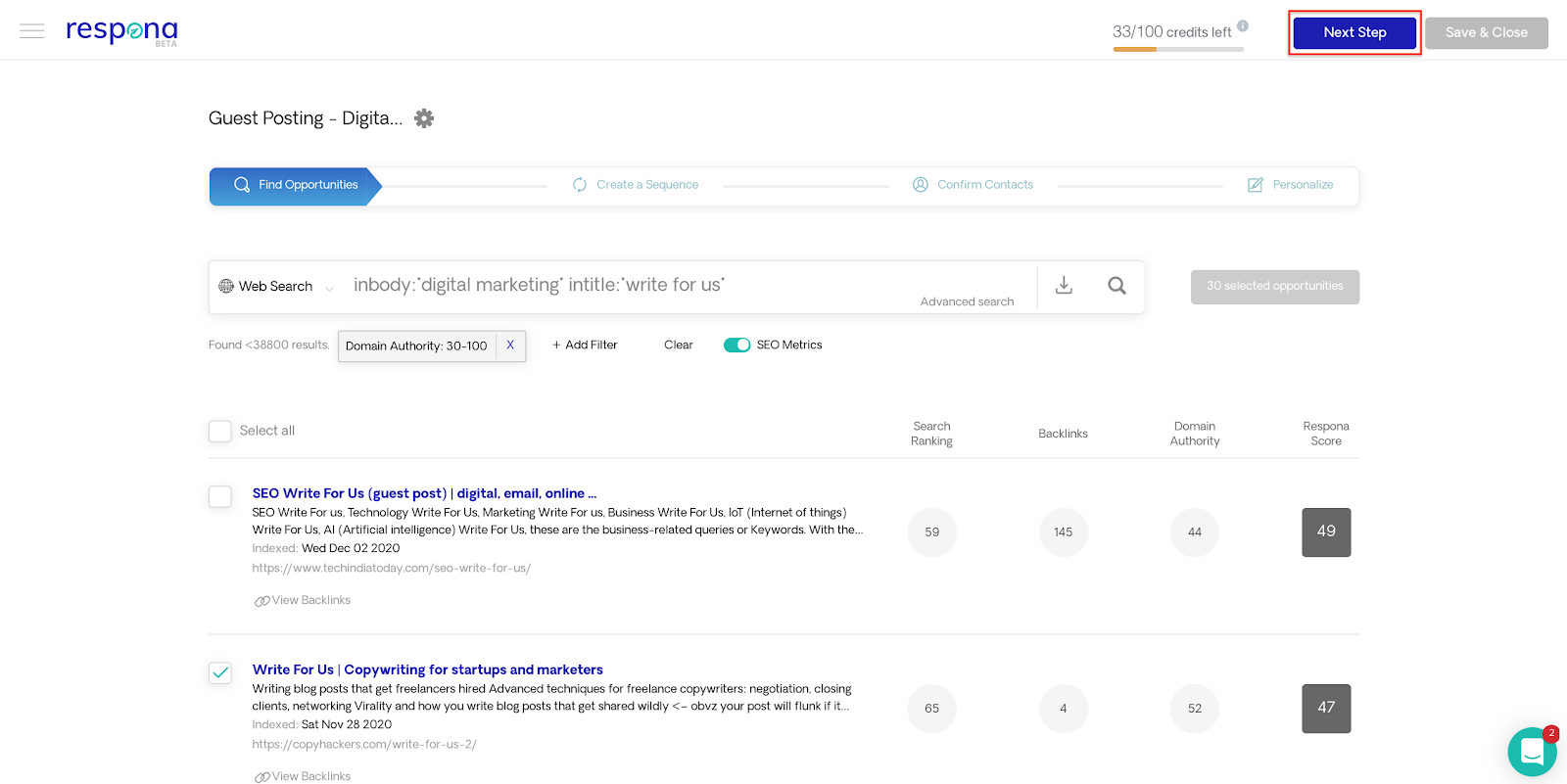

Respona offers a truly wide range of email templates depending on the reason why you’re reaching out to your prospects.
When creating your campaign, you can select one of the email sequences available.
In this case, we’ve picked the Guest Posting Sequence.
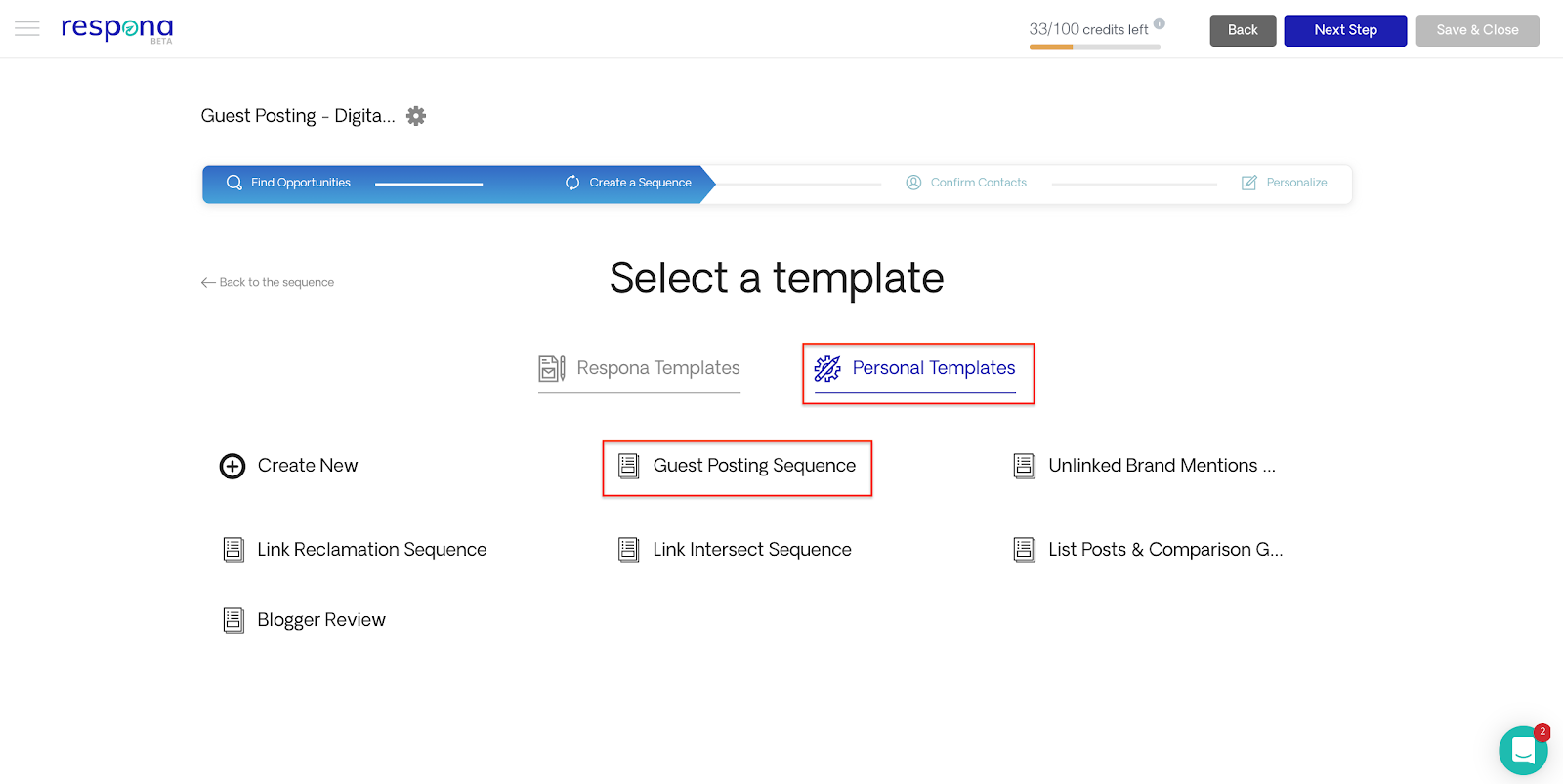

Here’s how your email sequence will look.
More specifically, your initial guest posting outreach email as well as your follow-up email, in case your initial email goes unanswered.


Have a look at the template we’re using here:
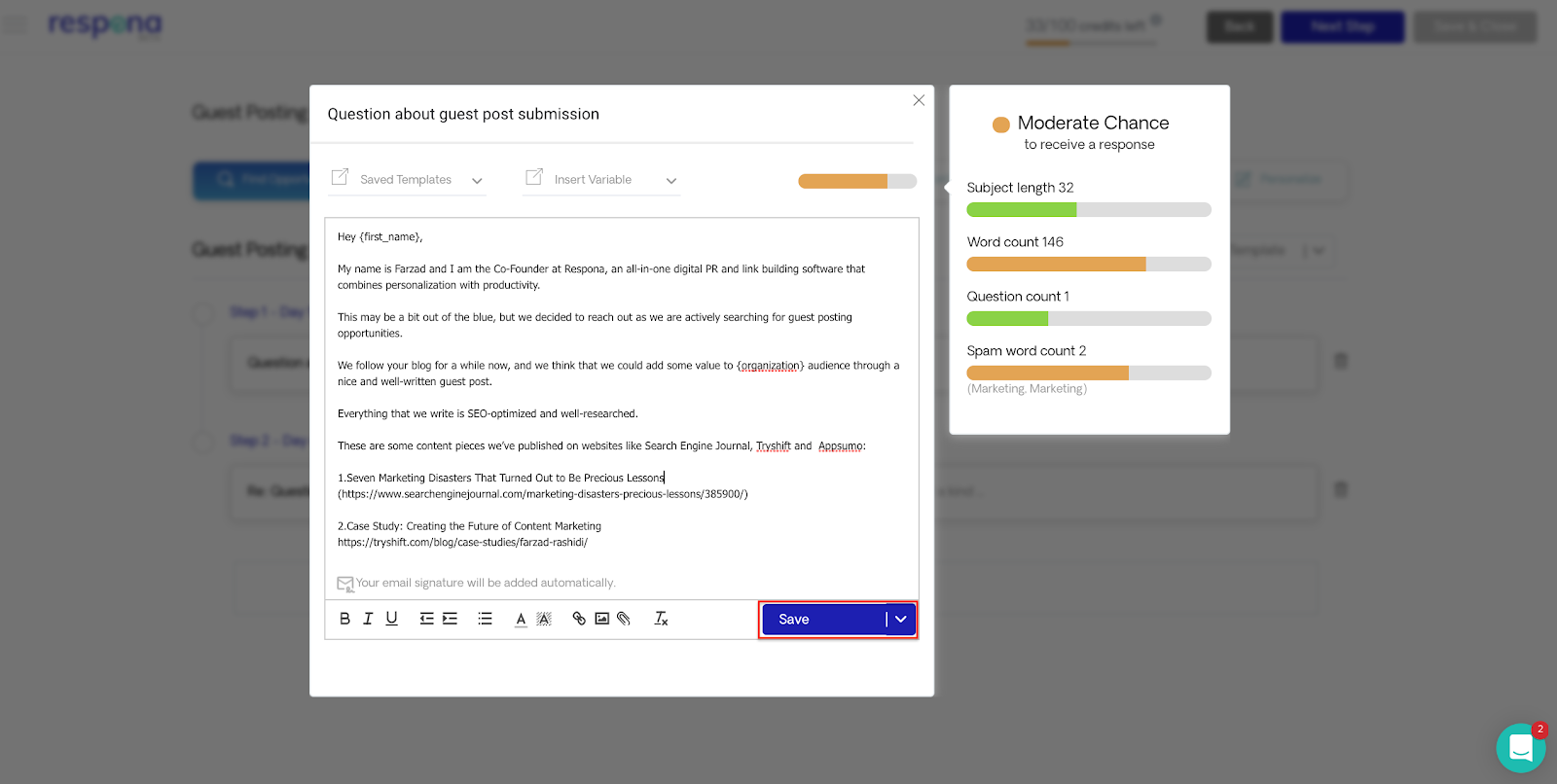

Here’s the full email template we’ll be using:


Subject Line
Hey {first_name},
My name is Farzad and I am the co-founder at Respona, an all-in-one digital PR and link building software that combines personalization with productivity.
This may be a bit out of the blue, but we decided to reach out as we are actively searching for guest posting opportunities.
We have followed your blog for a while now, and we think that we could add some value to {organization}’s audience through a nice and well-written guest post.
Everything that we write is SEO-focused and well-researched.
These are some content pieces we’ve published on websites like Search Engine Journal, Tryshift, and Appsumo:
1. Seven Marketing Disasters That Turned Out to Be Precious Lessons
https://www.searchenginejournal.com/marketing-disasters-precious-lessons/385900/
2. Case Study: Creating the Future of Content Marketing
https://tryshift.com/blog/case-studies/farzad-rashidi/
3. The Appsumo Guide To Cross-Functional Collaboration
https://blog.appsumo.com/cross-functional-collaboration/
Would you like to hear a couple of topics we have in mind for you guys?
Thanks,
Farzad
When preparing your email outreach using one of Respona’s templates, you also get insight on the chances your email has of getting read.
Have a look:
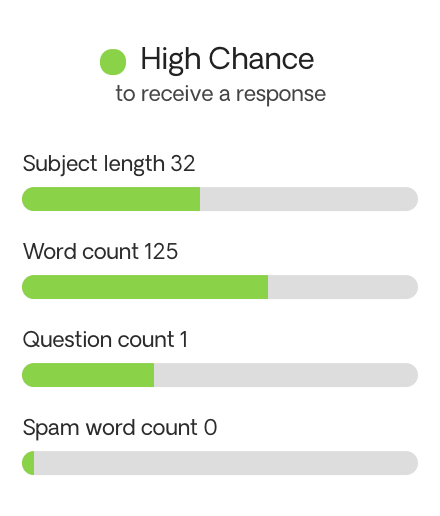

Your follow-up email can be found right under your initial email, as highlighted below:


Like before, we can also check the potential success rate of our follow up email.
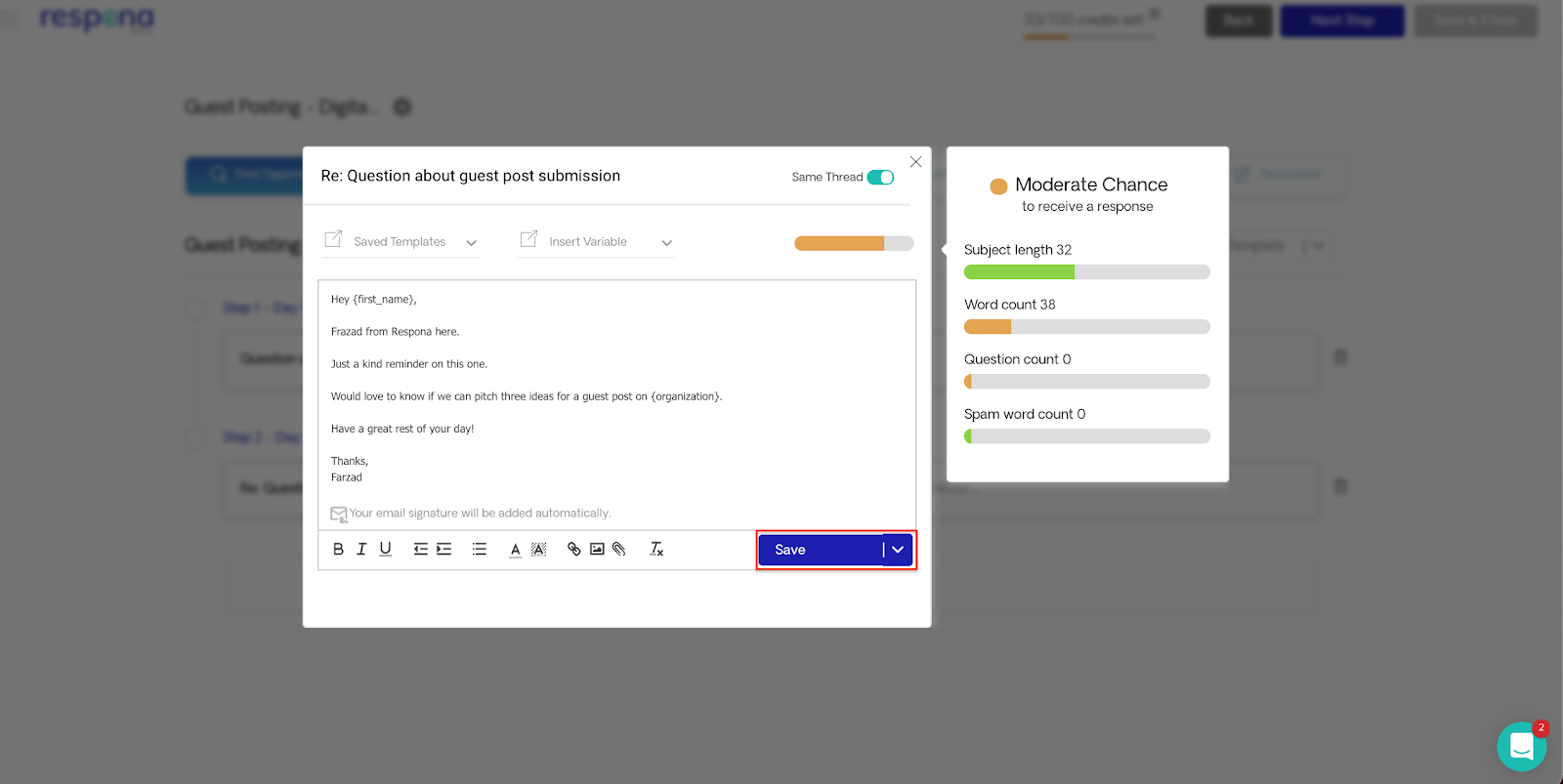

After having personalized your email sequence, you can get to the next step.
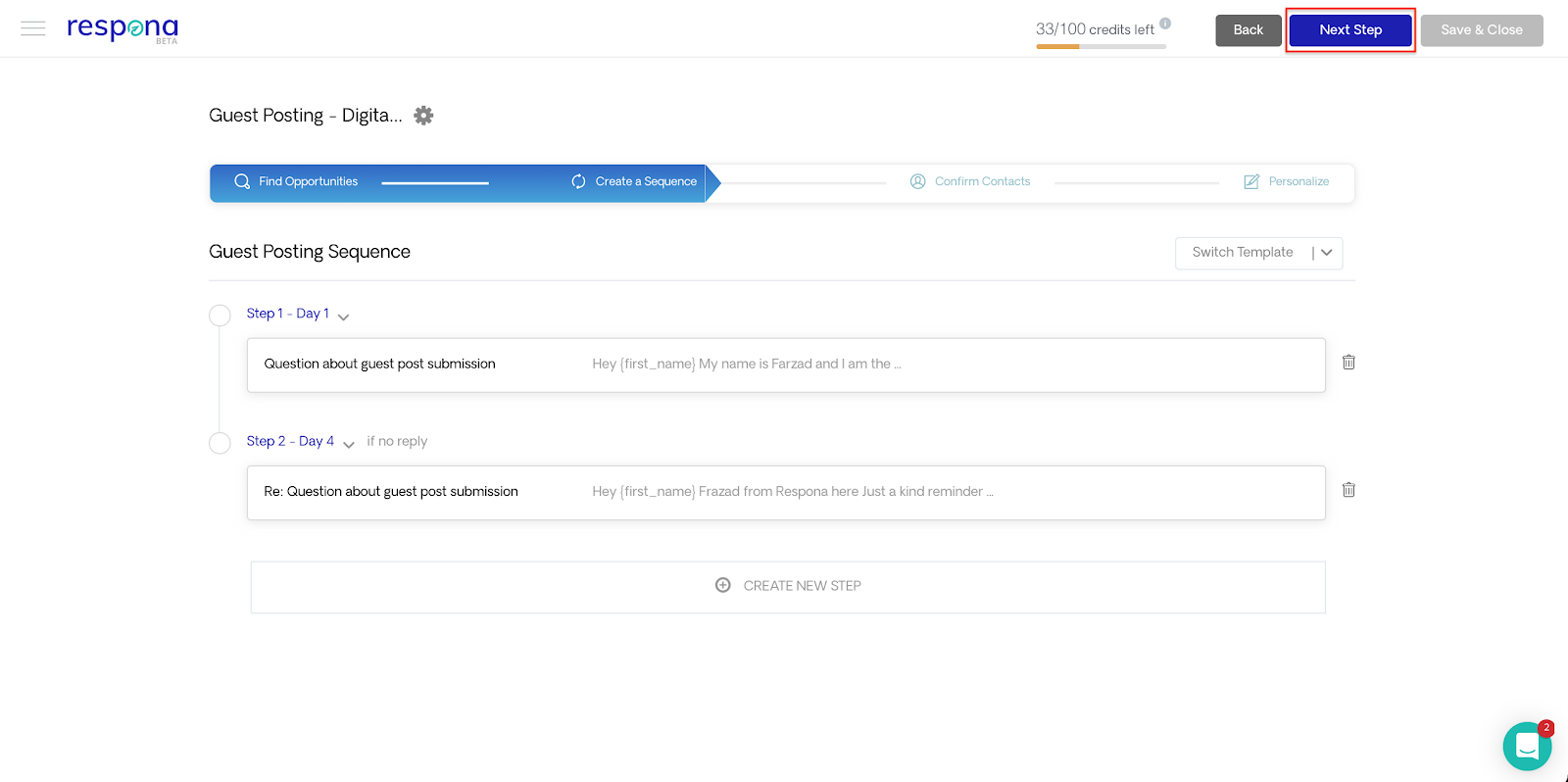

This step is about finding the right contact information for your prospects.
Respona will ask you whether you’d like the tool to assign additional opportunities to authors of URLs as well as whether there should be opportunities assigned to people who work for the companies associated with the article domain.
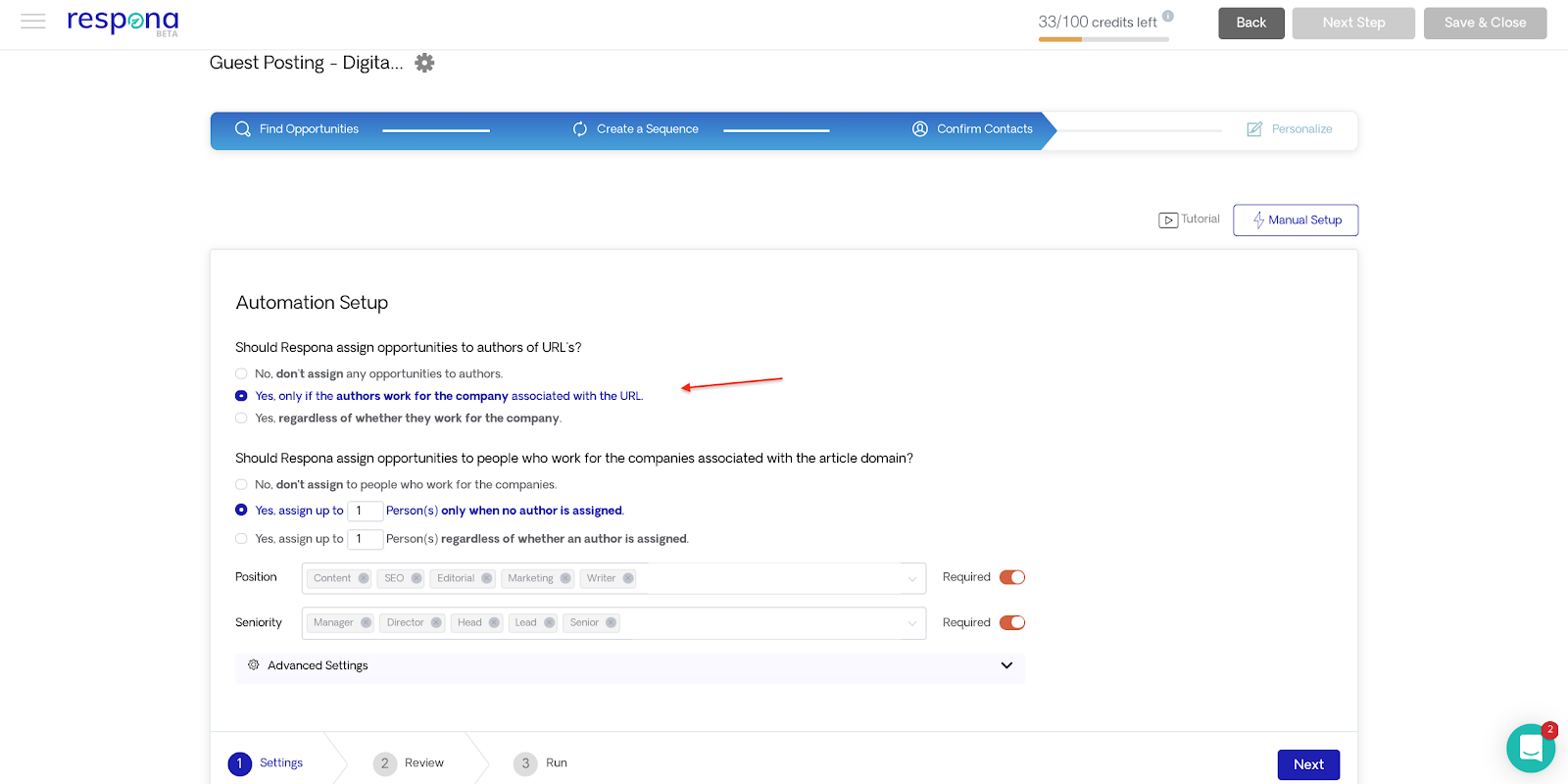

This is an important step because we’re basically telling Respona what kind of contacts we want it to find.
For the sake of our example, we’ve selected that we’d like Respona to assign opportunities to authors of the URL only if they work for the company associated with the URL.
Additionally, we’ve assigned an opportunity to one person in case there’s no other author assigned.
As seen below, this can be adjusted depending on your targets.


A rather important feature is that we can actually choose the position and seniority of people that’ll be searched from the tool.
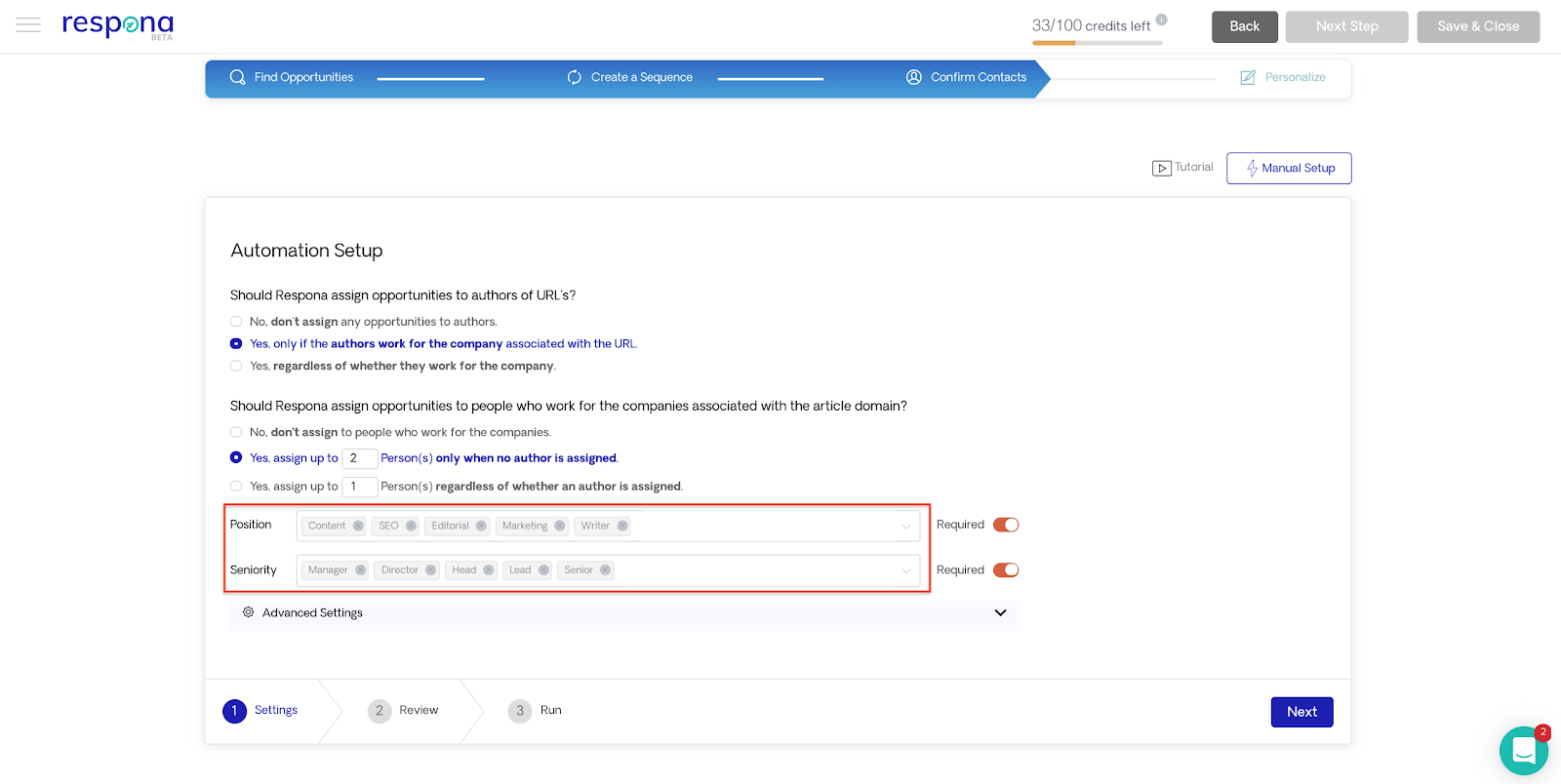

This increases the chances of getting more relevant results.
We’re then getting to our next step.
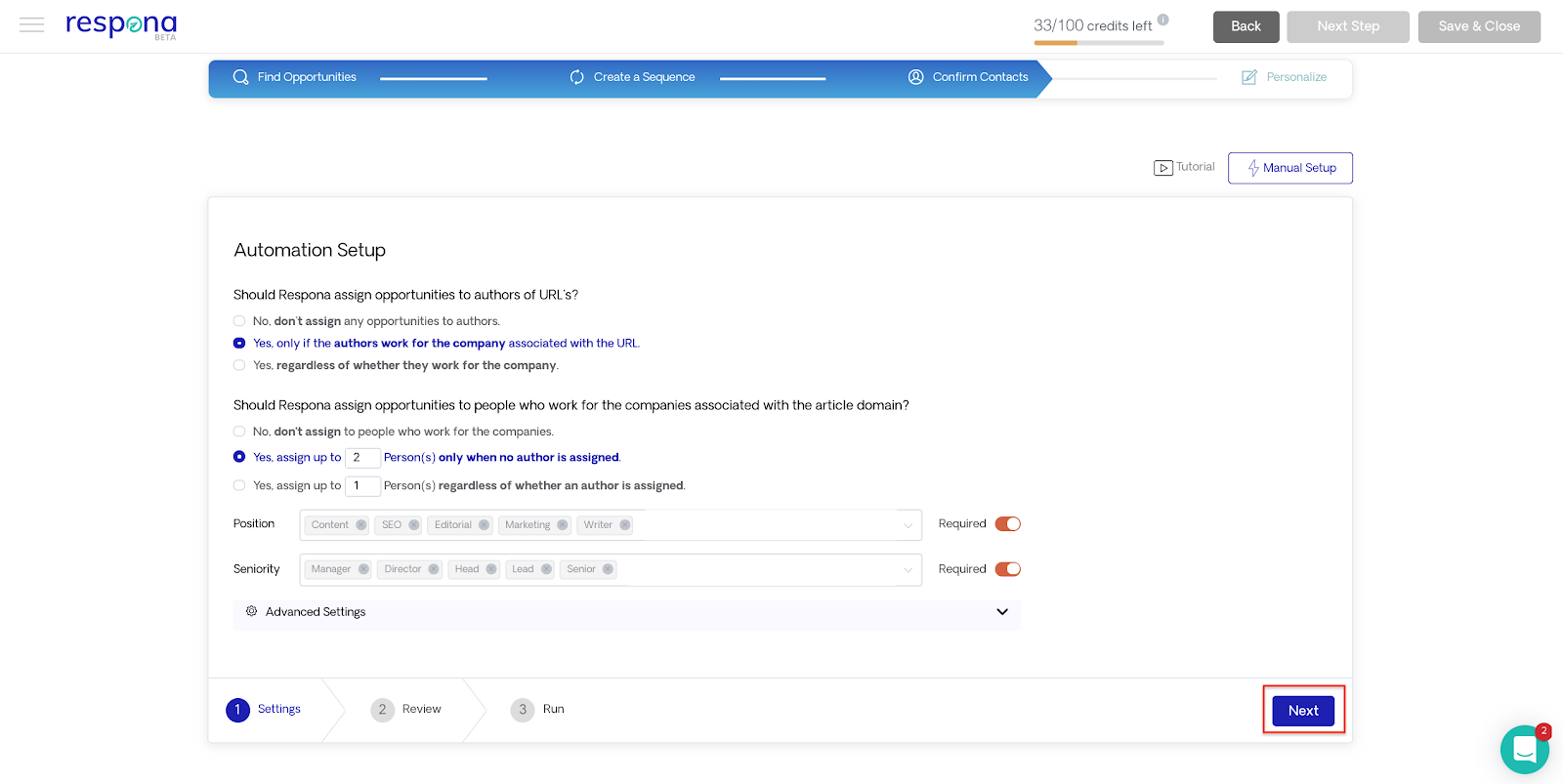

In the next step, we’re able to review our automations and get estimates on how long it’ll take for it to run.
At this stage, we have thirty unassigned opportunities, and Respona will need an estimate of sixty credit as well as seventeen minutes to find the contact information for our prospects.
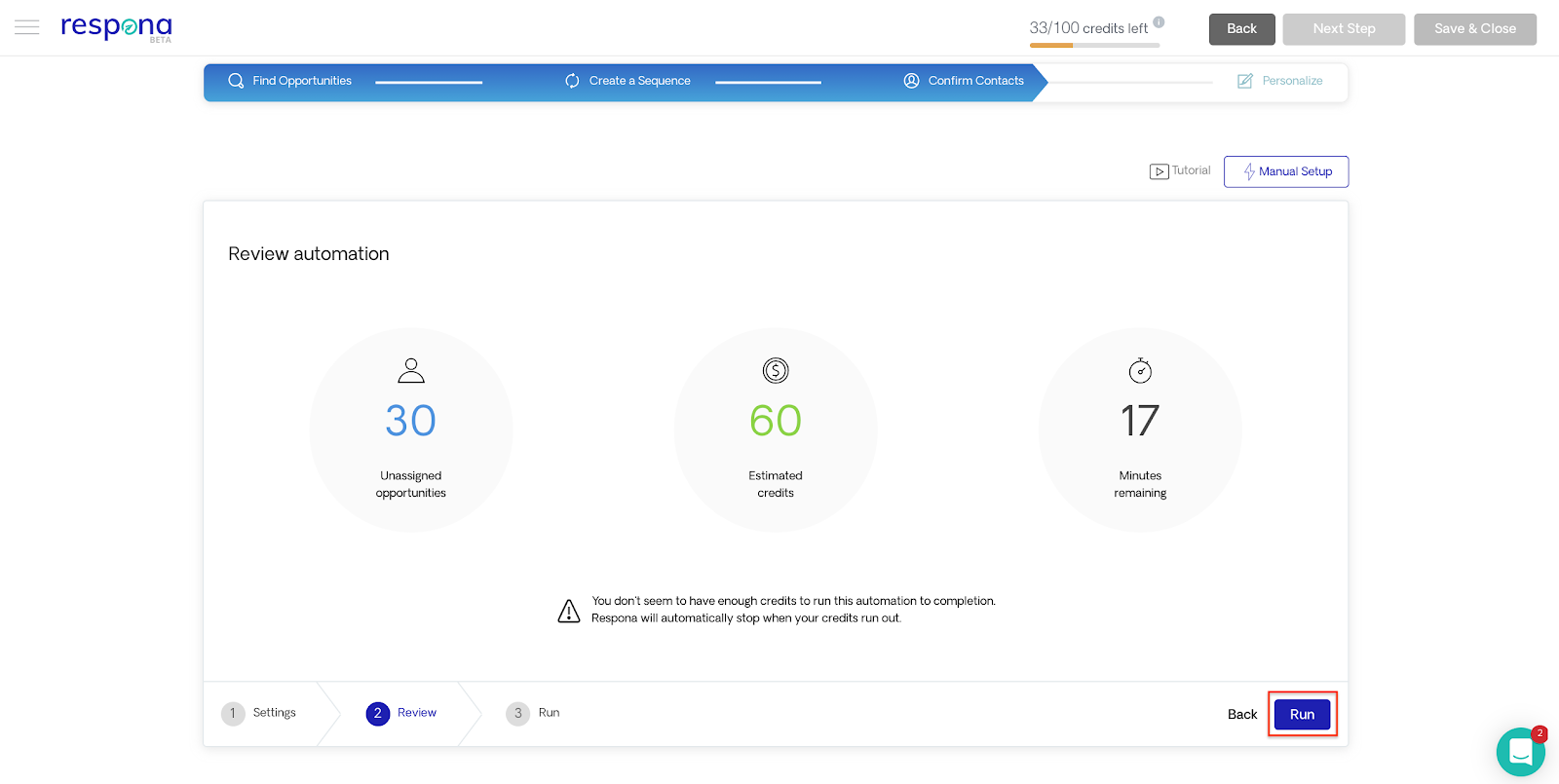

After we press the Run button on the right bottom corner, we’re getting our results.
It looks like twenty seven out of thirty opportunities have been successfully assigned, whereas three couldn’t be assigned.
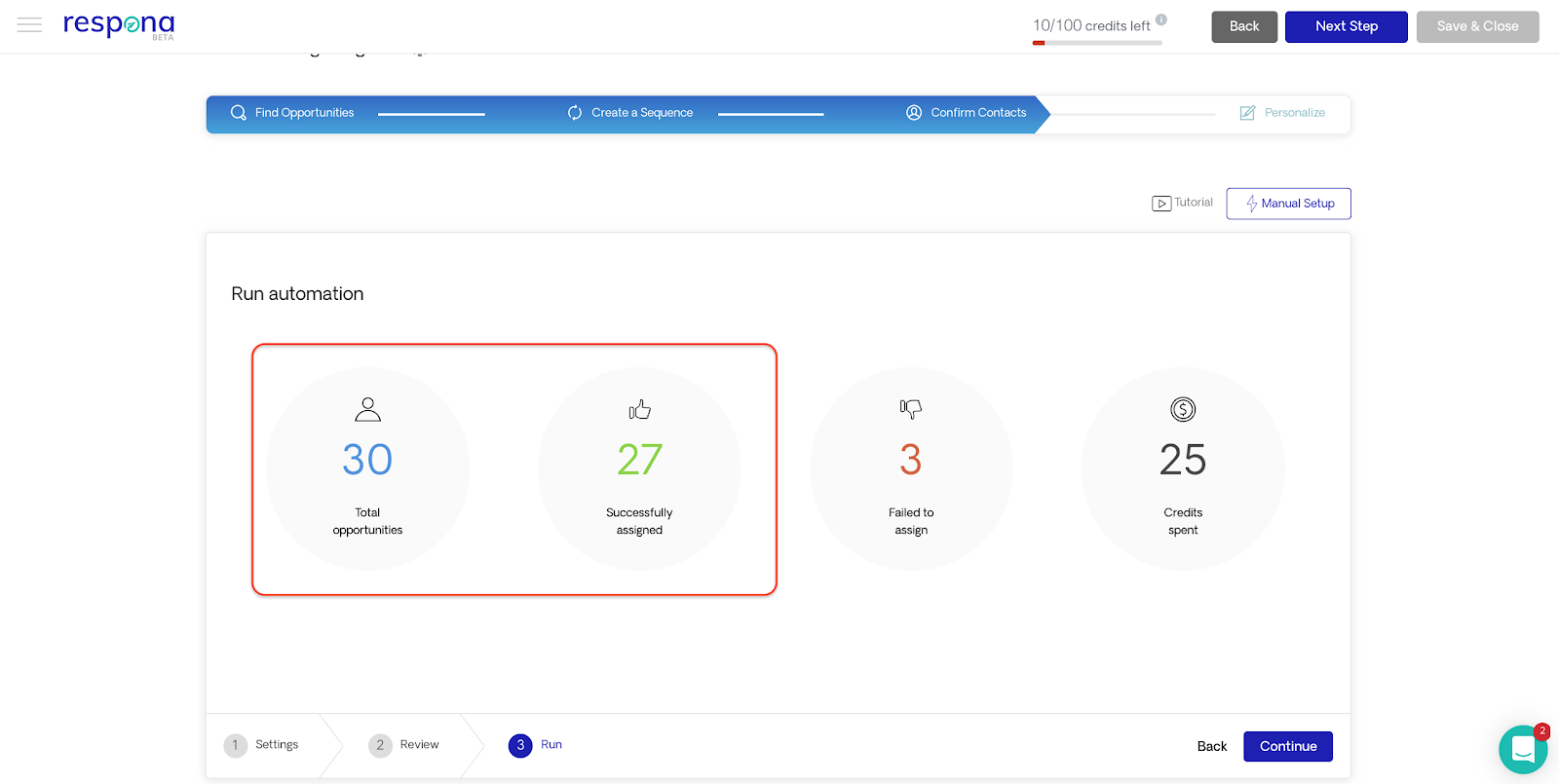

We then press “Continue”.
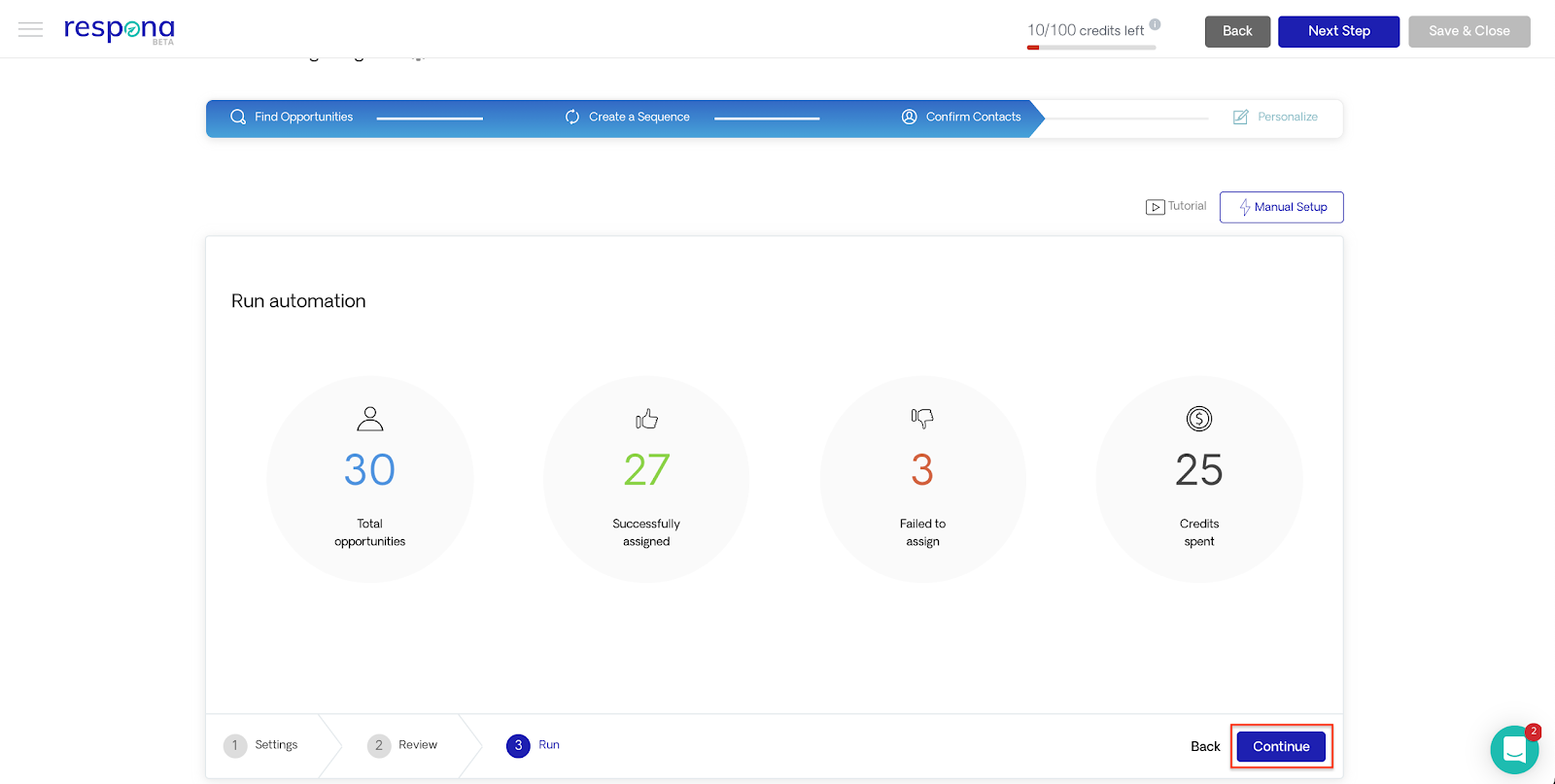

We now have access to a large amount of information in regards to our guest post outreach opportunities.
There are eighteen opportunities for which we have contacts and all the information we might need for a successful outreach.
Respona has found full names, job titles, company names, email addresses, as well as LinkedIn accounts for some of them, as you can see right below.
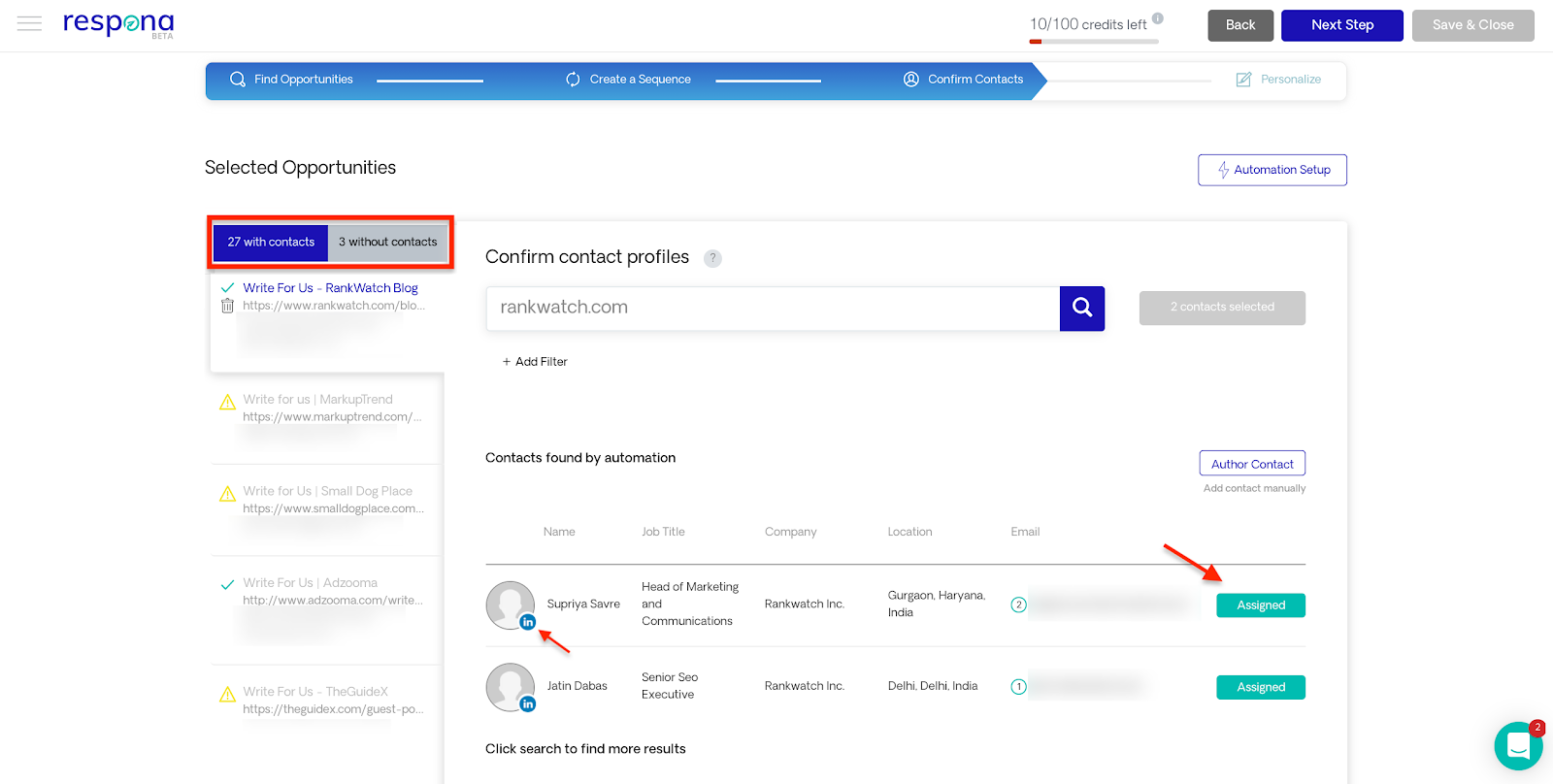

What’s really helpful is that the tool has automatically assigned the opportunity after the email address was found.
Regarding the contacts that haven’t been found, it’s important to mention that these are not lost opportunities.
What we can do in cases where we get some without contacts opportunities is to click on each of the opportunities and perform a “domain level contacts” search.
If you still don’t get any results, we can go further into doing an “author contact” search or add contacts manually, in case we know the prospects details.
The capabilities don’t stop here.
We could also do a search using the prospect’s first name or full name.
In this case, we could use information from the company’s website or LinkedIn account.
We therefore understand that the options are many and can totally help us get the desired results.
After having assigned an email and specific person we’re going to reach out to for each of the opportunities on our list, we can move forward with the next step.
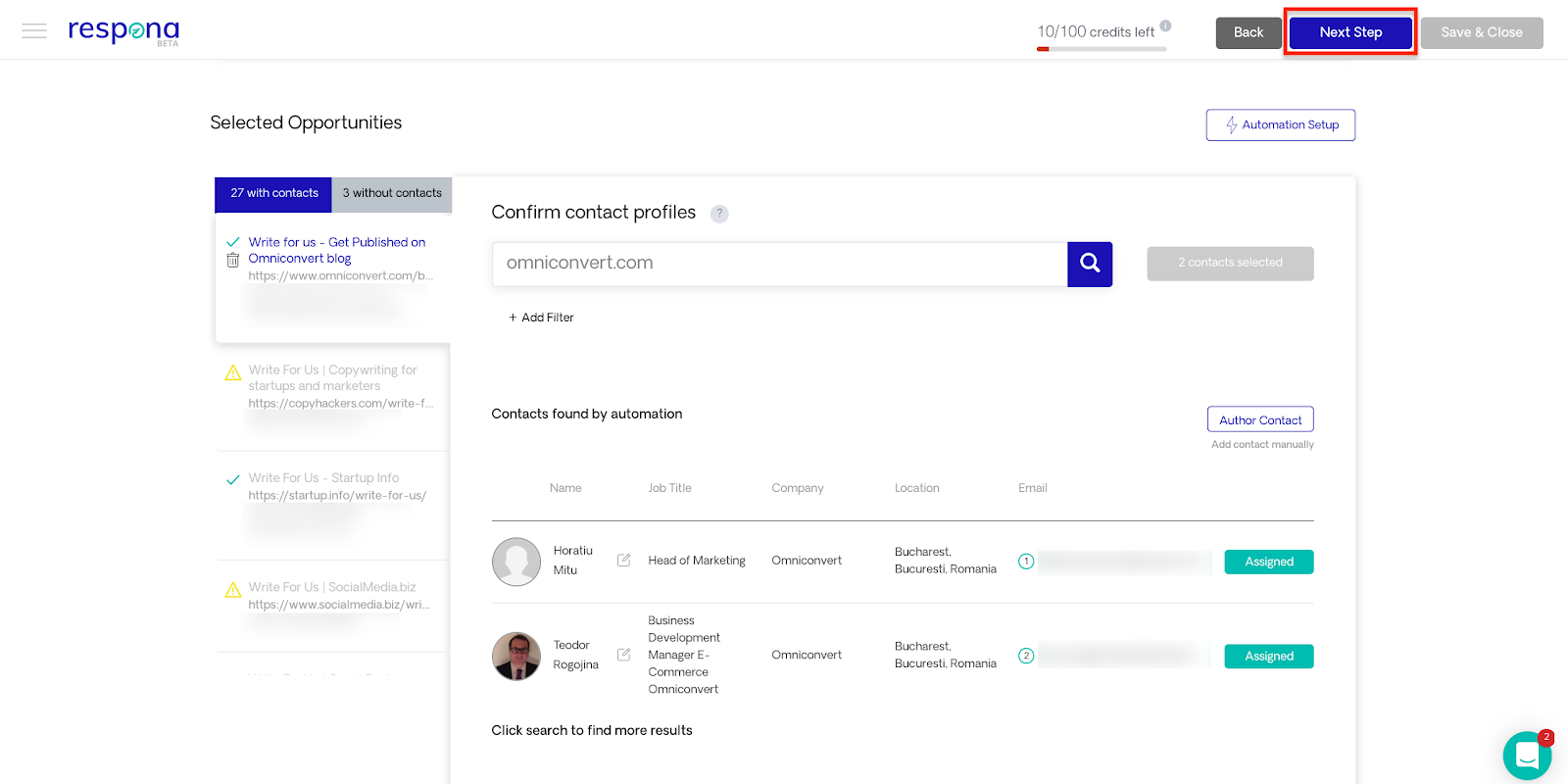

We’ve now reviewed our opportunities and got all the necessary information.
The next thing we should be doing is to check out our email sequence and make sure it all looks as it should in terms of personalization.


We have the opportunity to go in depth in terms of reviewing our initial as well as follow-up email and add or remove any points that we might need to.
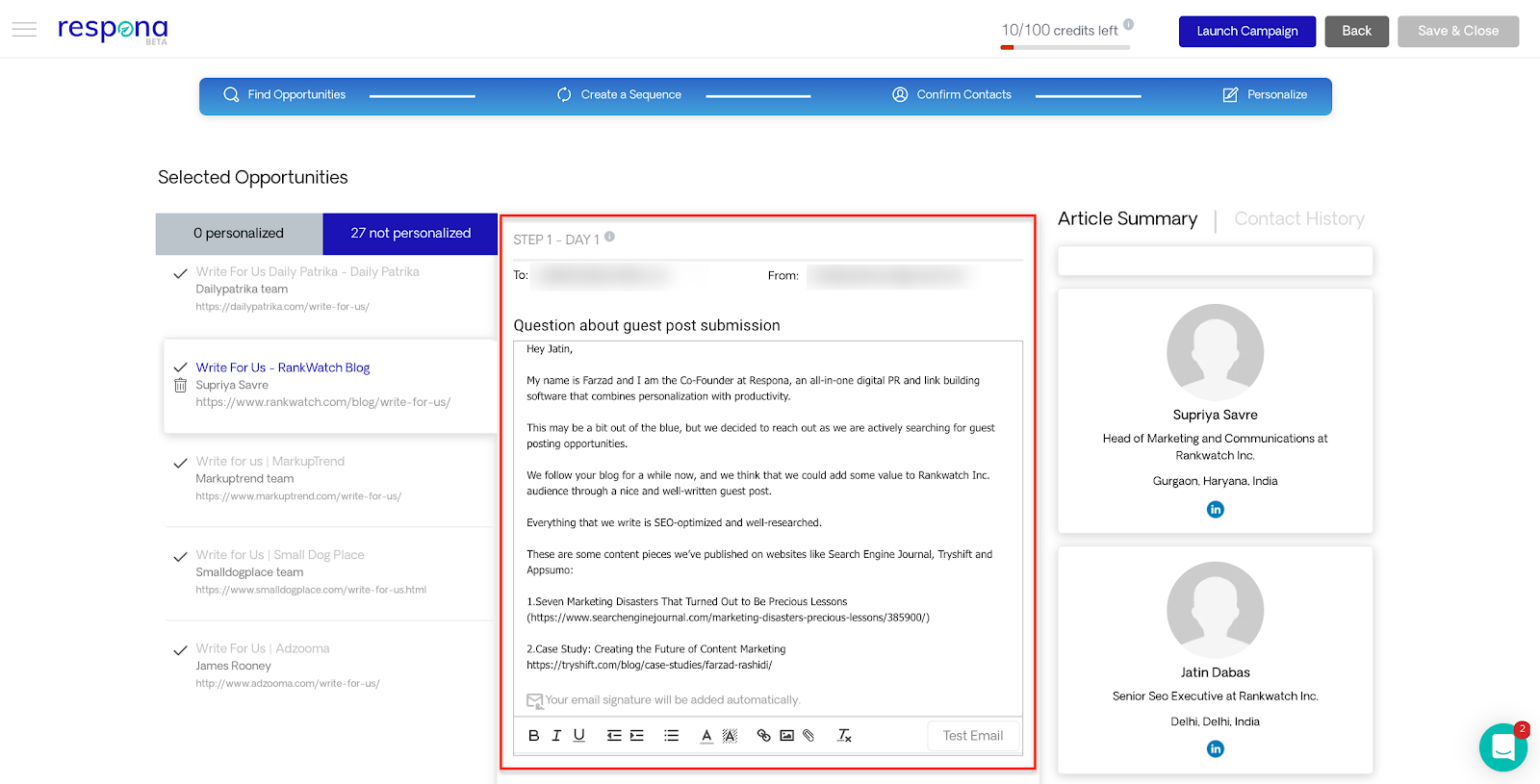

After we complete our email sequence review, our final step is to press the “Launch Campaign” button and get our campaign live.
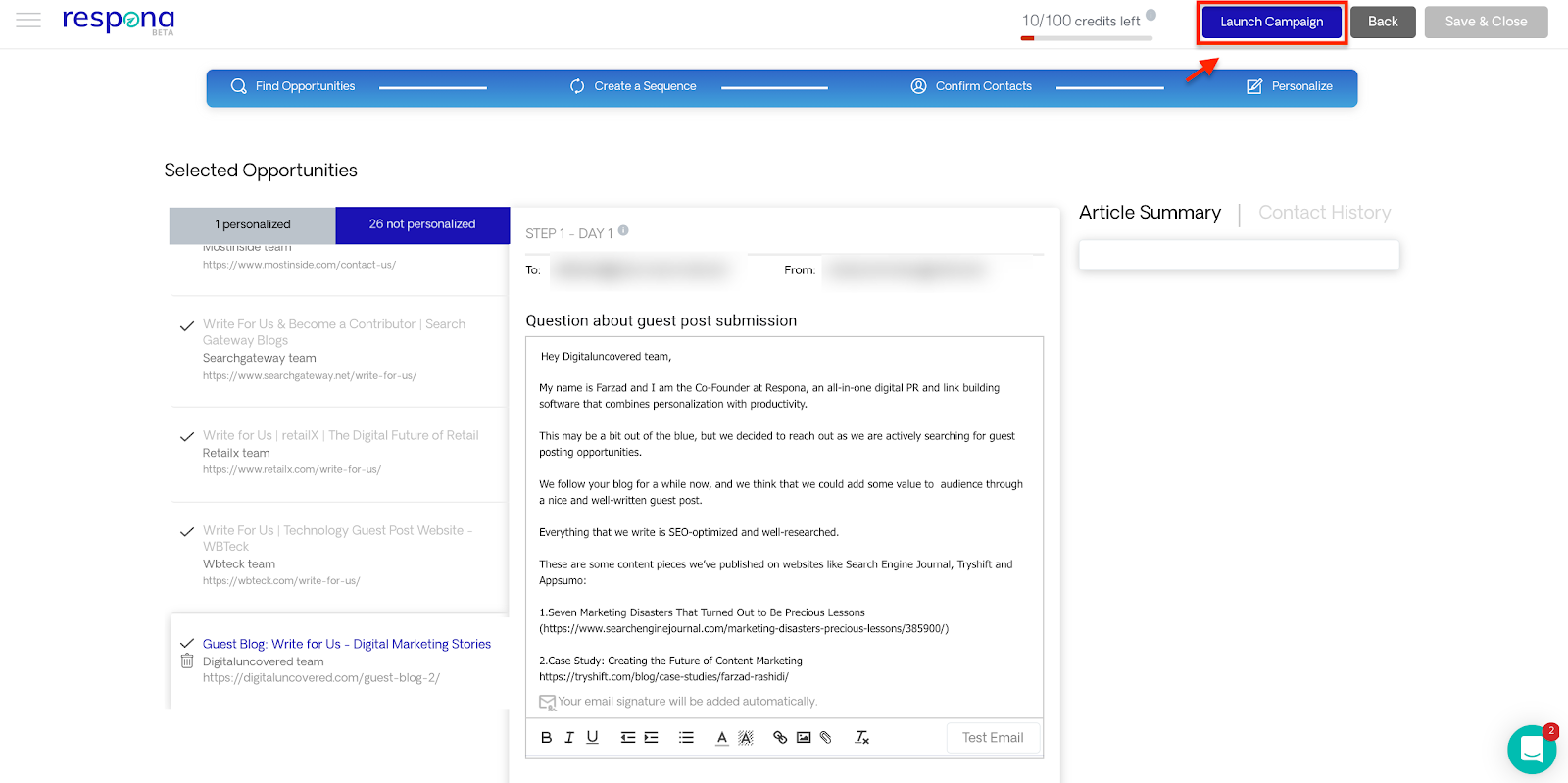

Keep reading to find out how this process works when it comes to content promotion.
The second white hat link building tactic we’re examining here has to do with content promotion.
Like we did before, we’re using a scenario that will help us get through the process in the most clear and understandable way possible.
Say that we’ve published a blog post on SaaS marketing – which we actually did! – and we want to promote it.
In this case, we’re interested in finding websites that are relevant to our topic or might be publishing and linking back to relevant content pieces.
After we find them, we basically want to pitch them our resources and the great content that we publish on our own blog.
Our target is, as you can imagine, to get some high authority links from relevant sites and raise awareness of our quality content without being spammy.
Let’s get the process of promoting our piece of content, by using Respona, started.
Our very first step is to create a new campaign.
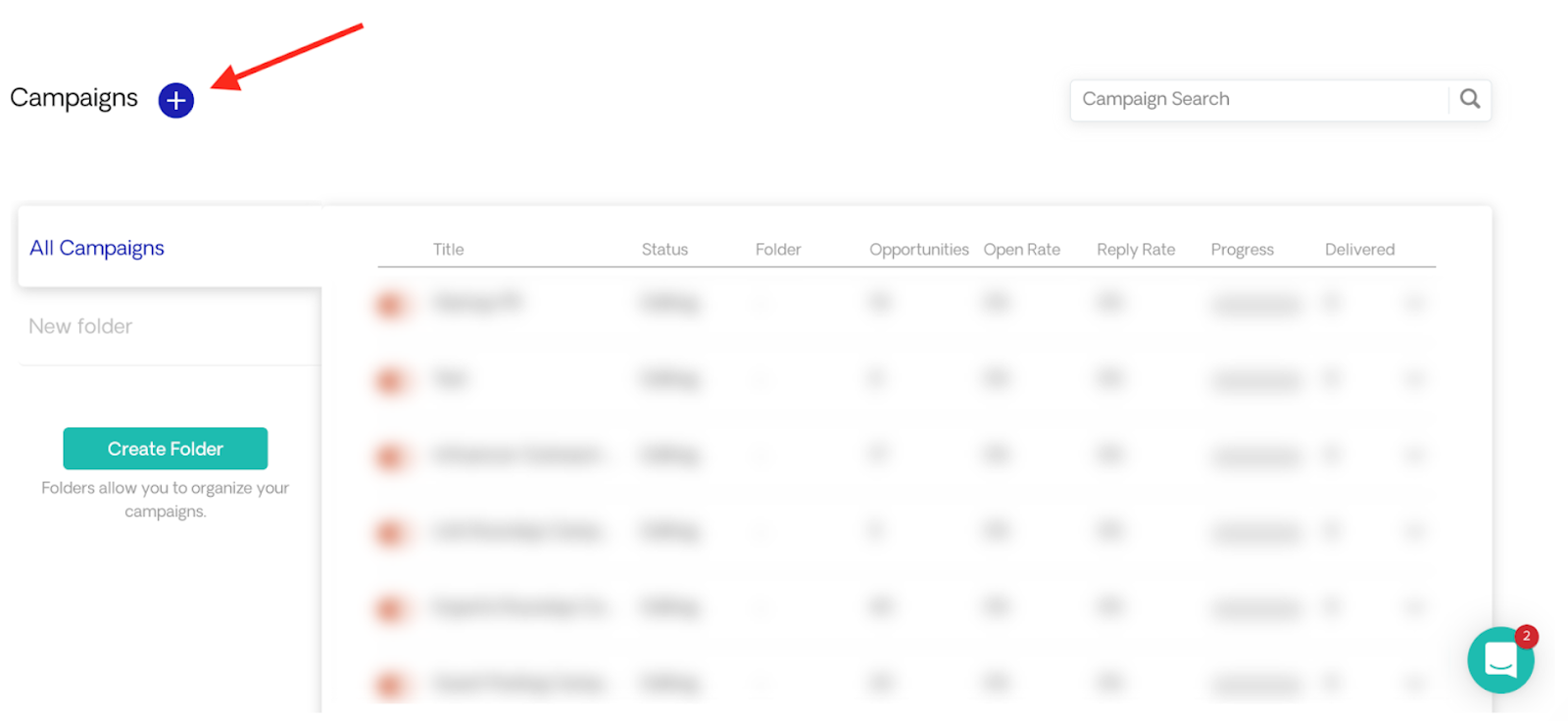

We then go on naming our campaign.
In terms of giving our new campaign a title, we’re trying to use something that’s memorable and will help us identify our campaign when running more than one campaign at the same time.
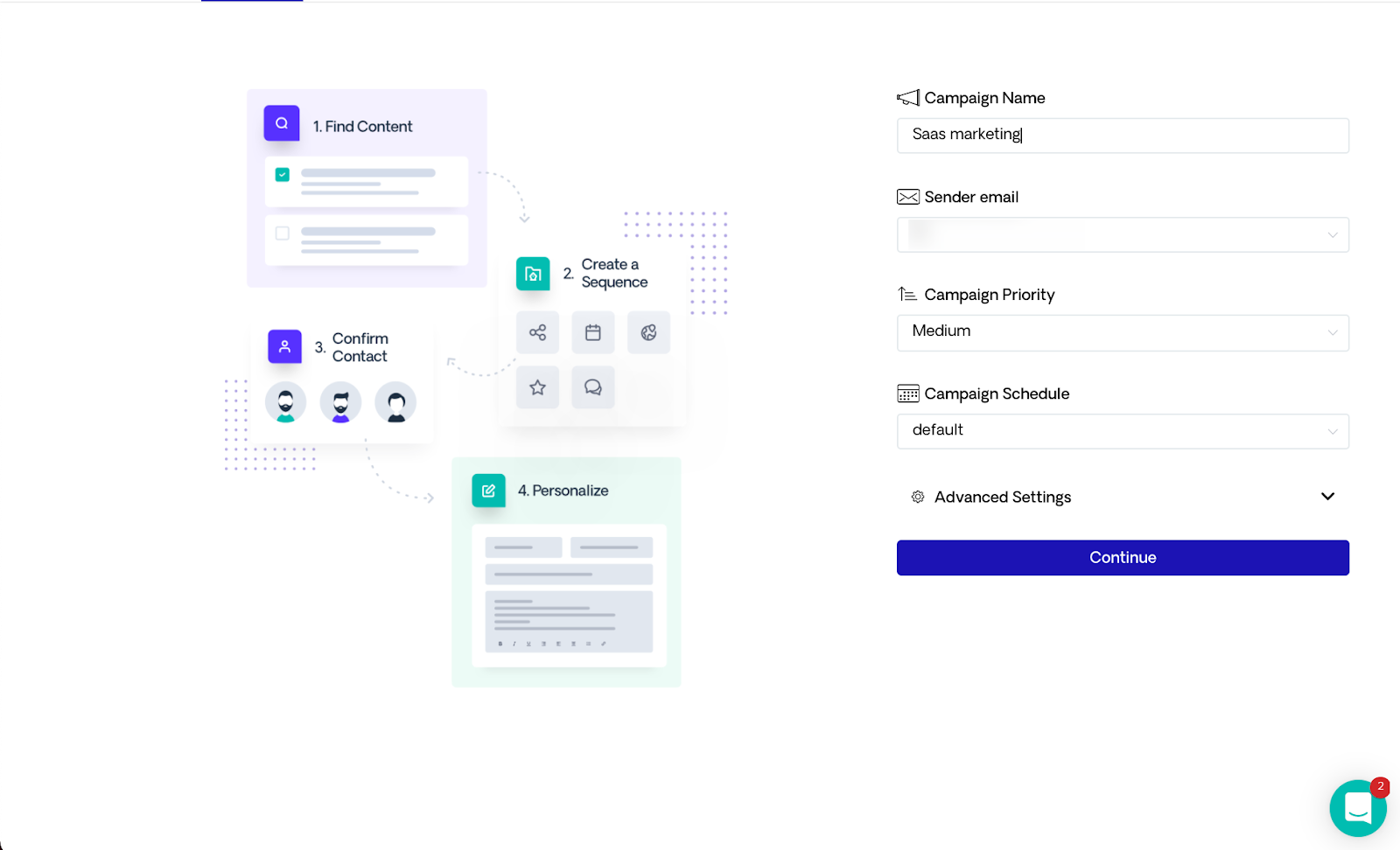

Once you’re done with giving your campaign a memorable title, you can set up the campaign priority.
There will be three options:
Choose the one that best suits your campaign.


Your next step in creating your content promotion campaign is to determine your sending strategy.
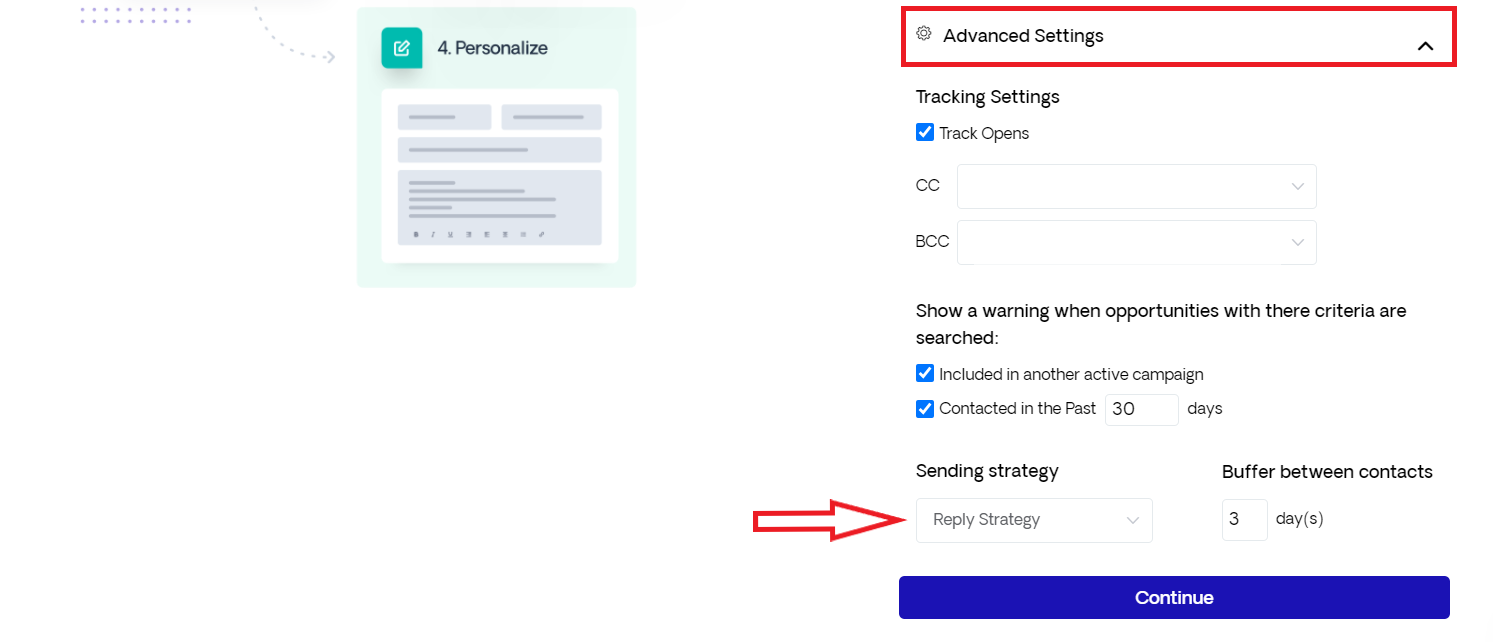

Next, we need to choose a campaign type by doing a search using the built-in Respona search engine, which is as easy to do as a Google search.
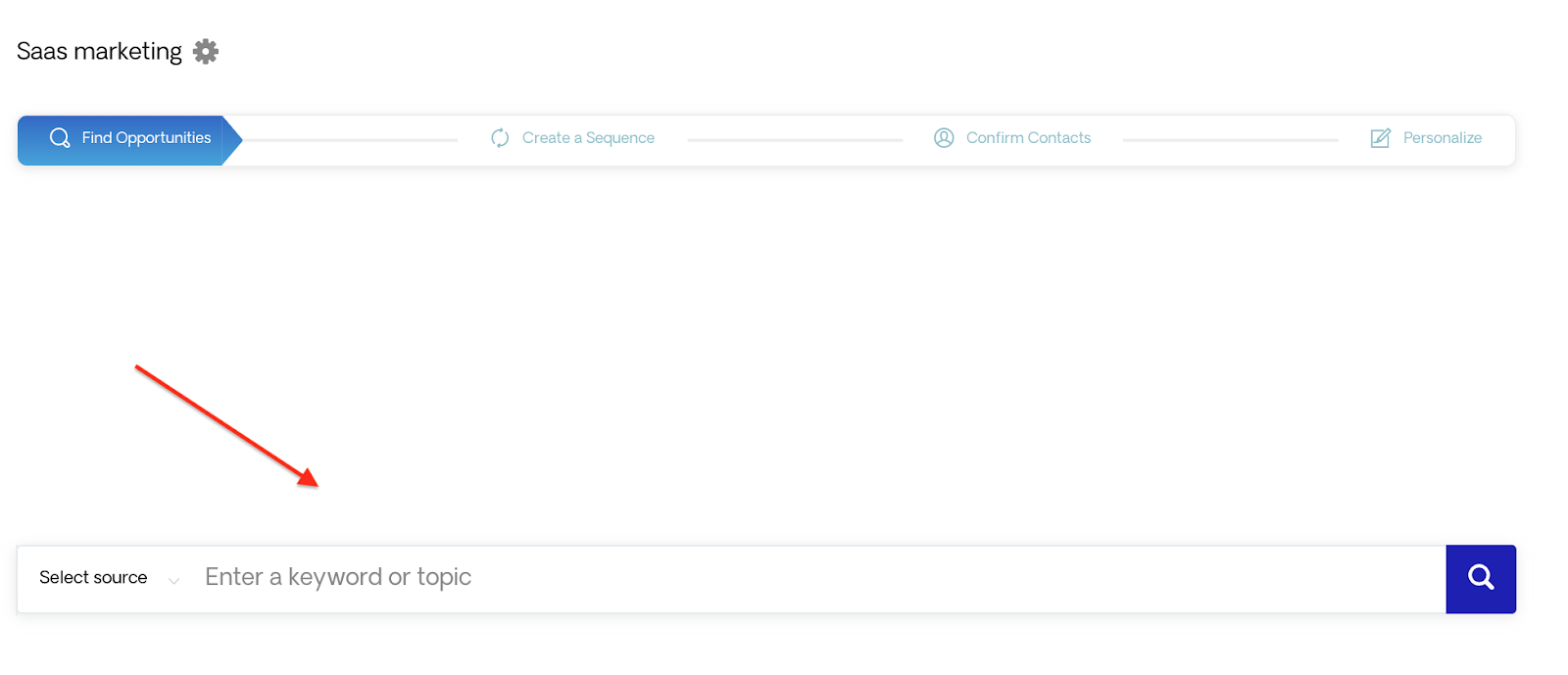

Author’s Note: Respona’s search engine results are powered by Bing, so you might notice some differences between the results you see in Respona and the results you would see in Google.
Alternatively, you can also press the import button, in case you already have an audience or distribution network.


You could even make use of both flows at the same time to maximize the results.
Using an advanced search operator, like the one you can see below, can help you get the results you want and identify good opportunities for your content promotion campaign.
Your next step is to select a source for the results you’ll be getting.


Your options here are:
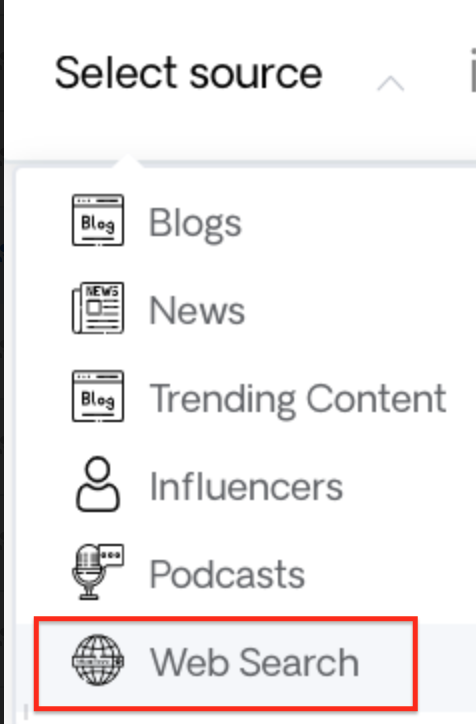

After having set your search query, you can have a look at your results.
If you want to have a closer look at any of the web pages shown below, you simply press on any of the blue links, like the one we highlighted for you.
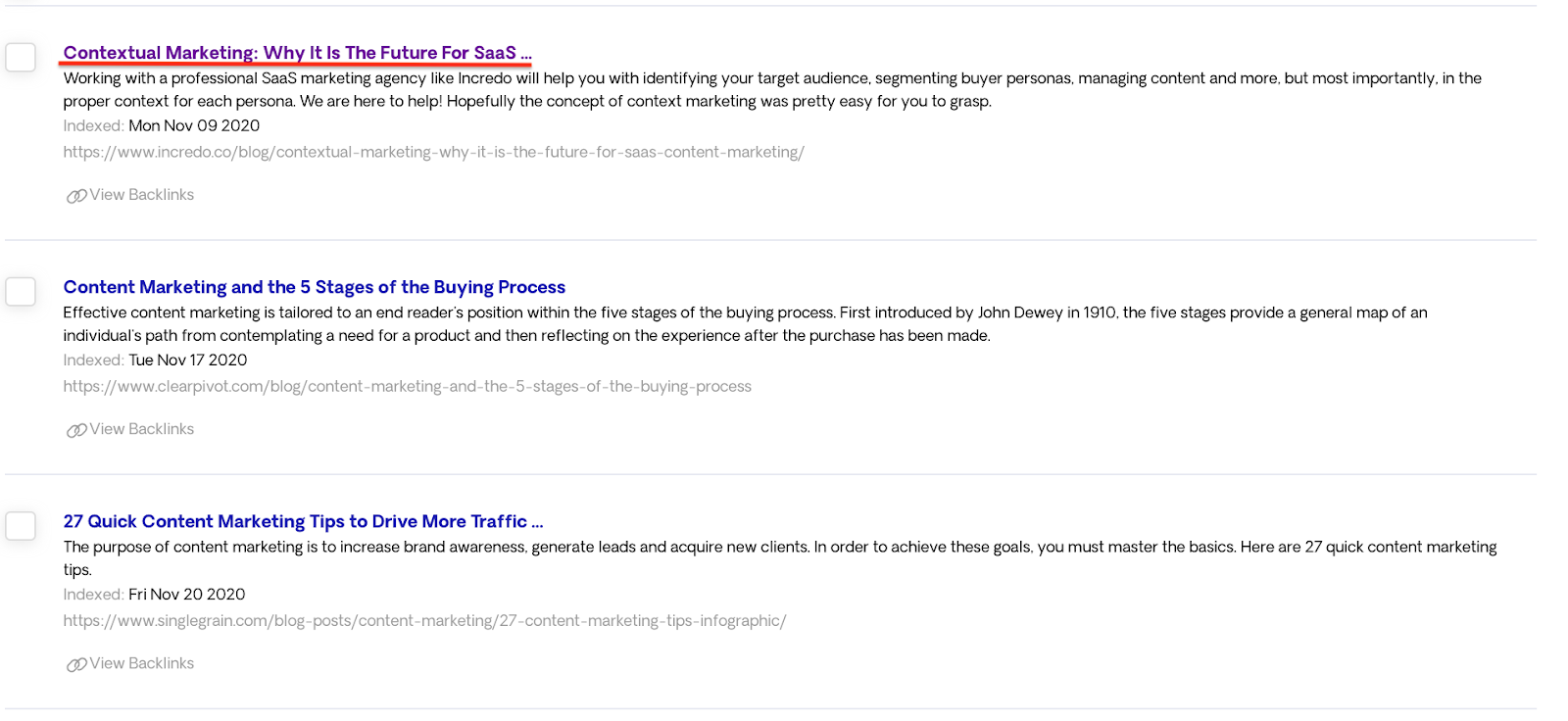

You can choose the opportunities that you’re interested in by clicking on the checkbox next to each of them.
As you do that, the number of opportunities will be changing.
In this case, we’ve selected thirty opportunities.
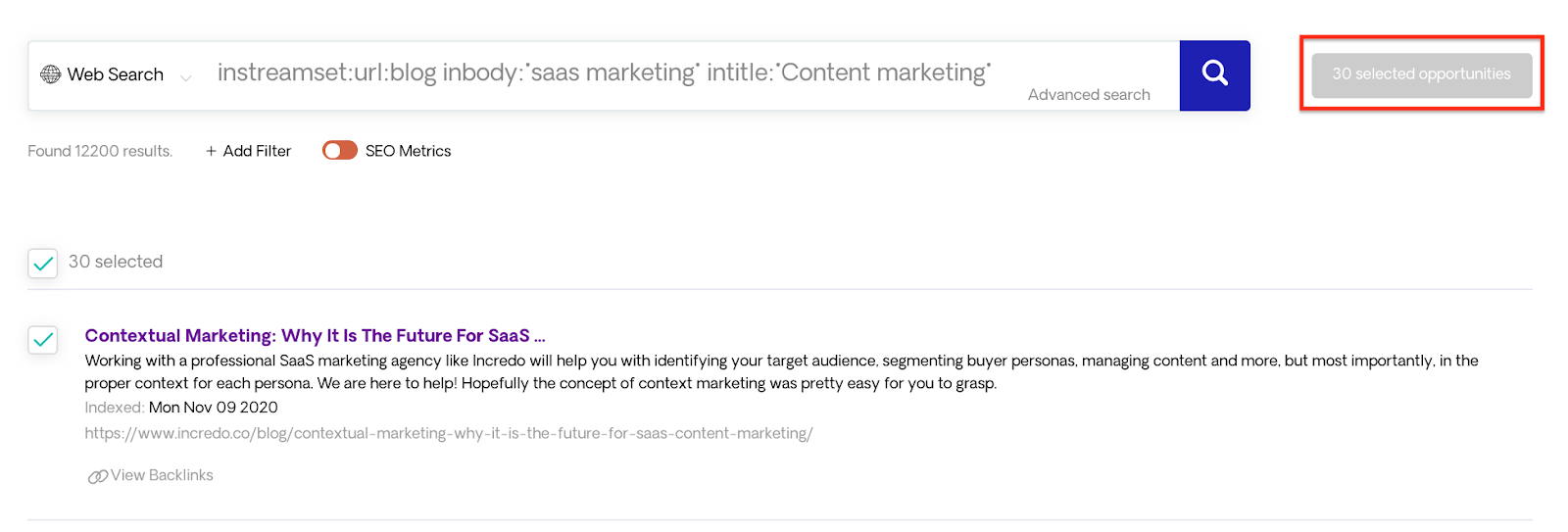

We need to mention that, in case you don’t want or don’t have the time to manually select some of the opportunities, you could simply press the select all button and move forward.
After you select your opportunities and make sure that you found all the opportunities you want to include in your content distribution campaign, you click on “Next Step”.
You’re good to go.


Your next big step is to craft your email pitch, which is an integral part of your campaign.
Respona offers a wide range of email templates depending on the nature of your campaign.
We’re now building our content promotion campaign so we naturally select the “Content Promotion” template.
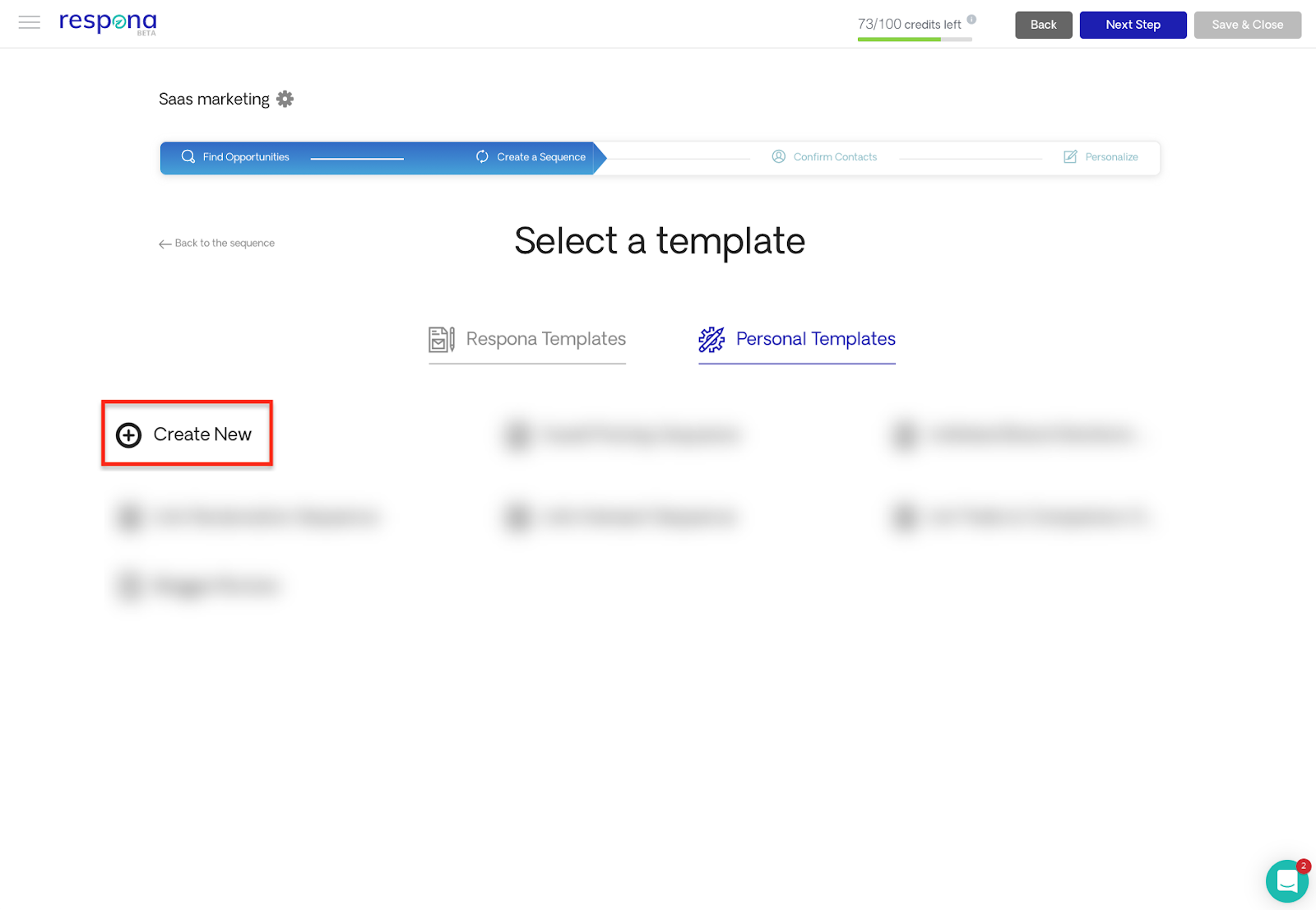

As you can see, this template comes with an email sequence.
Have a look:
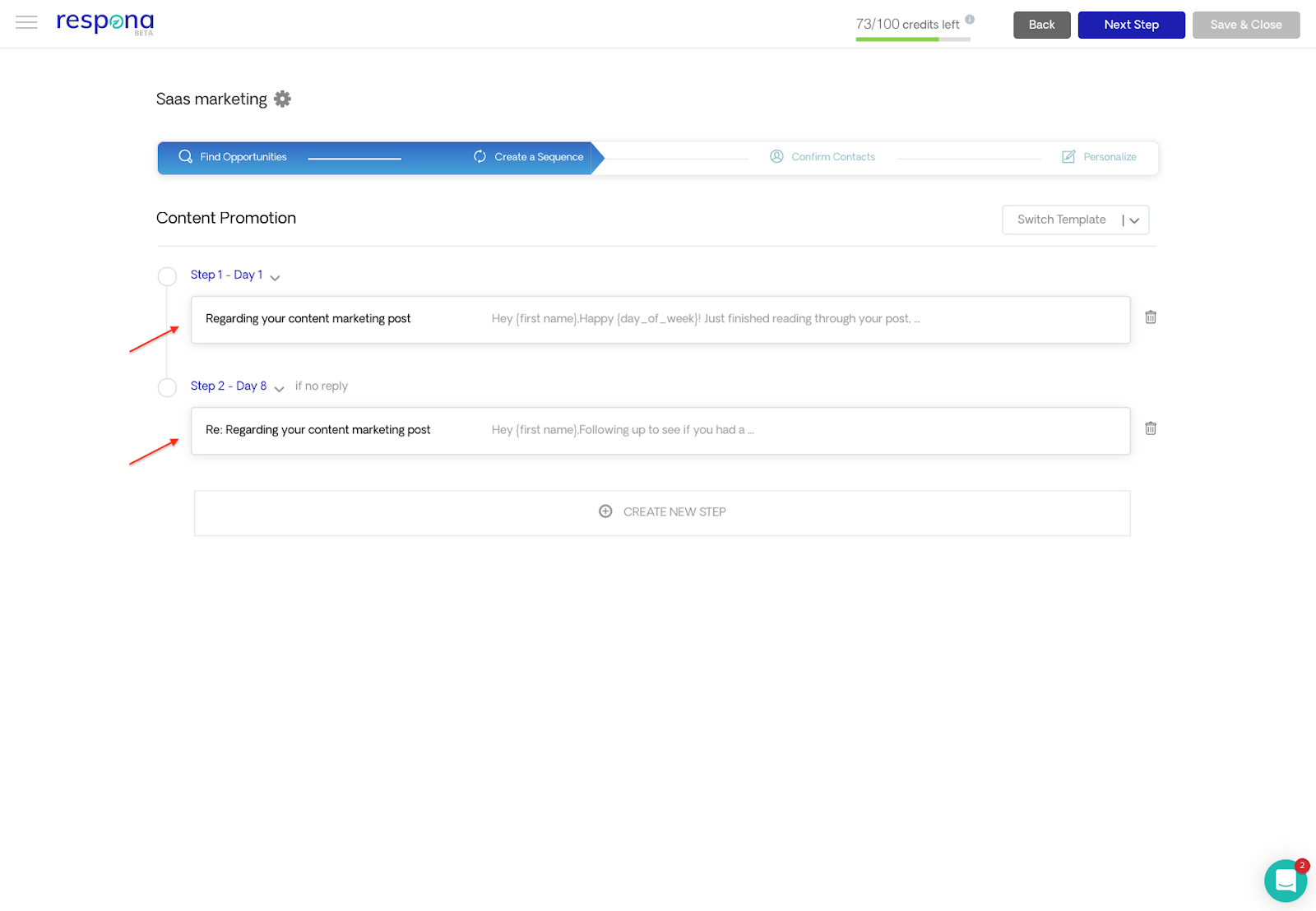

You can click on any of the emails in the sequence to see what the email looks like.
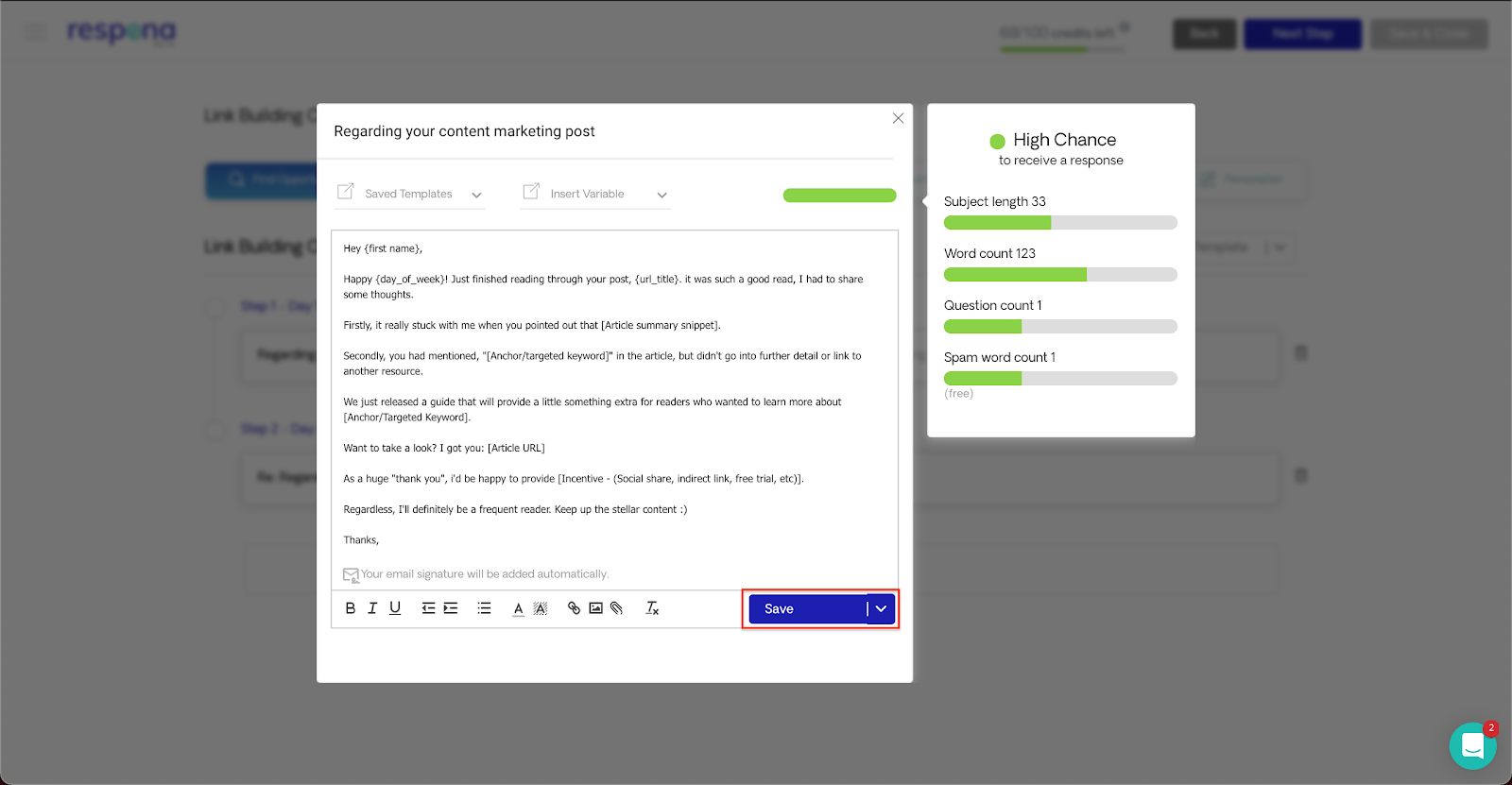

As you can see below, your first email has high chances of getting a reply.
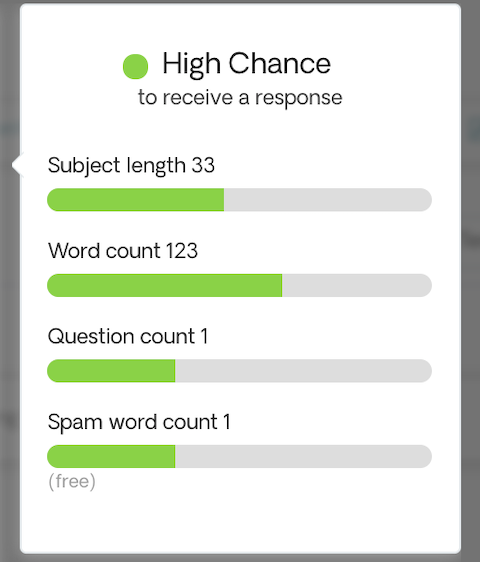

Like we did before, we can also click on the second email of the email sequence, our follow-up email, and make any necessary changes.
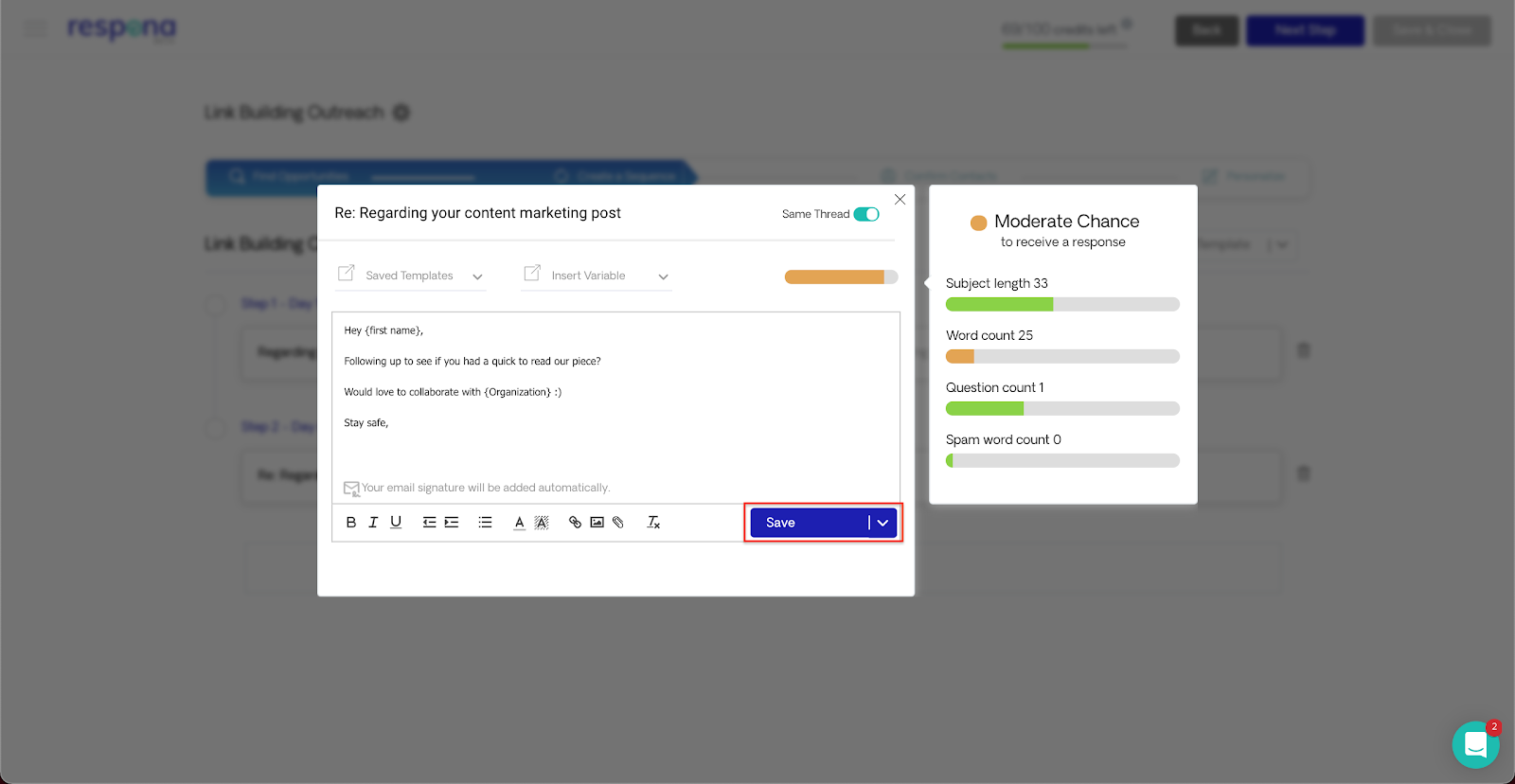

After you make sure you’re happy with your email sequence, you should save your email and move to the next step.
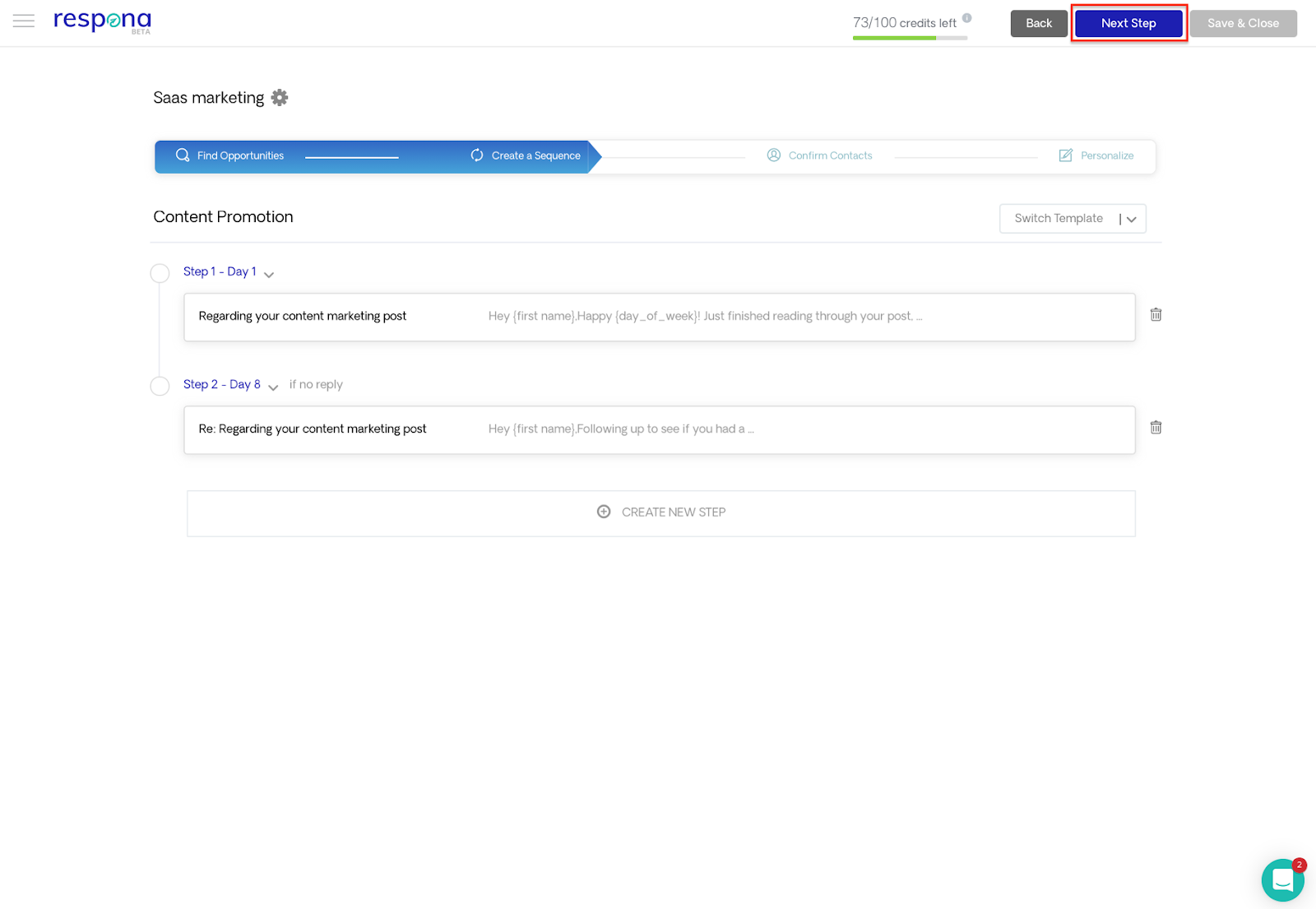

The next move you’re about to take is to do with finding contact information for your prospects.
First of all, at this point you need to choose if Respona will assign opportunities to the authors of the selected URLs or not.
As you can see below, and given the nature of our campaign, we’ve chosen that Respona assigns opportunities to the authors only if they work for the company.
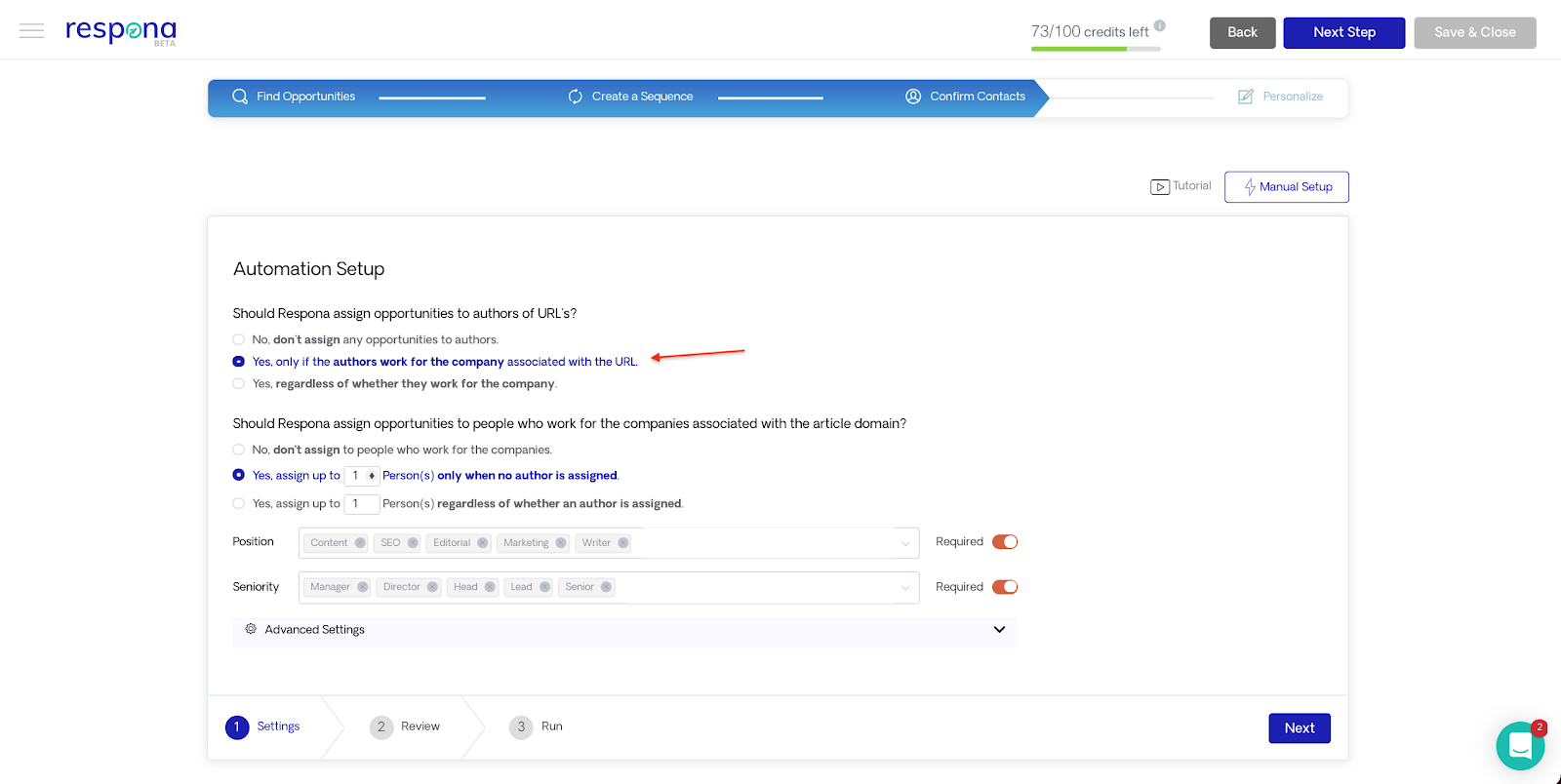

The reason why we did this is because, when it comes to link building campaigns, we need to be sure that the person we’re reaching out to – the author – works for the company and will be able to add our link to their page.
In addition to this, you can also choose to assign opportunities to other people working in the same company.
This totally increases the chances of getting a reply.
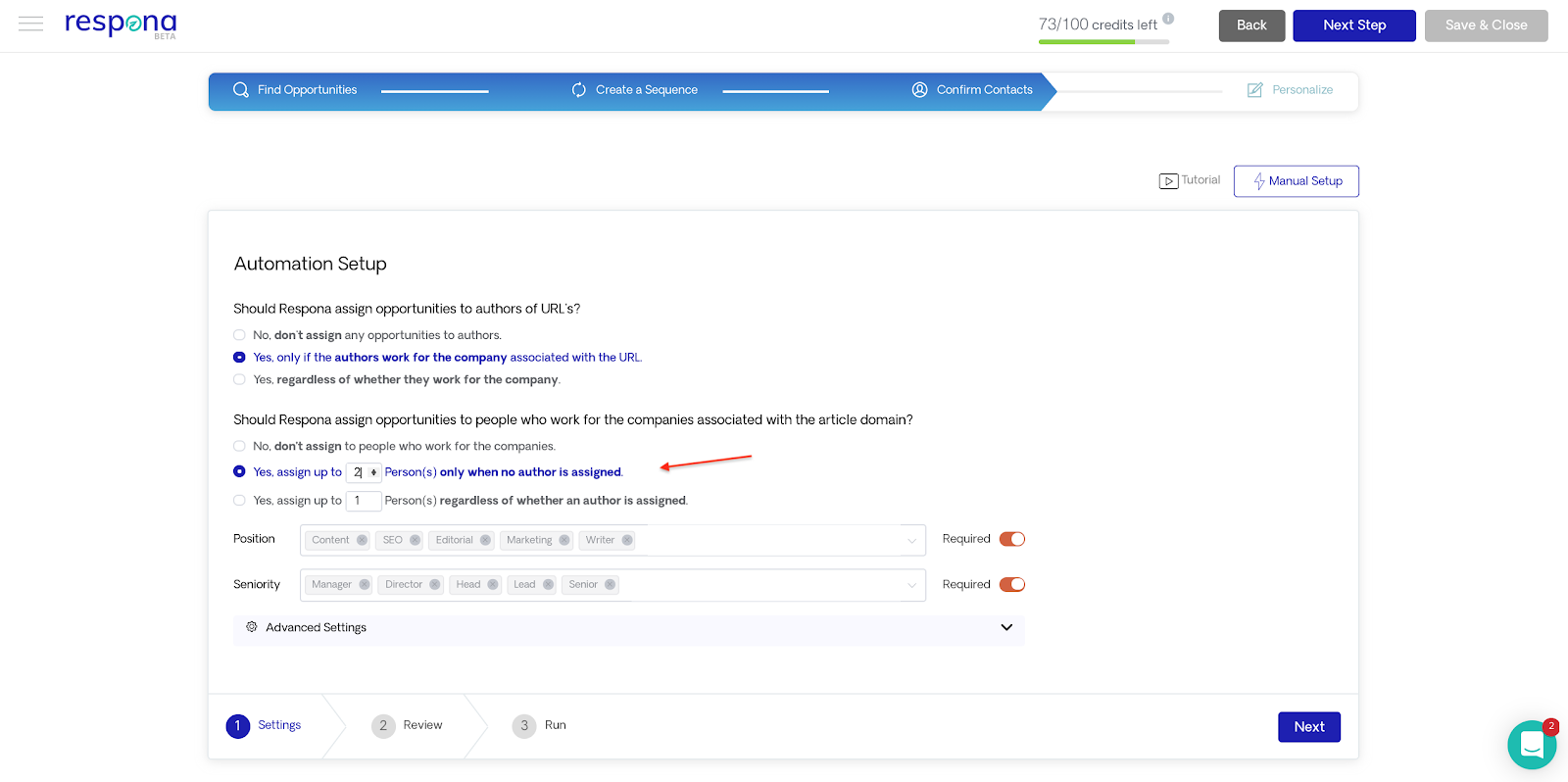

We’re looking for people in five different positions, with the seniority of, as you can see below, a manager, director, head, lead, or senior.


The reason for selecting people in key positions, such as content, SEO, editorial, and so on and so forth is to do with the fact that we need someone who can get us in contact with people with editorial access.
Even if you haven’t managed to find the author of a particular article, we can still reach out to someone from the same company.
We then move to the next step.


At this part of the process, Respona gives us information about the number of unassigned contacts, which in this case totals thirty, as well as how many credits will be spent to get the information.
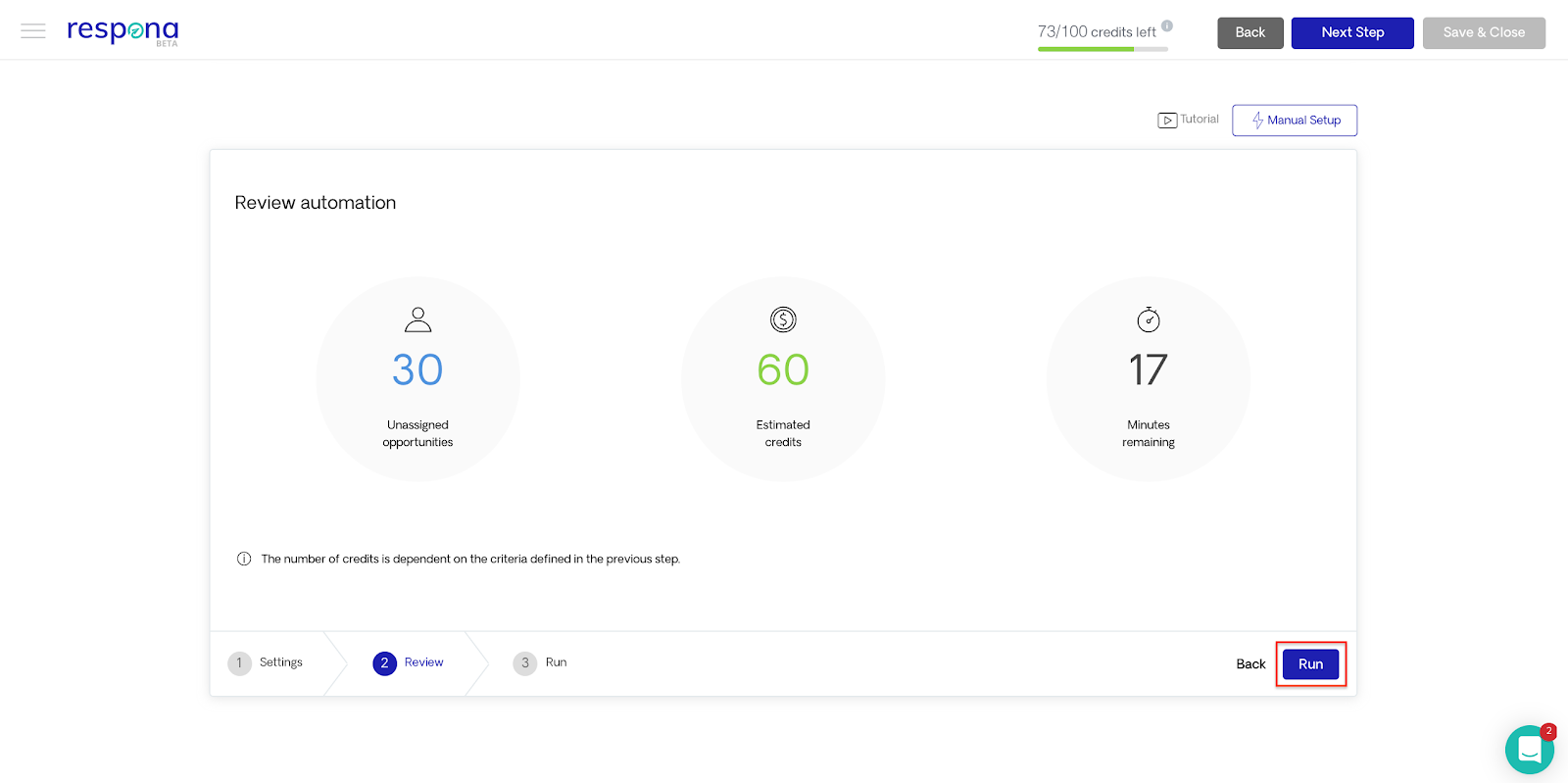

After we’ve clicked on “Run”, we’ve got these:
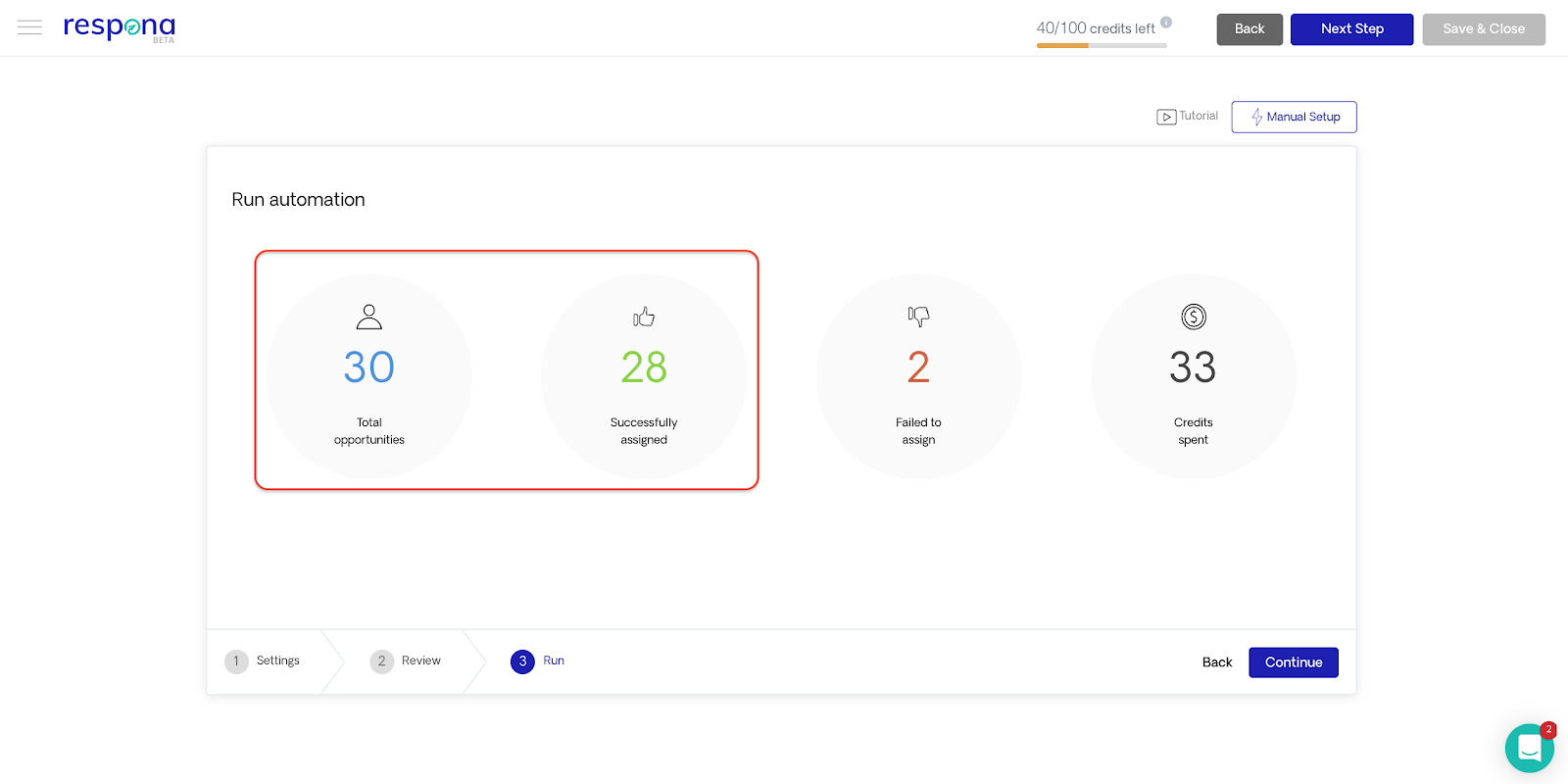

Out of thirty opportunities that were initially without a contact, we now have twenty eight that have been assigned a contact person.
At the same time, the credits spent for this task totalled thirty-three.
We first make sure that everything looks as it should and then click on “Continue”.
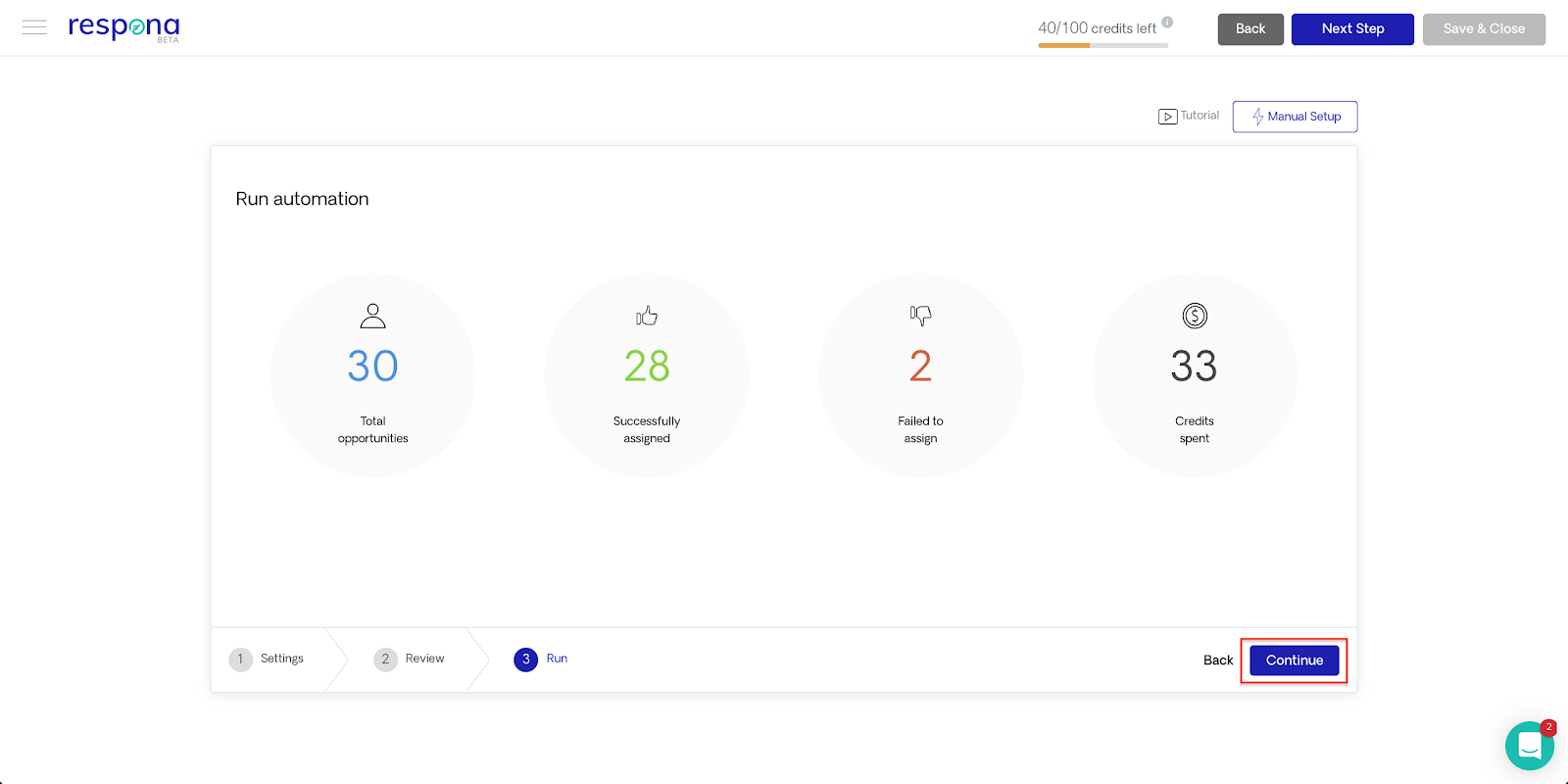

We’re now able to see the opportunities Respona found.
As you can see, for one of the opportunities, Respona has found two people, one of them is a content marketing manager and the other one a digital marketing manager.
We’ve also highlighted the small LinkedIn icon.
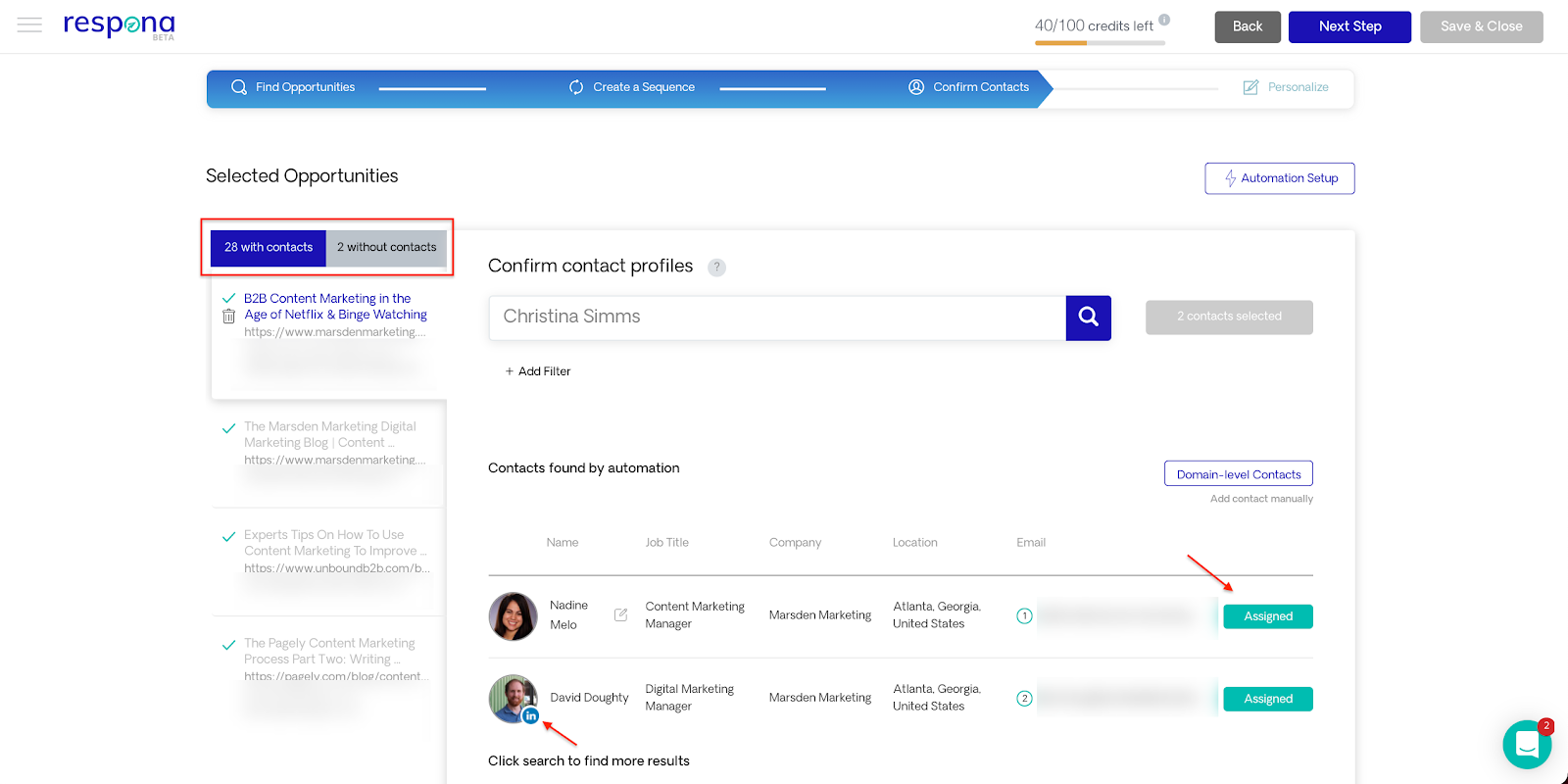

This can be really helpful in case you want to connect with your prospects before you reach out to them.
As we mentioned in the previous link building tactic we described, Respona gives you the opportunity to manually assign a contact to unassigned opportunities.
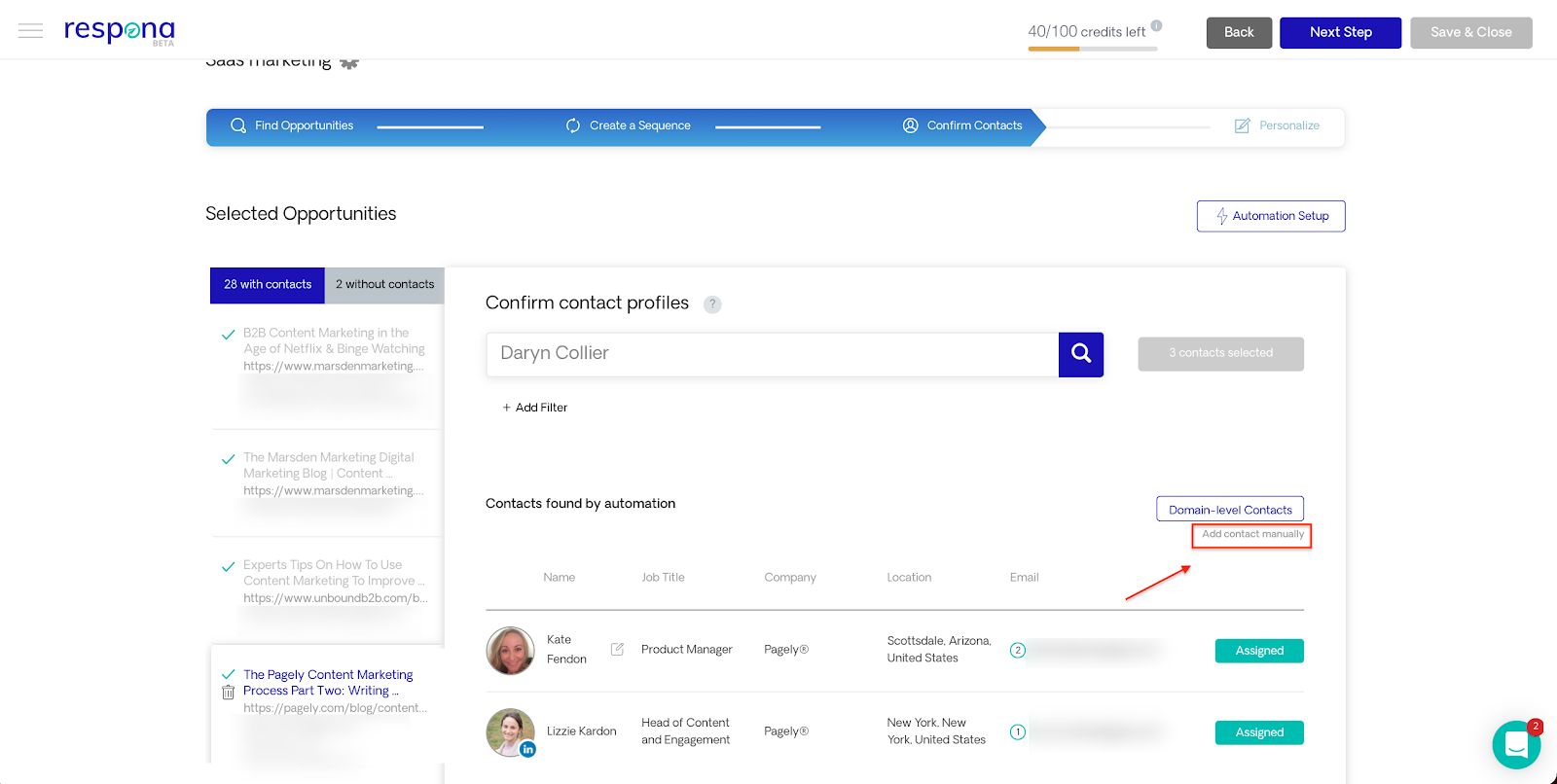

You could perform an additional search query by using someone’s first or last name, or both, and their company’s name.
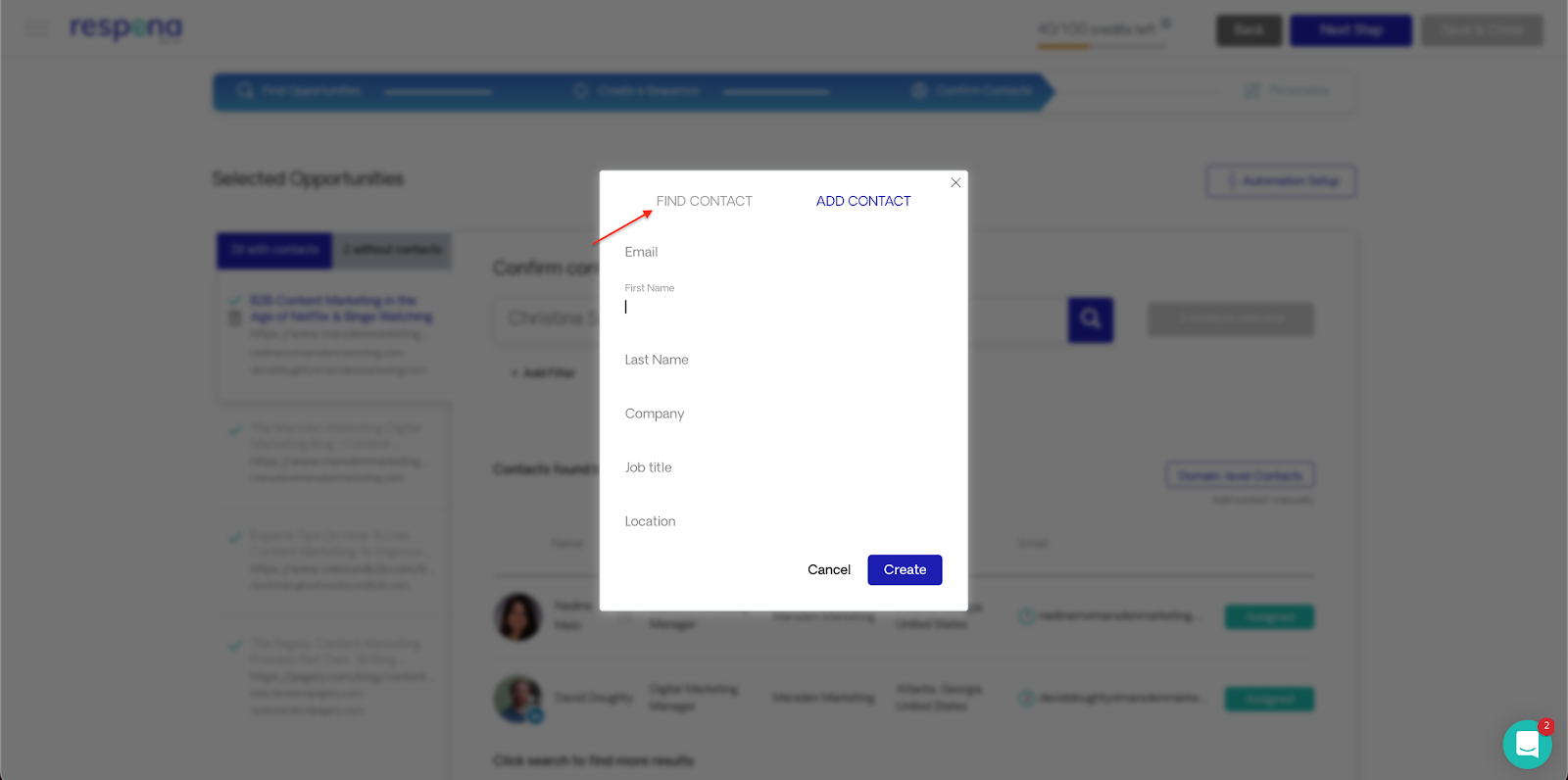

As you can see below, we’re first adding the domain of the company we’re interested in, which in this case is pagely.com.
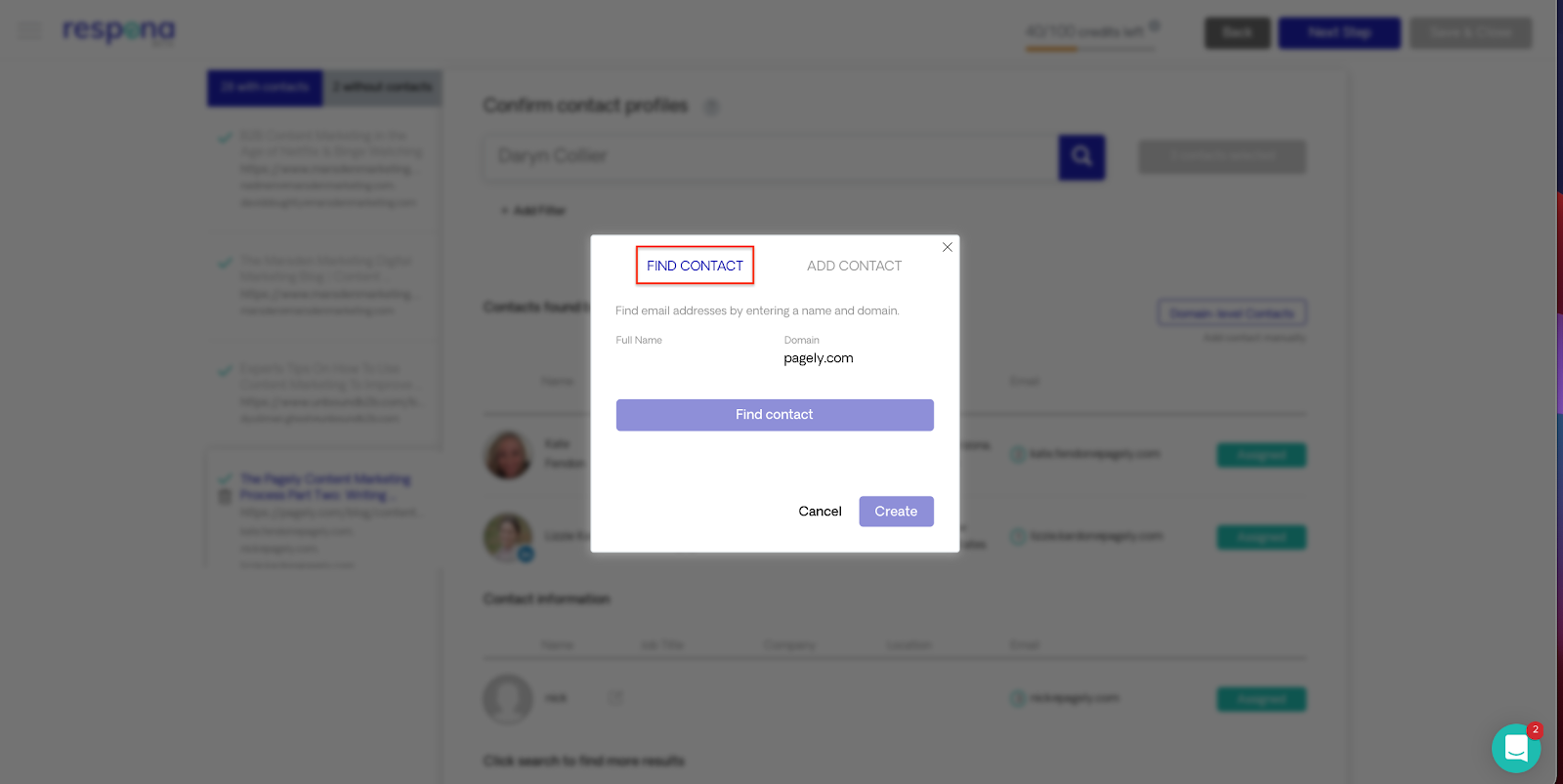

We then go on adding either a full name or a first name, depending on the amount of information we might have for someone.
It can be as simple as someone’s first name.
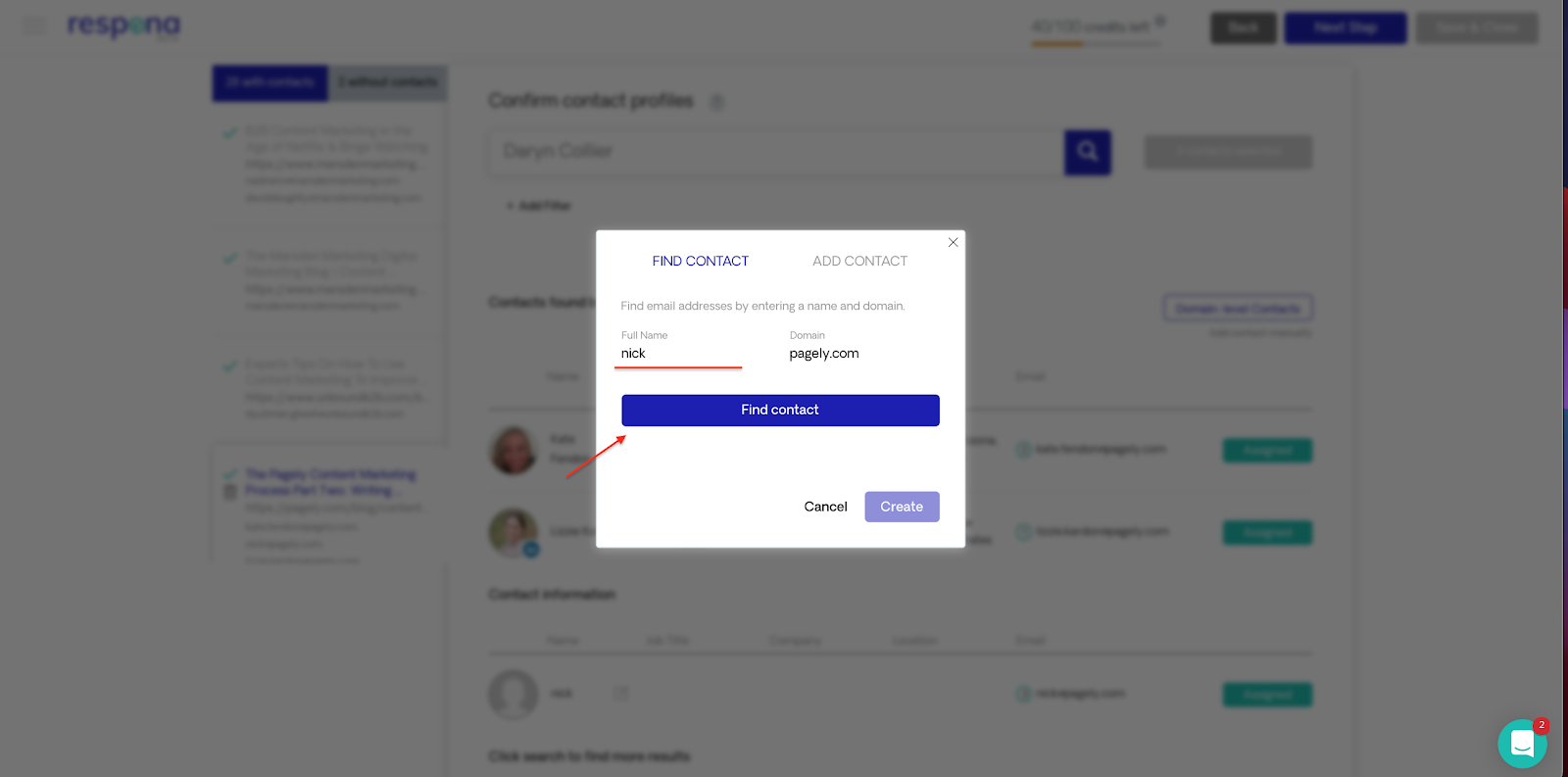

The next thing to do would be to press “Find Contact” and let Respona do the task.
As we can see, the search gave us the results we wanted and we now have the contact person’s email address.
Author’s Note: We’ve removed the email addresses of the contact people we’re featuring here for privacy purposes.
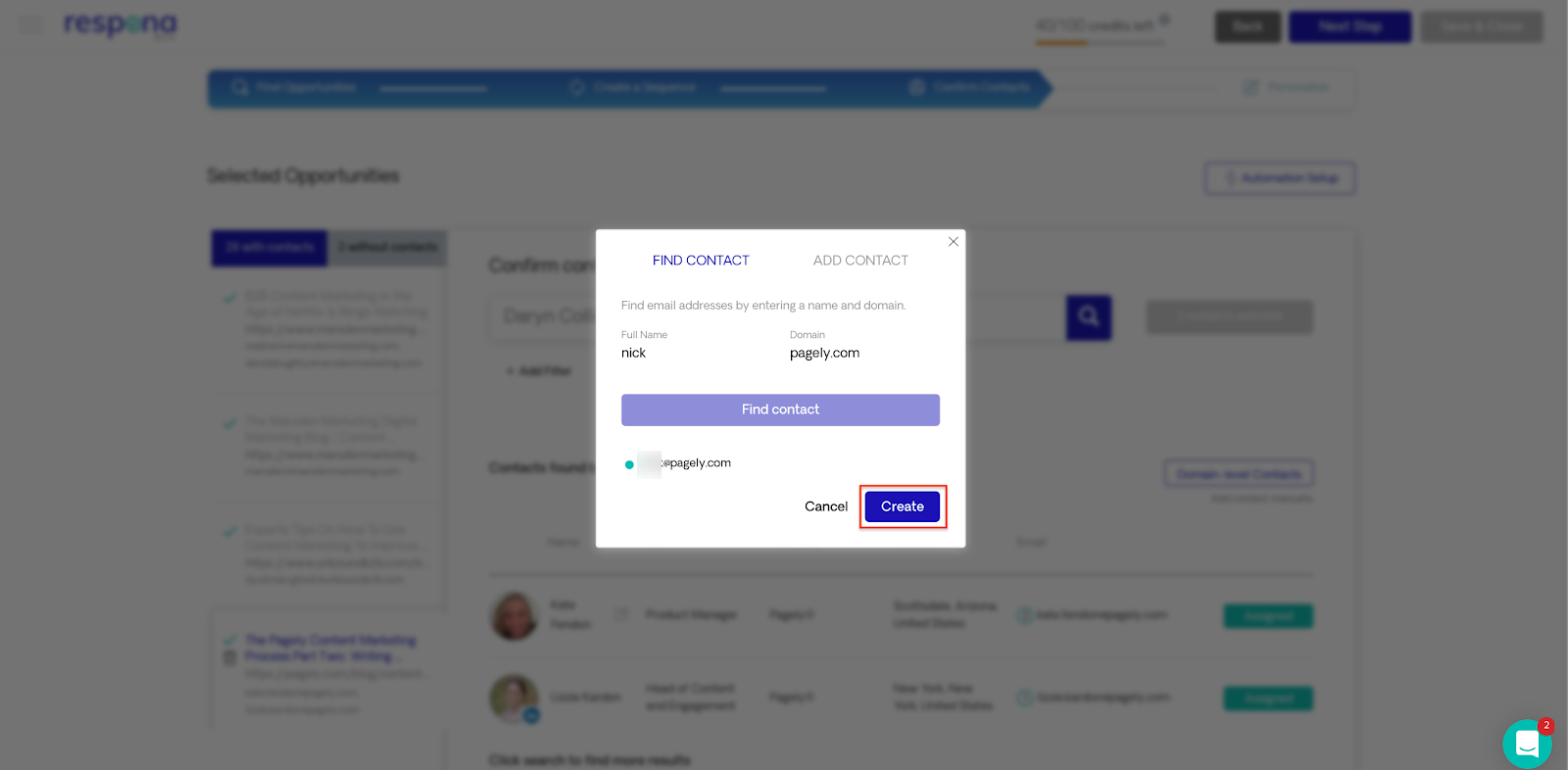

We’ve now assigned the contact person to the corresponding opportunity.


I think it’s important to highlight the amount of information that we might be able to acquire through Respona.
For example, a prospect’s contact information might include several of their email addresses, which helps us maximize the positive results of our outreach efforts.
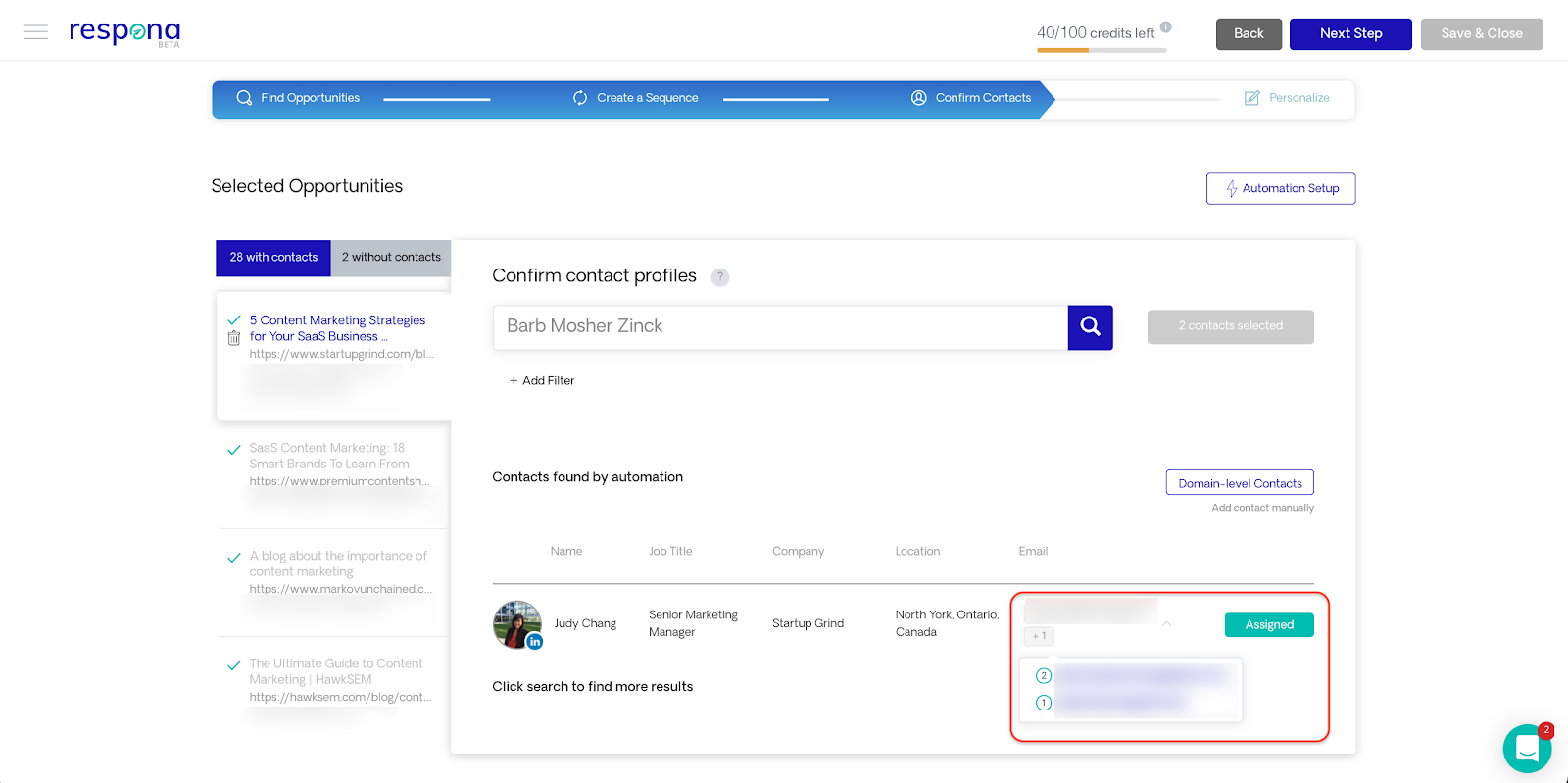

Once we get everything reviewed, we click on “Next Step” on the top right corner of the page and we get to personalizing and launching our campaign.
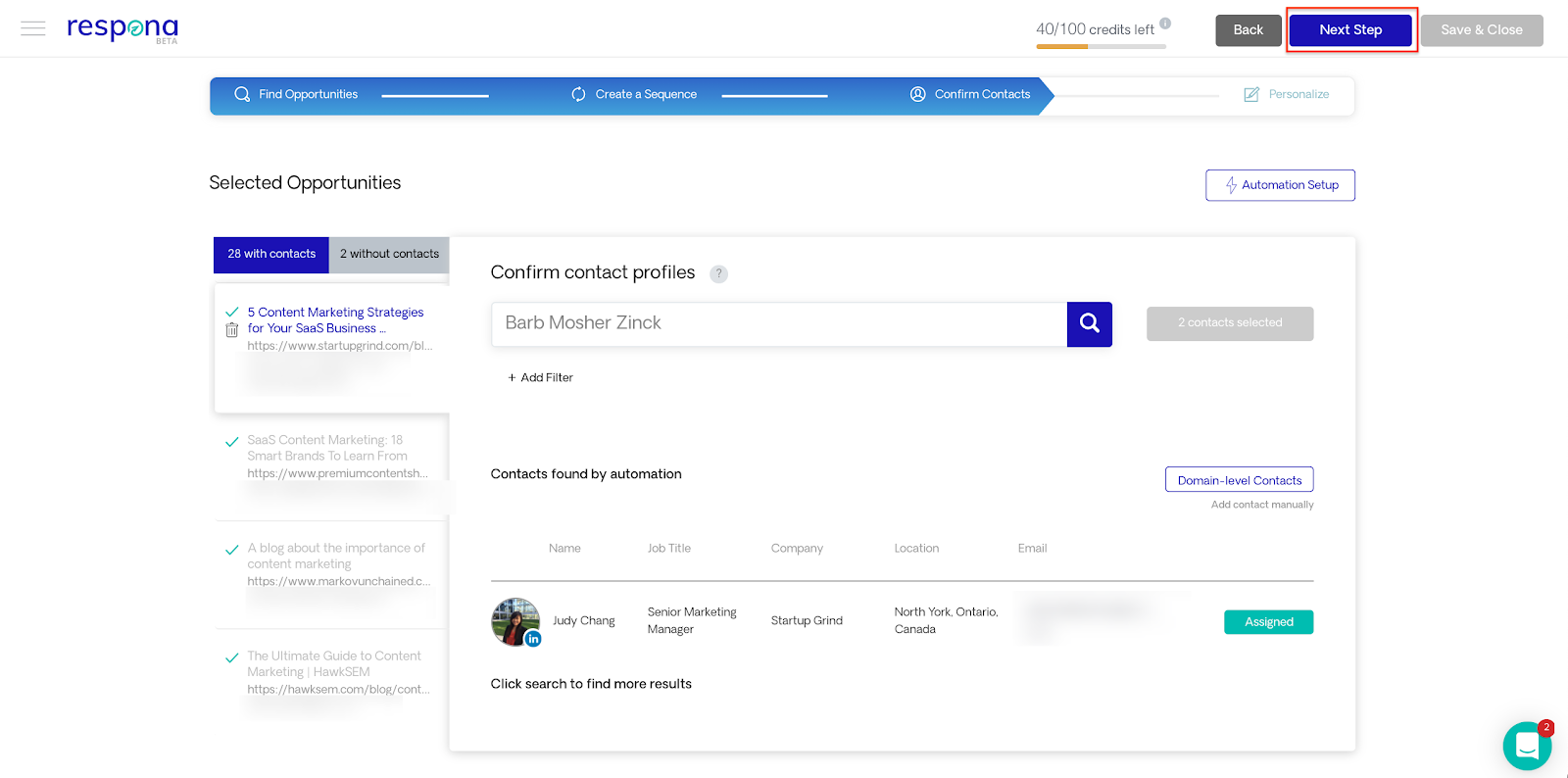

So far, we’ve created a useful list of people we can reach out to in order to distribute our content.
We’ve also found a vast amount of contact information for our opportunities and we created our email sequence.
We now need to personalize our pitch and start our content distribution.
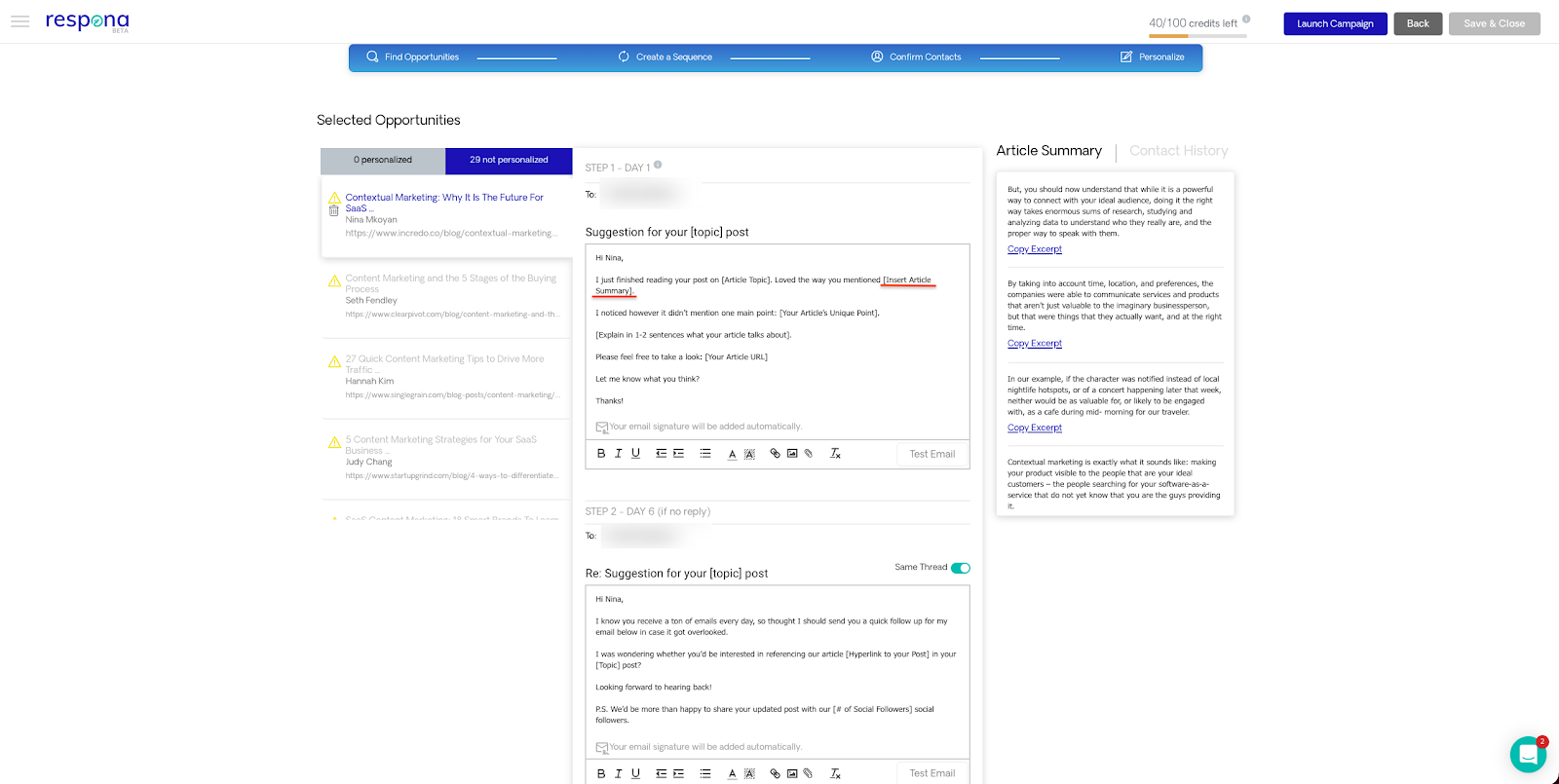

A way to personalize our email is to insert an excerpt of the article we’re mentioning in our email.
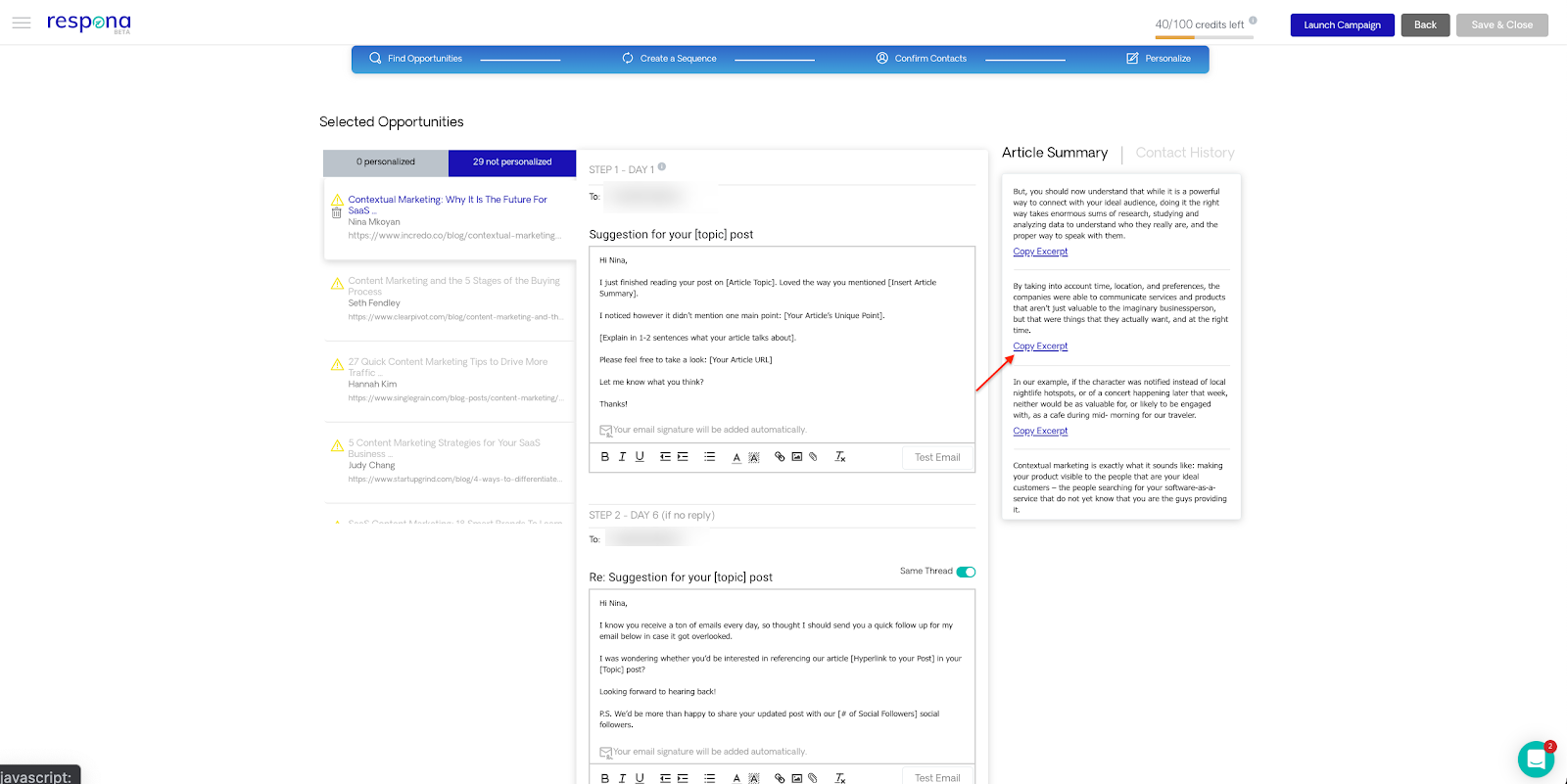

The process of doing so is pretty straightforward.
Have a look at the screenshot below:


After working on our cold email and doing our best at personalizing it, Respona will move the opportunity that has been personalized to the personalized tab.
You can keep track of the opportunities that still need to be personalized by looking at the top left corner, as highlighted below:
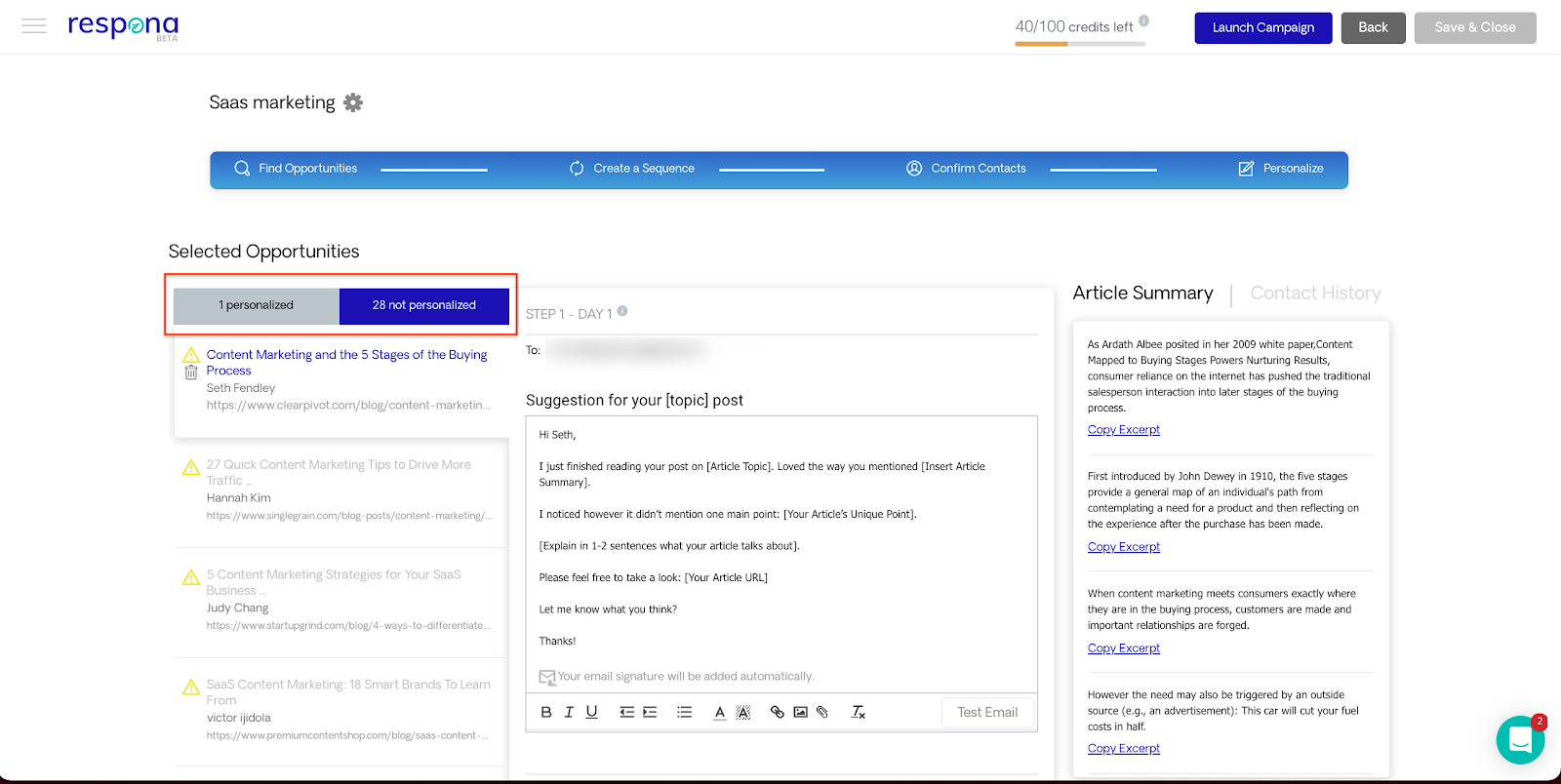

Once we’re done personalizing all of our cold emails, the only, very simple, thing to do is to click on “Launch Campaign” and launch our content promotion campaign.


Let’s get to our final white hat link building tactic.
For our final white hat link building we’re diving deep into podcast outreach.
Exactly as we did before, we’re using Respona to find podcast opportunities.
For the sake of our scenario, we’re looking to be guests on marketing-related podcasts.
We’re therefore interested in finding podcasts that are relevant to our topic so we can pitch them.
Why do that?
Because when you’re a guest on a podcast, the host will not only interview you but will most likely tag you in their social media, and importantly link back to your website when posting the podcast.
Let’s start building our campaign.


By now you probably already know the process.
We first give our campaign a title.
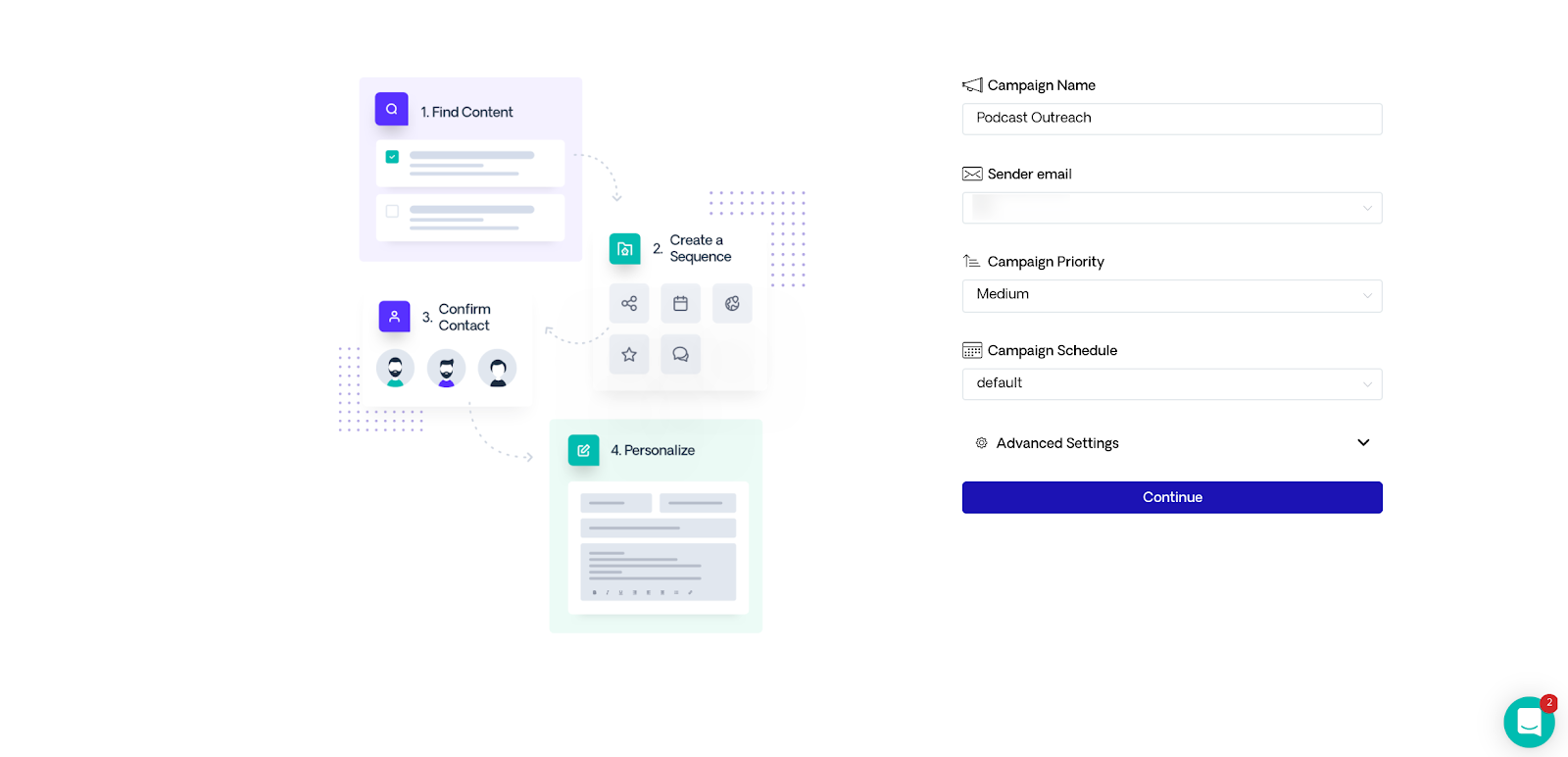

We then set up the campaign priority, which helps us keep on top the important stuff while also working on other tasks.
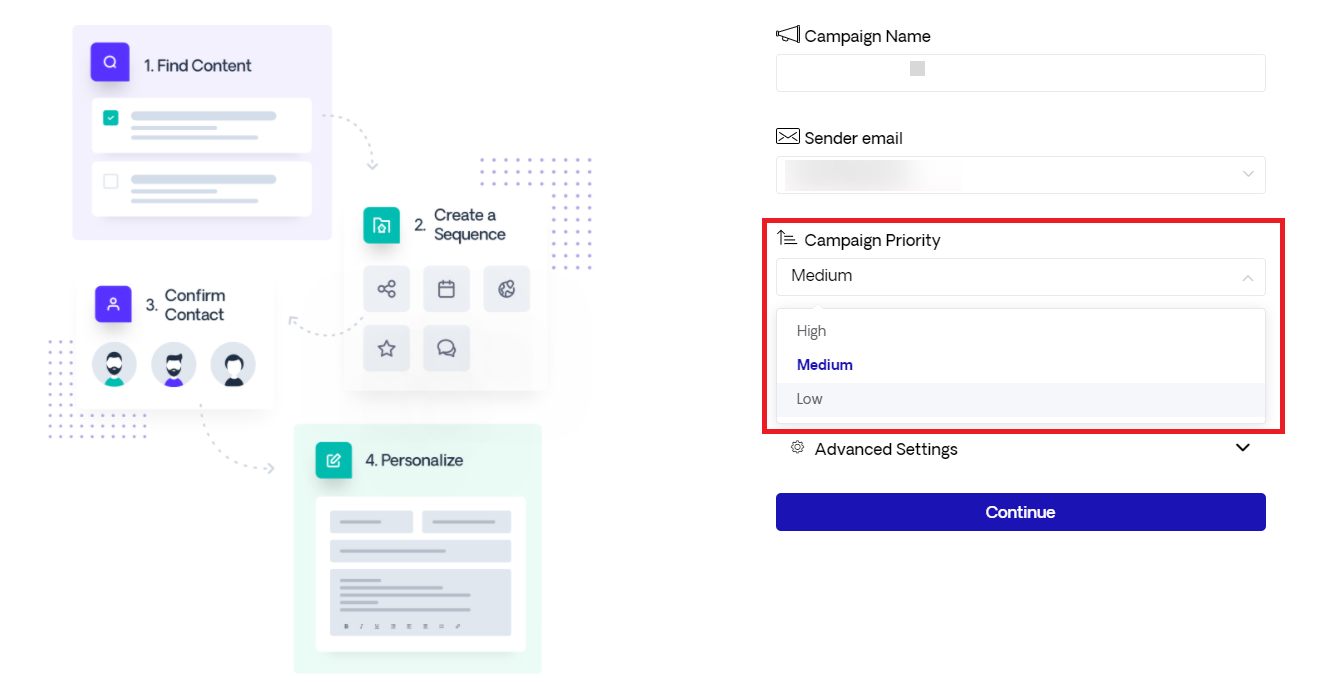

Then, we also make use of Respona’s advanced campaign settings and define our sending strategy.
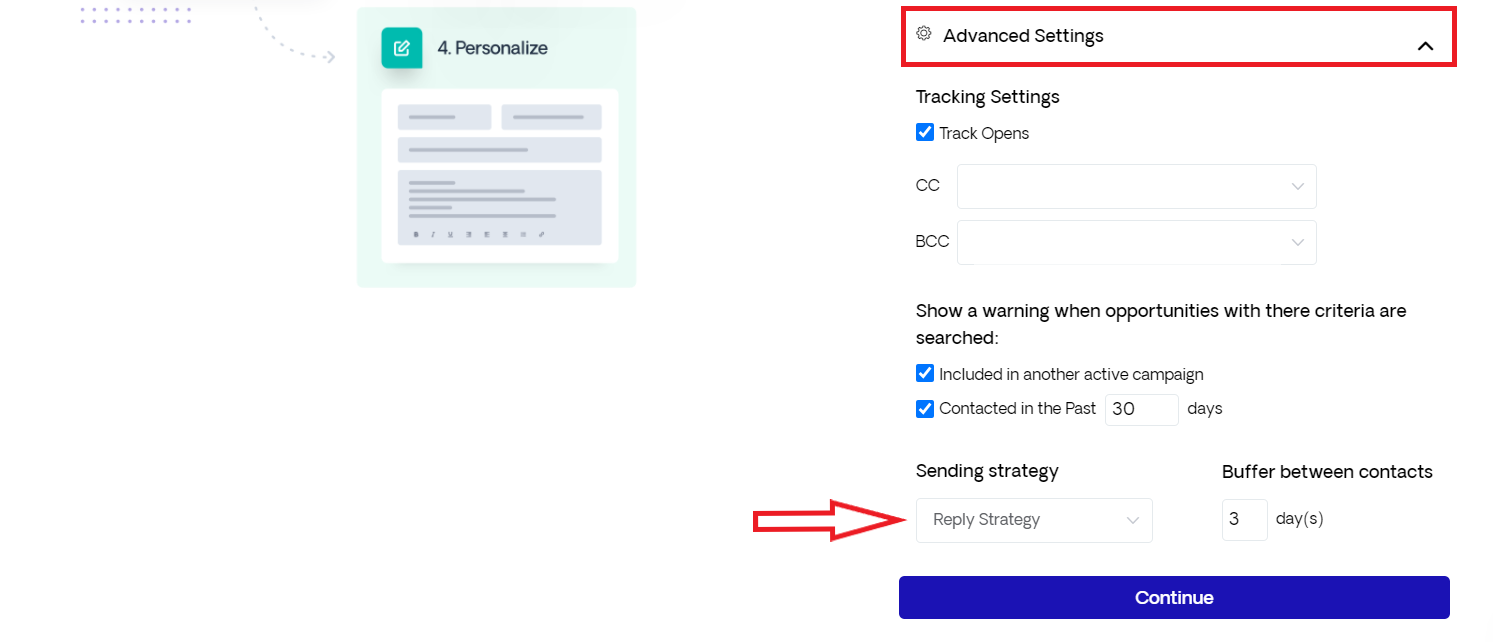

Our search query can be made using either the import button that’s highlighted below or the search bar, or both at the same time.


Our next step is to better define our search by selecting one of the search sources that Respona offers.
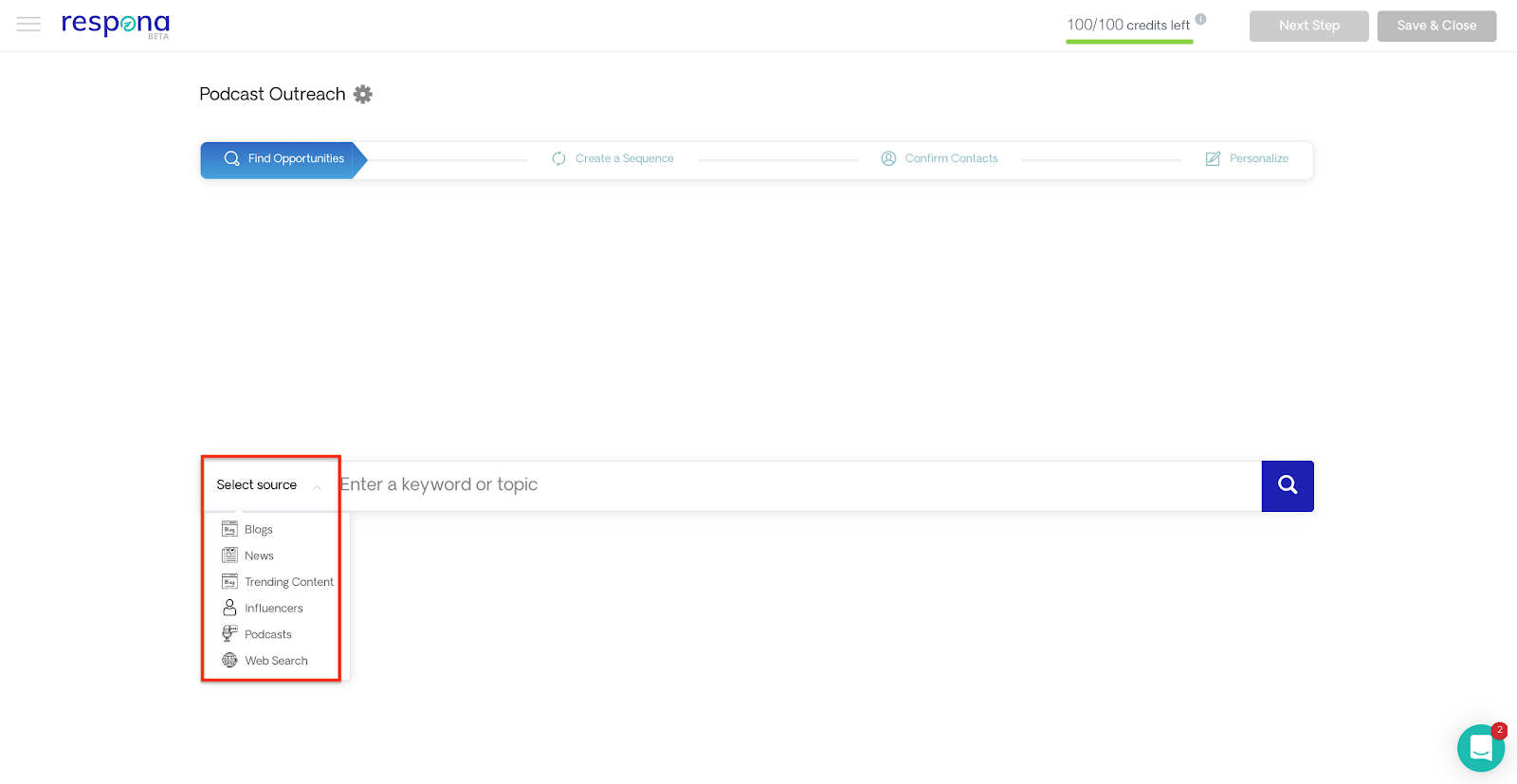

When it comes to podcast outreach, we can get Respona to make our search as specific as possible by selecting the Podcasts source, exactly as we see below:
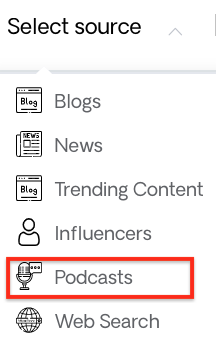

In terms of doing our search for podcast outreach, we can specify our search by adding the SEO keyword and also selecting some of the filters I’m going to show you now.


Respona has lots of different filters options, such as region, freshness, and language options.


For the sake of our example, we’re selecting the United States as the region that we want to focus on.
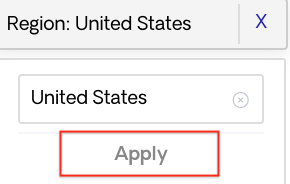

Since we also have the opportunity to add an additional filter, we’ll be selecting one more choice that’ll help us get the results we want.
You can add as many filters as you like by pressing the “Add Filter” button.


Our additional filter in this case is going to be “Language”.
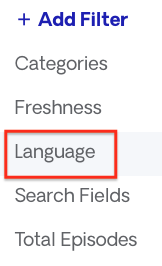

We’re looking for podcasts from the United States in English.
We press “Apply” and out filters are now set.


Overall, filters can help us save valuable time and assist us in defining our search in the best way possible.
Have a look at how the filters we’ve applied will look, down in the search bar.


A great feature is that with Respona you can actually search for either shows or episodes.
That means that you’re able to find specific episodes that match your search outreach and use them later when personalizing your cold emails.


For this search, we’re flipping the search to Episodes and then look up a competing company in our niche, or an influencer.


For example, we’re looking for podcasts that have mentioned or had as a guest Backlinko’s Brian Dean.


To get recent results that are relevant to our search, we can add another filter.
That is, the “Freshness” filter.
Author’s Note: In general, you can experiment with the Respona filters and find the one that’ll help you get the best results.
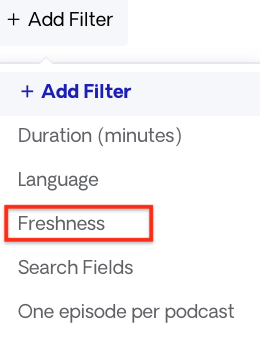

We specifically set our freshness filter to be the past six months.
At this point, you can select any of the choices you feel that applies most to your campaign.
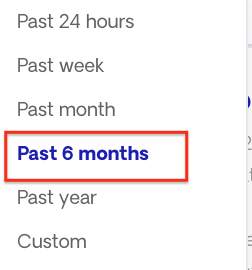

You simply click on the “Apply” button.
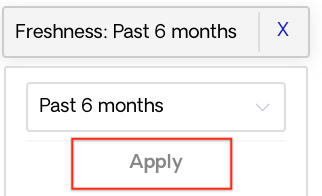

Again, here’s how our search query might look before you press the search button on the right.


After we’ve done our search, Respona gets us ten results.
We can now select the ones that we’re interested in.
As you can see, we’ve selected all the podcast opportunities.
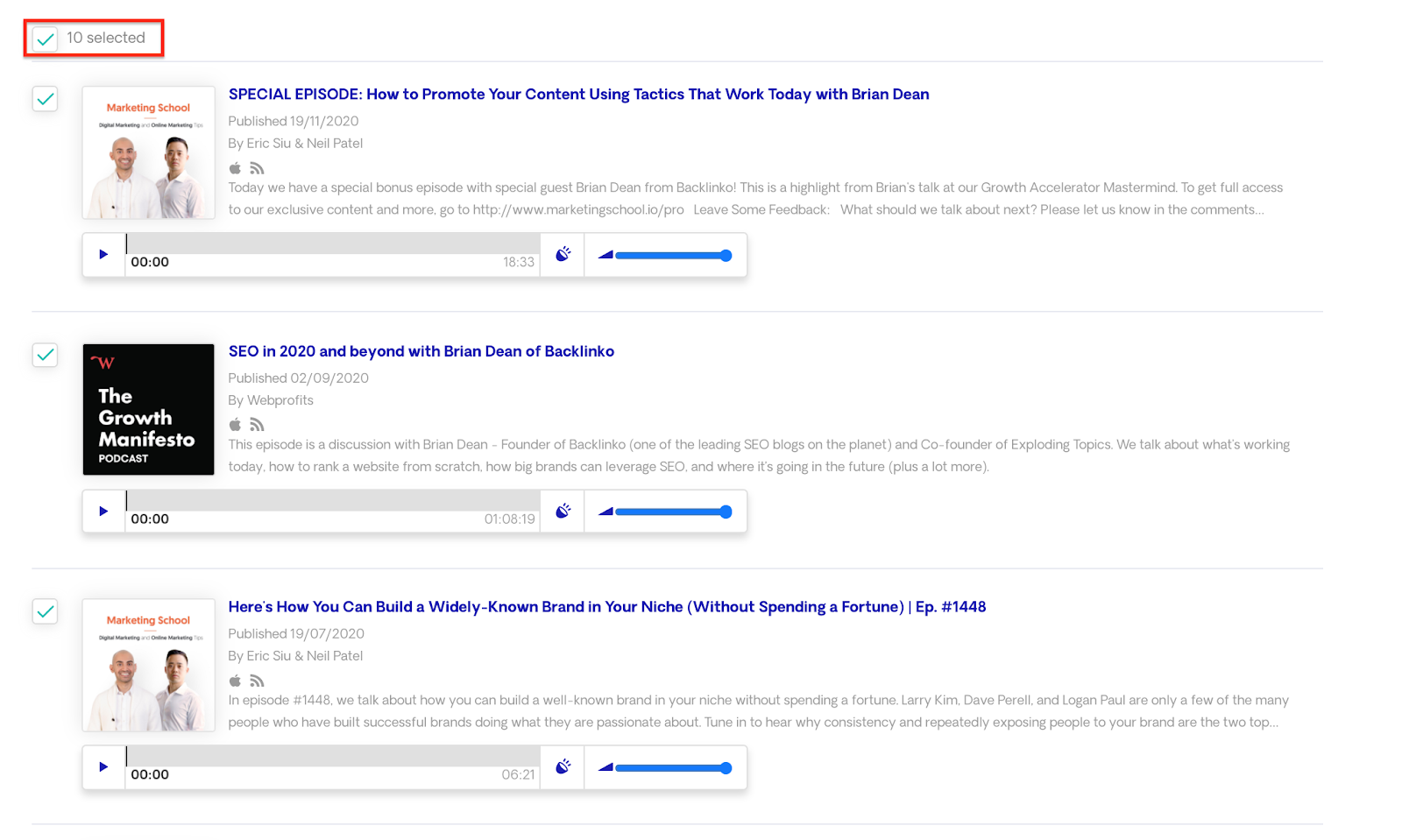

We can now move on to the next step.


Like we’ve seen in the tactics we discussed further up in this post, Respona gives us access to a number of outreach templates.
As you might have guessed already, we’re using the Podcast template for this campaign.
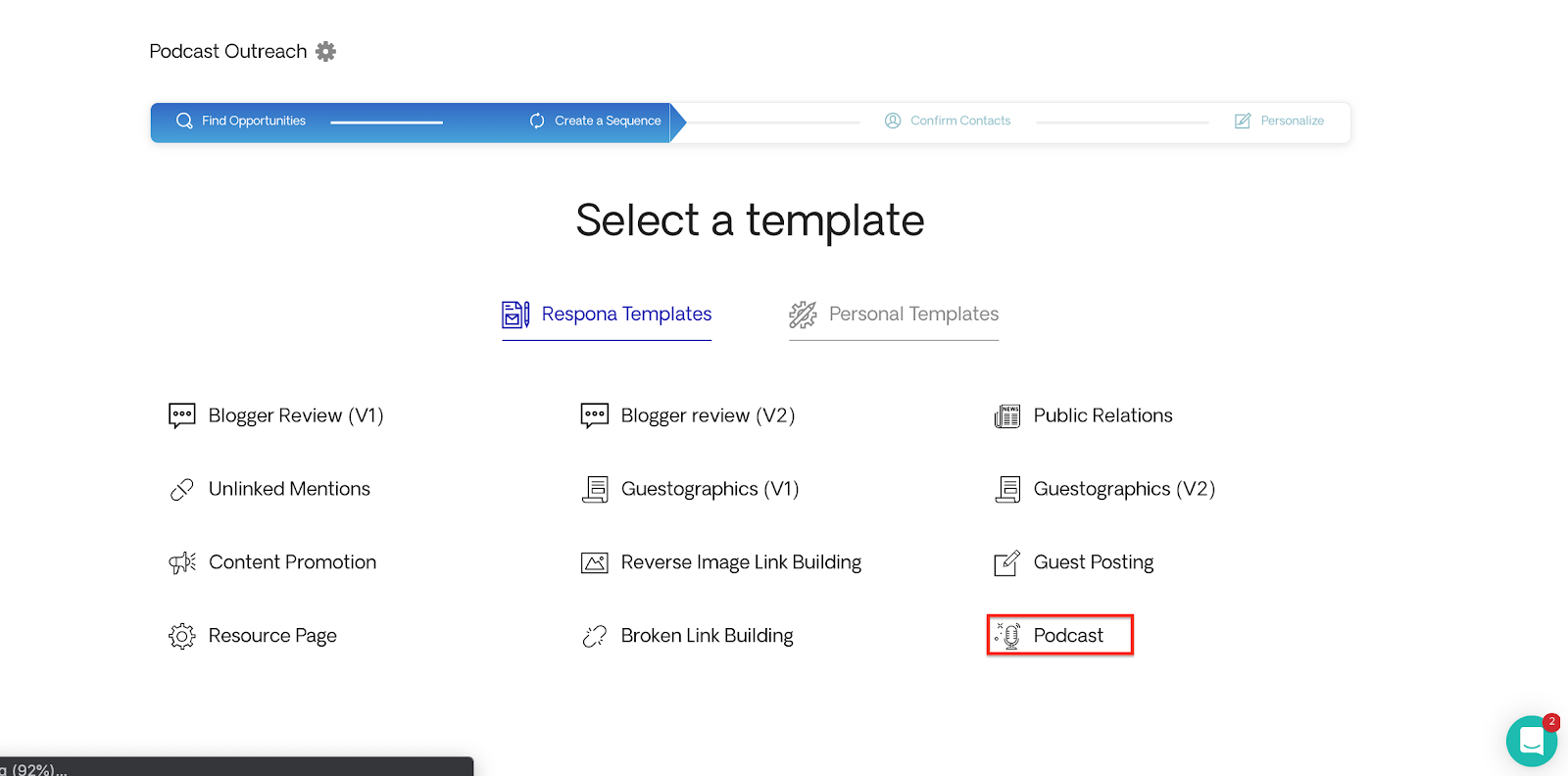

We can then have a look at the templates by clicking on them.
Your template will most likely look like this:
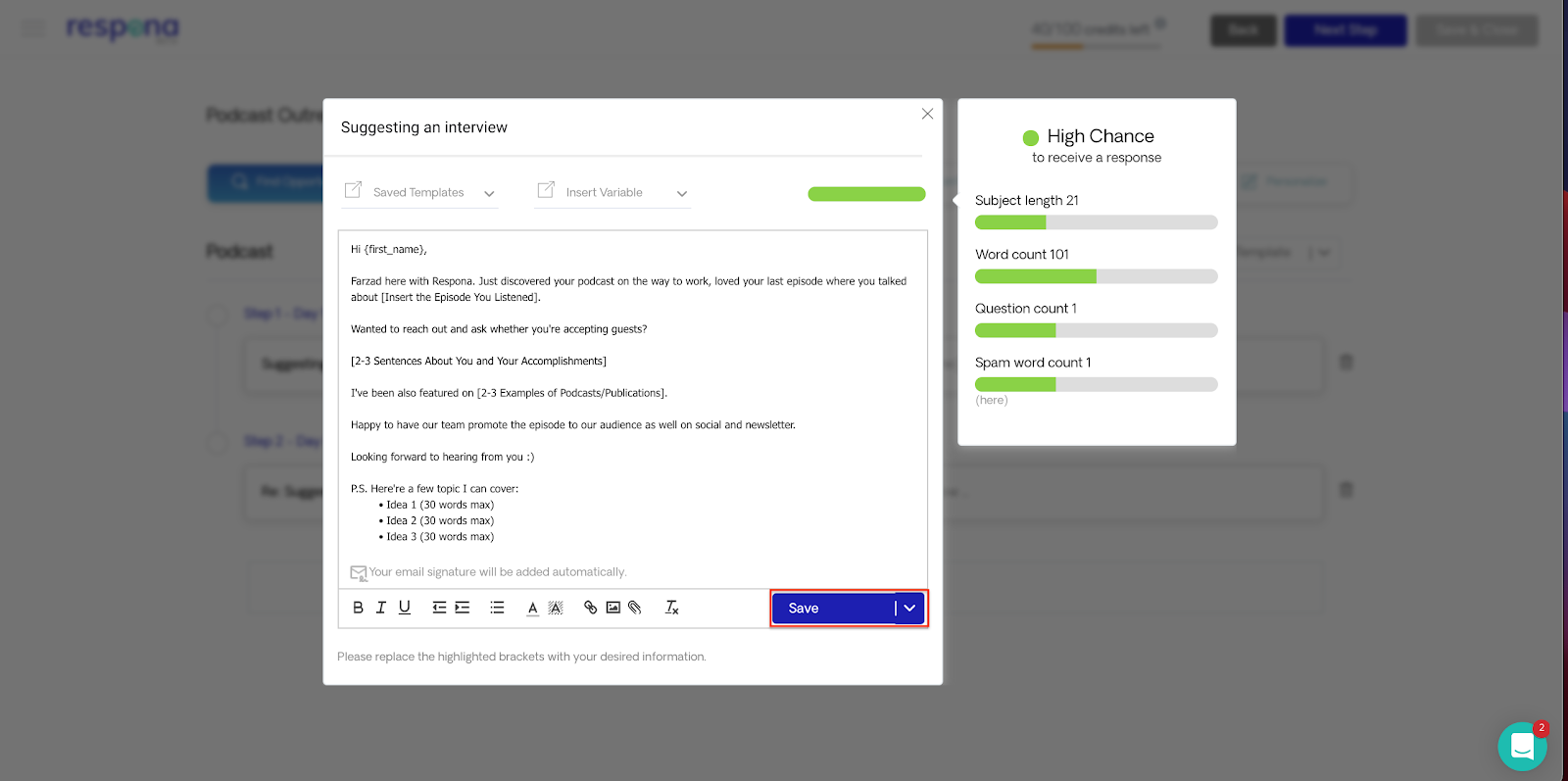

As you can see, the Respona podcast template has great chances of getting a response.
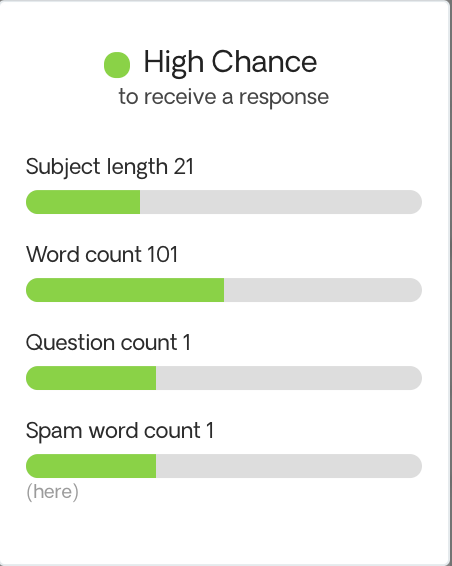

All in all, our podcast email sequence has two emails, the initial one and a follow-up and looks like this:
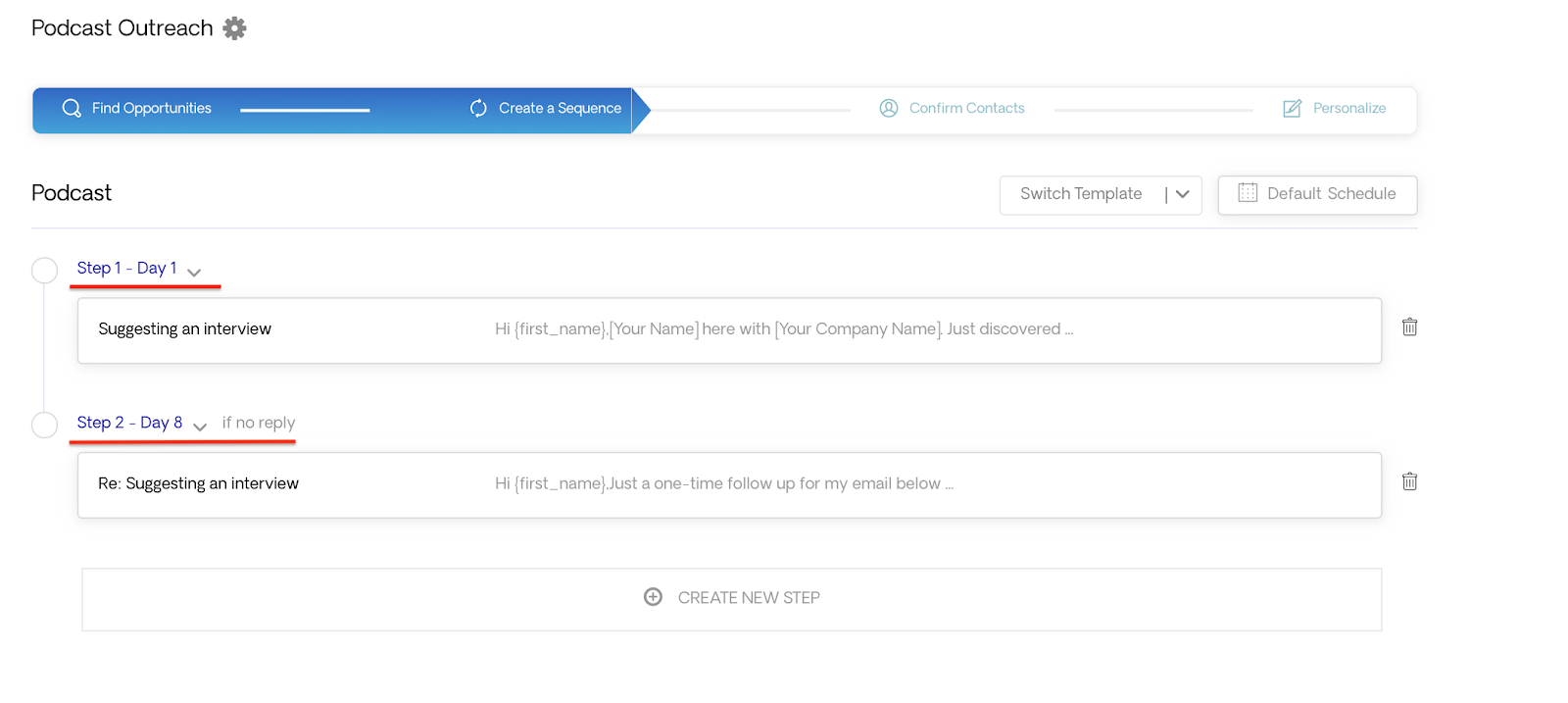

Here’s our follow-up email in more detail:


Once we’re finished with our email sequence, we can move on to the next exciting step of the process that’ll bring us one step closer to launching our campaign.


Before we get to personalize our opportunities, we need to do our automation setup.
This will give Respona instructions about whether it should assign opportunities to other authors of URLs.
We’re going for the second option, that is to assign opportunities only to authors that work for the company we’re reaching out to.
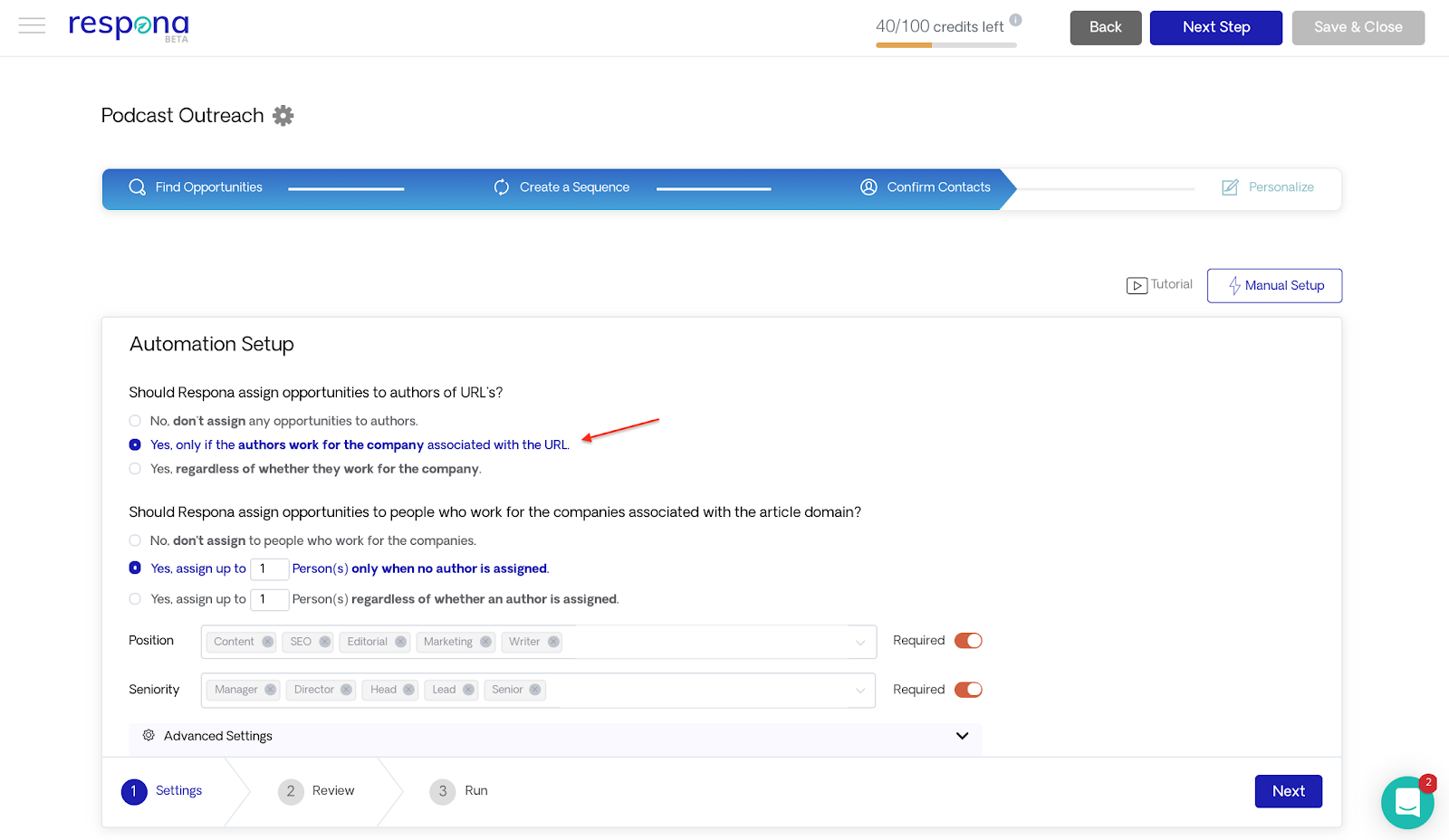

We’re also setting up Respona to assign the opportunities to up to two people.


Like we did earlier with the two previous tactics we’ve discussed, we’re defining seniority as well as positions of the people we’re going to reach out to.
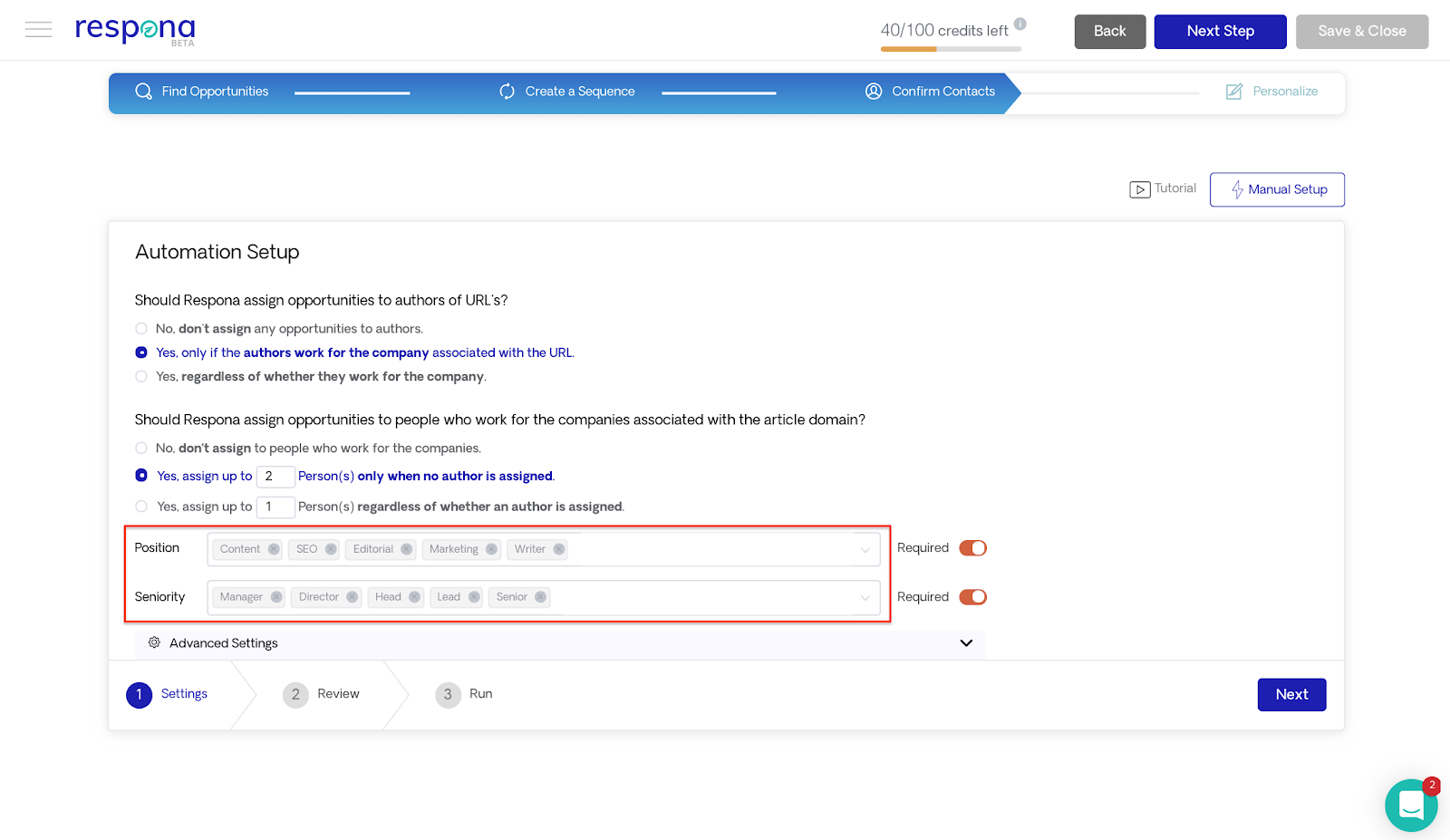

Before we move forward, we can review our choices and then simply click on “Next”.
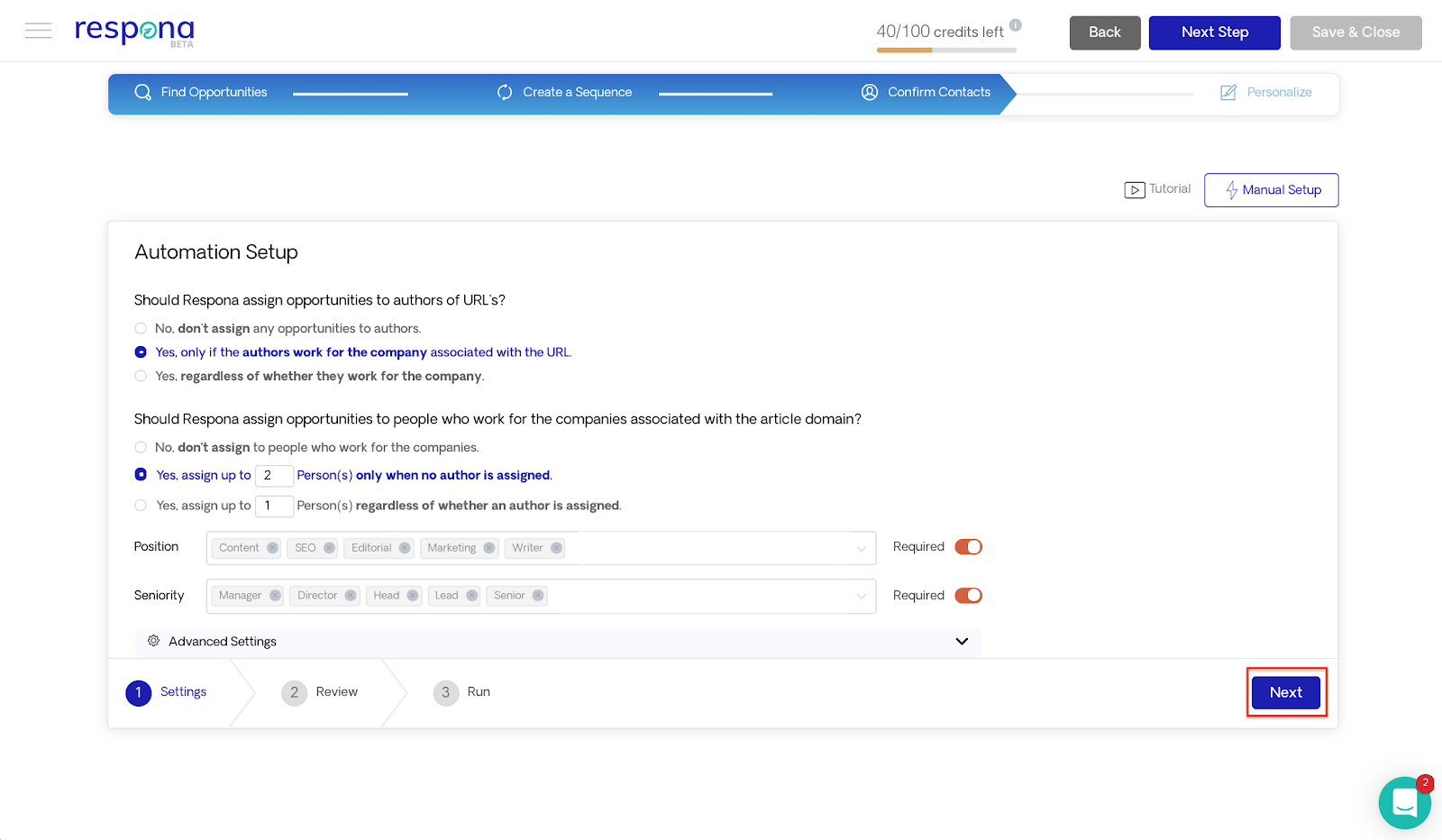

Our next step takes us to this page:
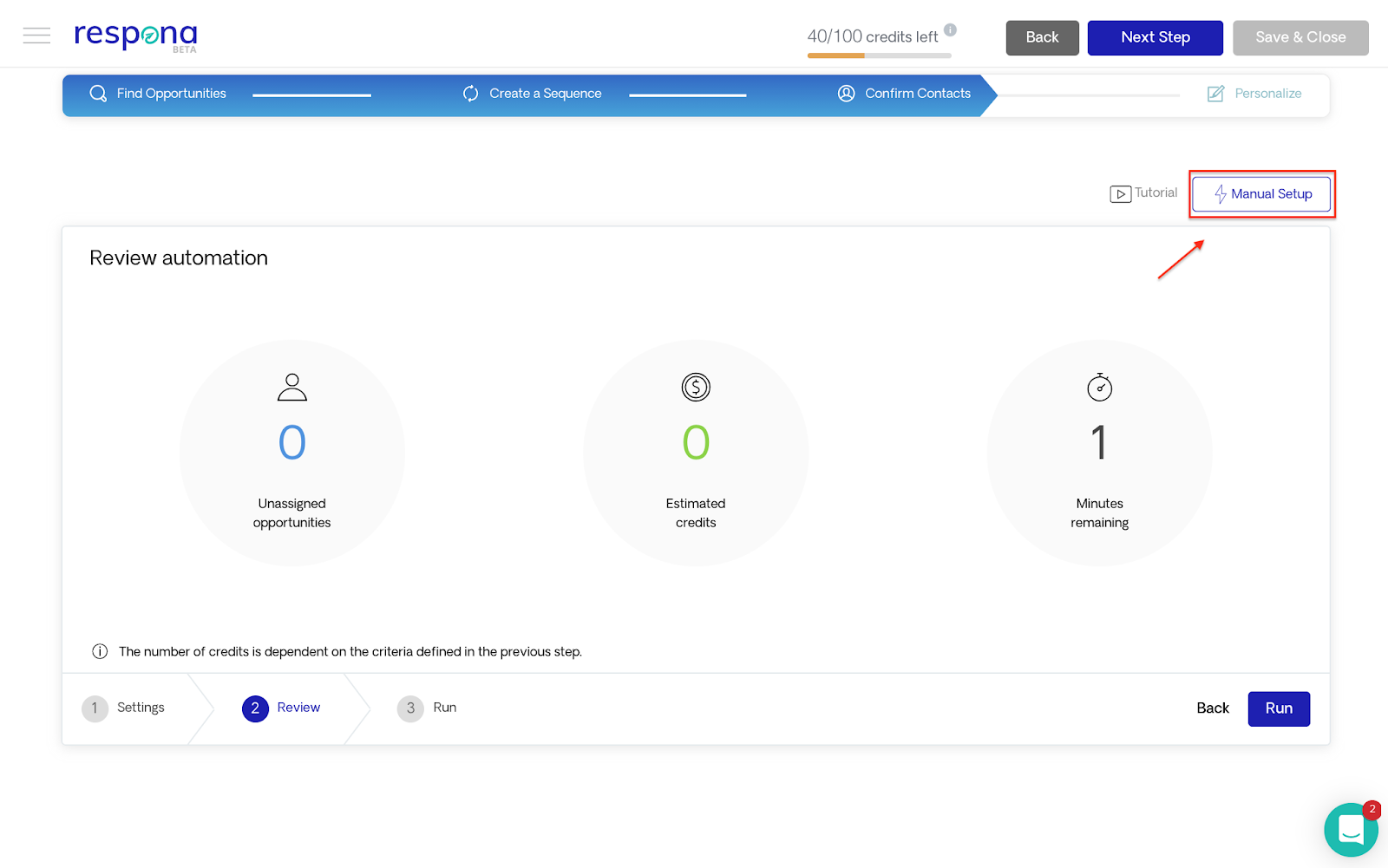

As you can see, there are no unassigned opportunities.
This basically means that all opportunities have been automatically assigned to people.
That’s great, because we won’t have to spend any credits in the process.
Moreover, we’ll be saving time!
Before we run the automation process, we press the “Manual Setup” button.
We’re doing so because we’re still reviewing our opportunities.
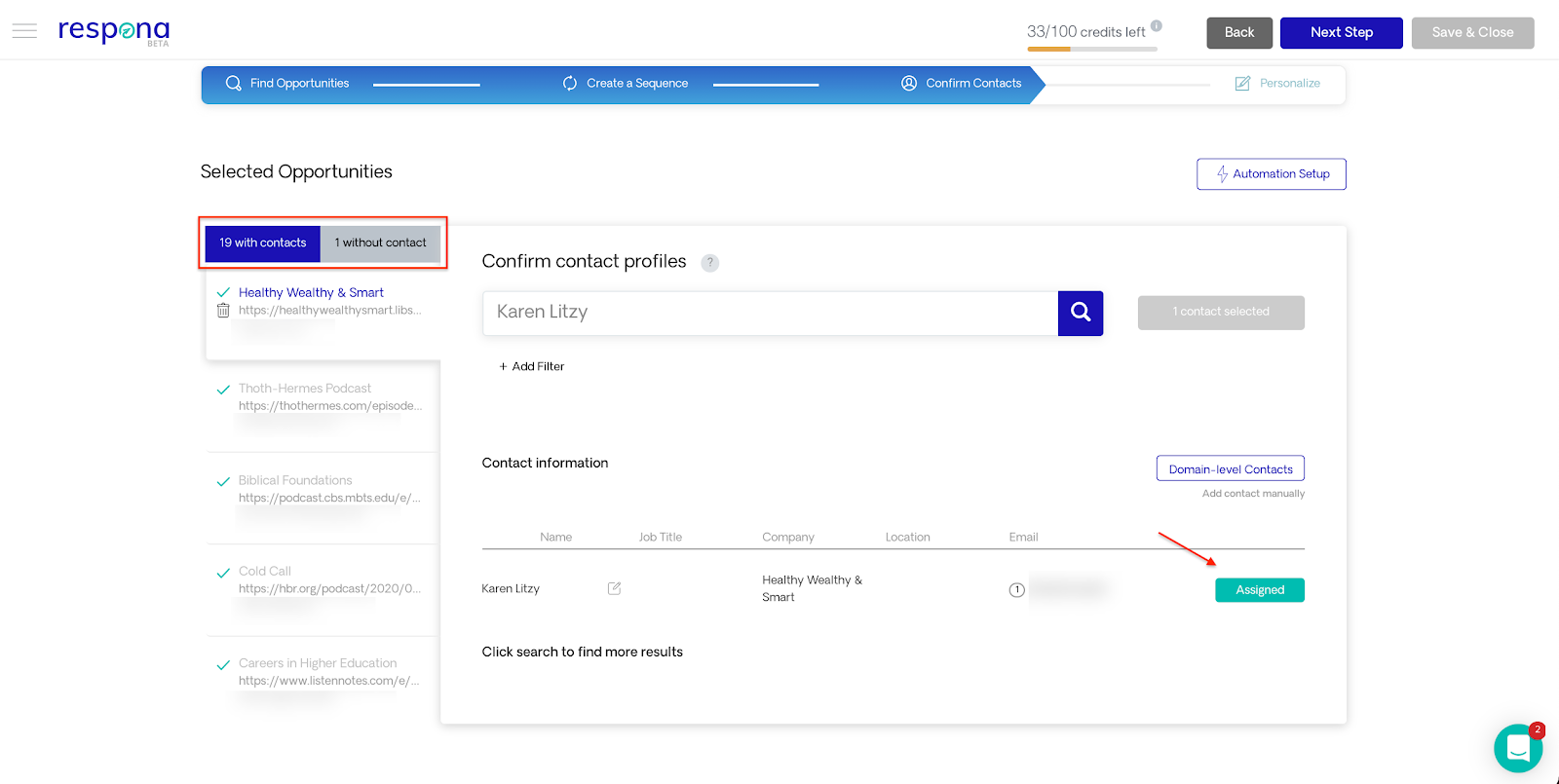

As we can see, our opportunities have already been assigned and we’re now ready to get to the next step.


In the next step, we’re personalizing our pitch.
This is a very important part of our outreach campaign.
As we’ve mentioned a little further up, you can review the type and amount of contact information Respona finds for your prospects and start personalizing your pitch accordingly.
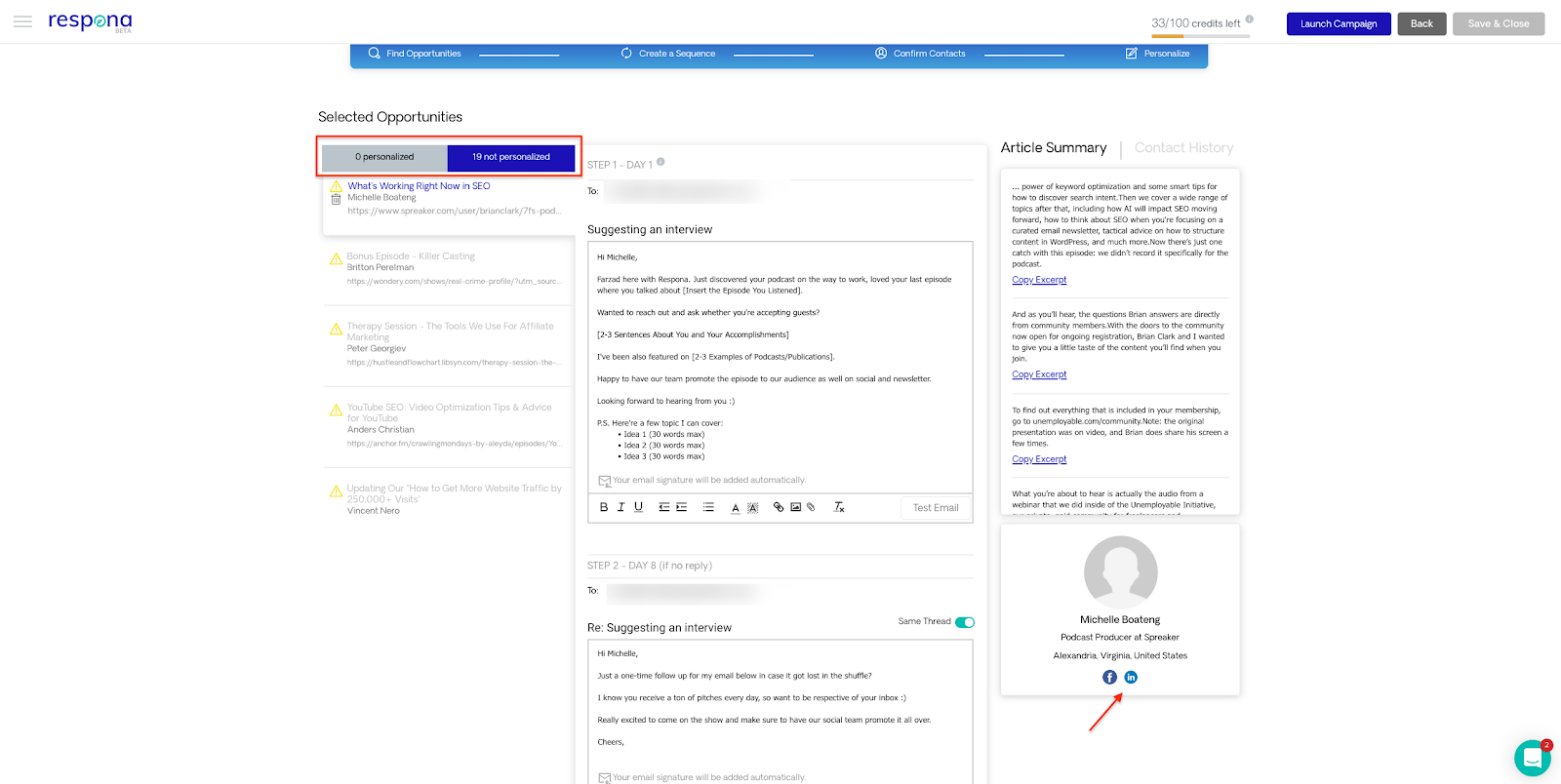

We use the excerpts that Respona has found to replace the variables inside our outreach emails and craft a nice, personalized first email.
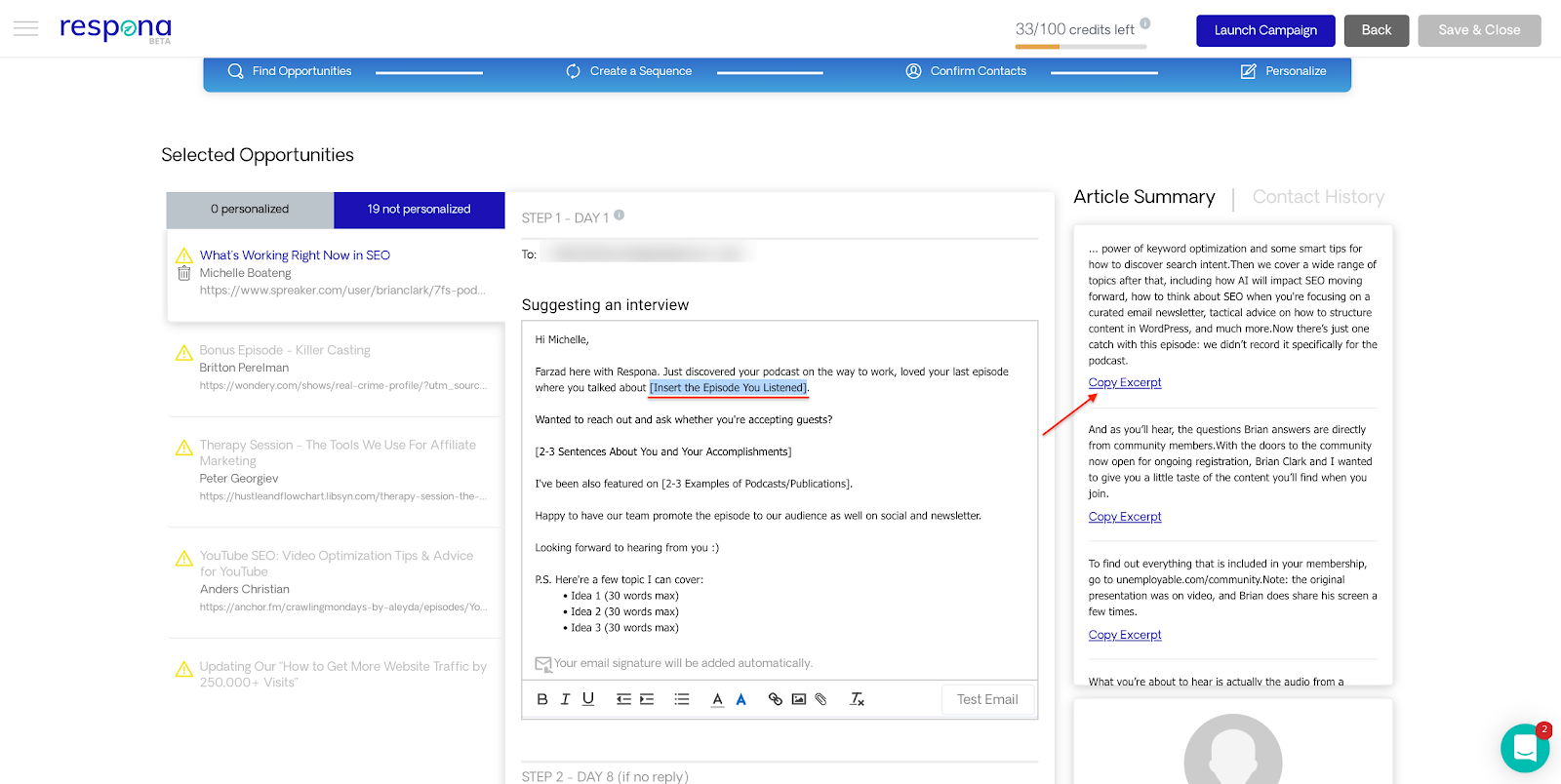

We’re doing so by clicking on the “Copy Excerpt” blue link and then pasting it in where the variable is.


Once we’re done with this, we can see that Respona has taken the opportunity to the other side, where the personalized opportunities can be found.
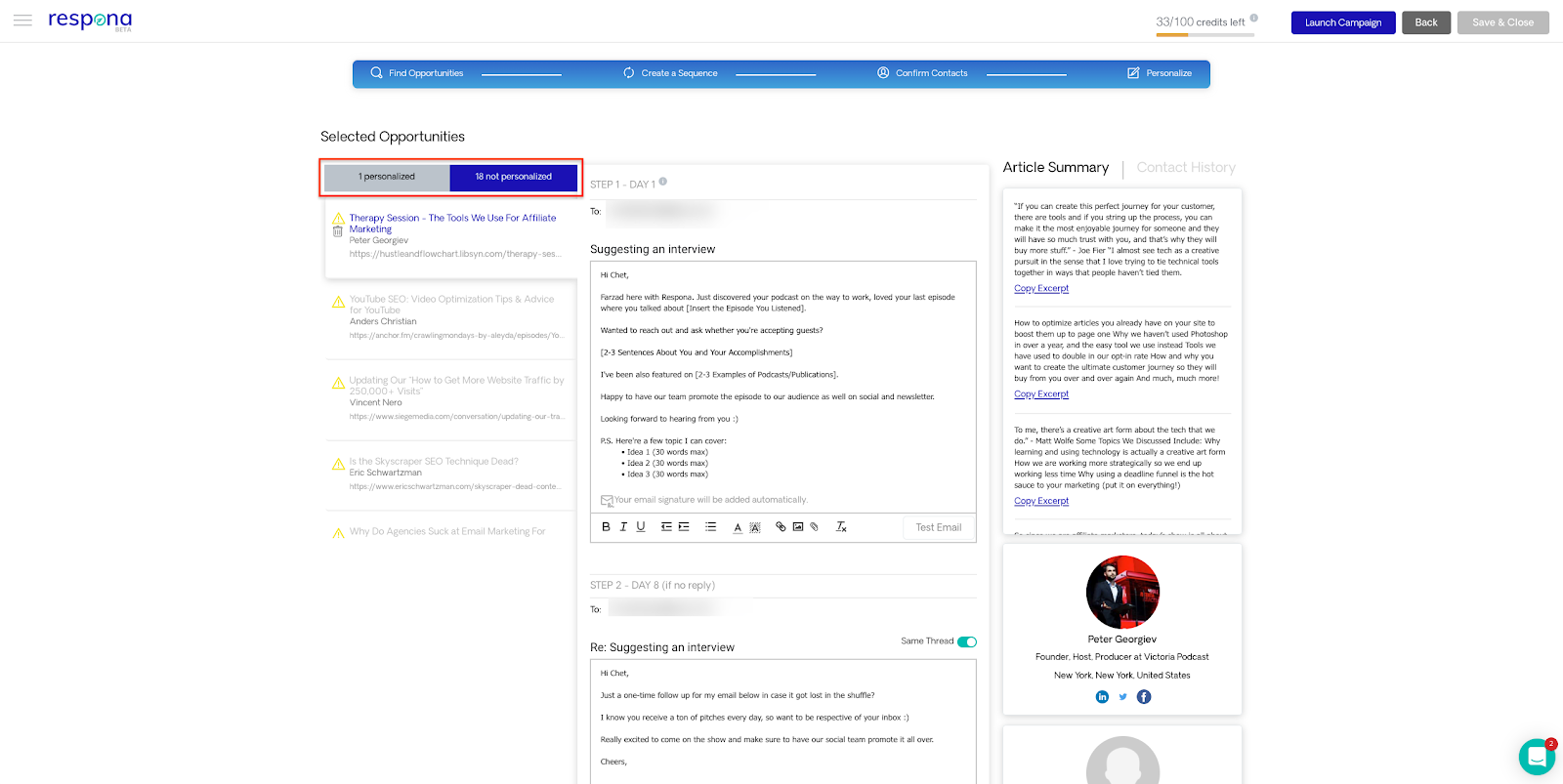

After we’ve completed all steps and crafted our podcast outreach emails the way we should, we can take the final step.


Our final step, as we can see above, is to launch our campaign and wait for great things to happen from our well-structured outreach campaign.
Let’s wrap this up and close with some final thoughts.
By now, you should have realized that there are various ways to do white hat link building for your website.
Not only that, but those ways are interesting and even fun, too.
They can help you establish relationships with likeminded people and expand your network within your niche or vertical.
If you’re ready to start using any of the tactics discussed above, then you should give Respona a try.
Our modern link building software works like a charm for link builders who want to enhance their link acquisition efforts though white hat link building tactics.
Request a demo and we’ll show you how Respona can help you acquire high-quality backlinks.
No spam, no BS, unsubscribe at any time.